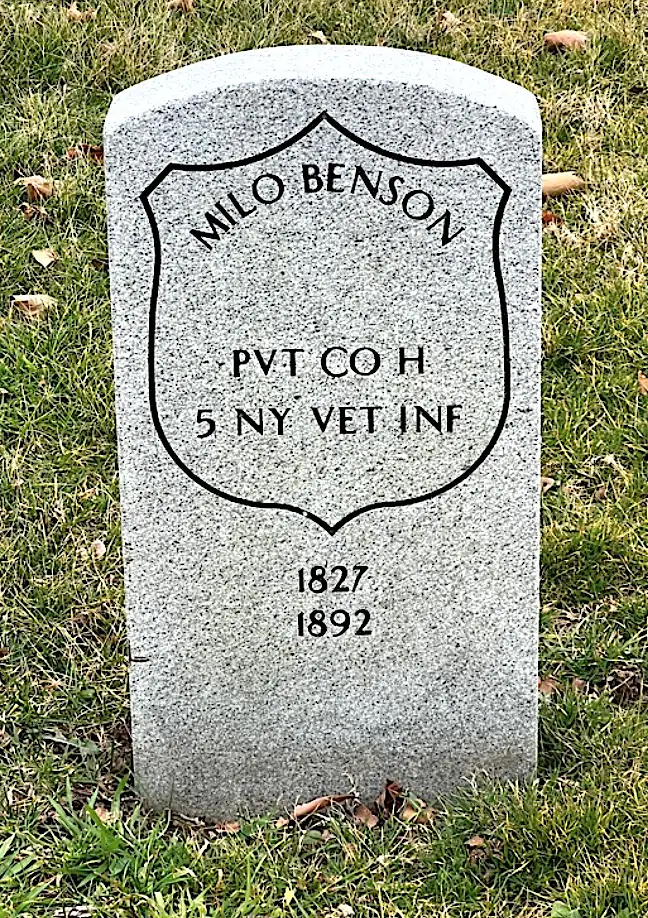BAKER, BENJAMIN F. (1842-1901). Private, 102nd New York Infantry Company C. A native of Long Island, New York, Baker enlisted as a private and mustered into his company on December 4, 1861, at Camp Hillhouse, New York. On July 18, 1864, he was listed as absent for sickness. He was absent when his company mustered out on July 21, 1865, at Alexandria, Virginia.
Baker’s application for an invalid pension was approved in 1892, certificate 360,471. The 1900 census listed him as employed as a driver. His last residence was 546 Hart Street in Brooklyn. After his death from Bright’s disease in 1901, Cornelia Baker applied for and received a widow’s pension, certificate 540, 978. Section 135, lot 14964, grave 996.
Civil War Bio Search
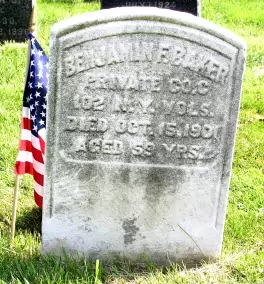
BAKER, BENJAMIN T. (1816-1890). Sergeant, 1st New York Engineers, Company H; quartermaster, United States Navy. A New York City native, Baker enlisted as a corporal on January 22, 1862, and mustered into the 1st New York Engineers. He was promoted to sergeant on April 30, 1862, and mustered out at Folly Island, South Carolina, on July 3, 1863, citing paralysis of the legs and other disabilities. According to his affidavit of April 17, 1888, in which he requested an increase in his $24 a month pension (certificate 4,091), he re-enlisted in June 1864 as a quartermaster in the United States Navy and served on the torpedo boat Spuyten Duyvil. That vessel was in Norfolk, Virginia, in December 1864, and was part of the campaign to secure Richmond, Virginia. He swore that he lived aboard that vessel for five months during the winter of 1864-1865 without a berth to sleep on. Water was always dripping on the deck making it impossible to get a foothold on the deck. He wrote, “…Our clothing was constantly saturated with water, and we had no place to go in order to change, as everything we had was below and wet before we put it on. We took our meals on the Onondaga, a double-turreted monitor which lay about fifty yards from us; we had no further privileges on the monitor. Our lives at this time were in great peril and we suffered more than words can describe.” Baker went on to say that he contracted bronchitis, suffered for two months, had no resting place other than the wet sandbags or dripping wet torpedo box below, and after spending two additional months in a hospital, was discharged. Although he was not expected to survive the journey to New York, he did so, with chronic bronchitis, was unable to work, and was dependent upon his daughter, a widow.
His widowed daughter, Wihelmina Saville, wrote that his disabling condition stemmed from government neglect to provide proper accommodations on the Spuyten Duyvil, under the command of Captain John Lay. Her father had frequent coughing bouts, lung hemorrhages, was frail like a skeleton, and needed to be revived with stimulants very often. She implored that his service in both the Army and Navy deserved special consideration. In addition, she was responsible for the care of both parents and an invalid sister. His pension record indicates service on the USS Kensington, USS Onondaga, and USS North Carolina but the details related to that service are unknown. He last lived at 920 14th Street NW in Washington, D.C. Shortly after his death from lung edema, Maria Baker applied for and received a widow’s pension of $30 per month from the Navy, certificate 4,766. Section 163, lot 14565.
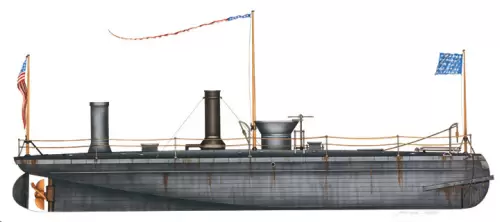
BAKER (or BECKER), CARL (or KARL) R. (1843-1898). Private, 82nd New York Infantry, Company E. Baker, a native of Medford, Massachusetts, enlisted at New York City on March 8, 1864, mustered into the 82nd that day, and deserted on May 29, 1864. His last address was 44 Washington Avenue in Brooklyn. He died from heart disease. Section 108, lot 4526.
BAKER, CHARLES (1844-1912). First lieutenant, 173rd New York Infantry, Company C. Of English birth, he enlisted at Brooklyn as a private on September 2, 1862, and mustered into the 173rd New York on October 30, 1862. During his service, he received many promotions and was wounded in action twice. In 1863, he became a corporal on May 1, was wounded at Port Hudson, Louisiana, on June 14, and was promoted to sergeant on September 1. In 1864, Baker was wounded in battle on April 23 at Cane River Crossing, Louisiana, and was promoted to second lieutenant on May 4, but did not muster in at that rank. In 1865, he was promoted to first sergeant on March 1, to first lieutenant on May 26 (but not mustered), and mustered out on October 18, at Savannah, Georgia. At the time of his death from cirrhosis, he lived on Midwood Street in Brooklyn. Section 6, lot 33758, grave 2.
BAKER, EDWARD E. (1837-1888). Private, 13th Regiment, New York State National Guard, Company G. Born in Peekskill, New York, he enlisted at Brooklyn on May 28, 1862, mustered into the 13th New York, served three months, and mustered out at Brooklyn on September 12. He last resided at 119 West 130th Street in Manhattan. His death was attributed to pneumonia. Section 186, lot 18432.
BAKER, GEORGE M. (1842-1864). Private, 5th New York Infantry, Company C; 146th New York Infantry, Company G. At the time of his enlistment on April 25, 1861, he was a teamster who was 5′ 5″ with brown hair and brown eyes. He deserted on February 2, 1862, at Camp Federal Hill in Baltimore, Maryland, and was arrested on December 1, 1863. Subsequently, he was transferred to the 146th Infantry on May 4, 1863. The next day, he suffered a gunshot wound to the shoulder and collarbone at the Battle of Wilderness, Virginia, and succumbed on June 4, 1864, at Alexandria, Virginia. Interment at Green-Wood took place on November 14, 1864. Section 14, lot 9877.
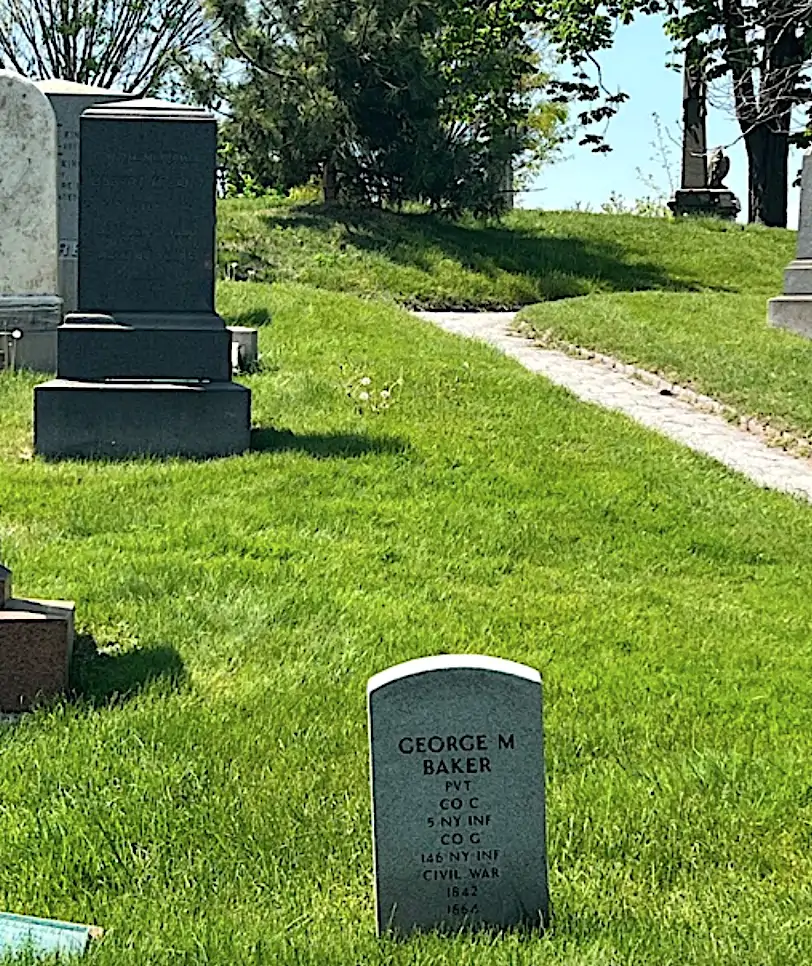
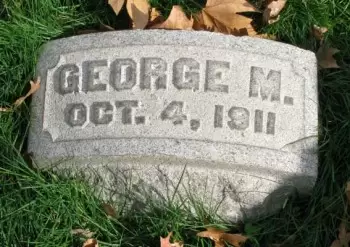
BAKER, GEORGE McL. (or G. M.) (1846-1911). Private, 102nd Regiment, New York State National Guard, Company A; yeoman, United States Navy. Baker, who was born in Sag Harbor, Long Island, served for 100 days with the 102nd Regiment in 1864. Pension records indicate that he was also a yeoman on the USS Gemsbok. The Gemsbok was used as a gunboat and store-ship during the Civil War; it is unclear when Baker served aboard that vessel.
Baker received a pension from the Navy, certificate 40,169. He last lived at 699 Putnam Avenue in Brooklyn. He died from heart disease. In 1911, his widow applied for and received a pension from the Army, certificate 734,340. (The pension number for his widow was the same on the Army and Navy records.) Section 137, lot 29235.
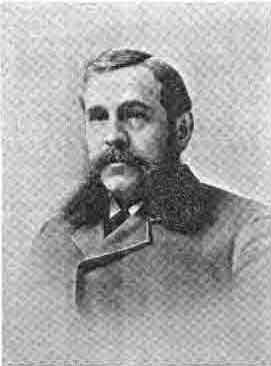
BAKER, GEORGE W. (1837-1898). Assistant surgeon, Union Medical Corps. A native of Herkimer County, New York, he graduated from Union College with high honors in 1862, and received his medical degree from the College of Physicians and Surgeons in 1864. He then served at Fort McHenry, Maryland, for a short time before he was assigned as an assistant surgeon at the Army Hospital at Washington, D.C., where he was stationed through 1865.
Baker then lived in Brooklyn where he was a prominent physician. In 1866, he was a member of the first metropolitan board of health and served as its chief inspector. In addition, he was the medical examiner for the New York Life Insurance Company for twenty years. Active in professional organizations, he belonged to the Kings County, New York and American Medical Associations. In civilian life, he was a Republican and a member of the Hanover and Windsor clubs. He last lived at 540 Bedford Avenue. Dr. Baker died from pneumonia. Section 51, lot 8090.
BAKER, JAMES MIFFIN (1840-1908). Quartermaster sergeant, 90th Pennsylvania Infantry, Company I; private, 19th Pennsylvania Infantry, Company C. Originally from Philadelphia, Pennsylvania, Baker enlisted there on April 27, 1861, and mustered into Company C of the 19th Pennsylvania Infantry on May 18. He mustered out at Philadelphia on August 29, 1861. He re-enlisted as a private at Philadelphia on September 30, 1861, and immediately mustered into Company I of the 90th Pennsylvania. Further details are unknown but his pension index reports that he was a quartermaster sergeant in that regiment (8th Joint Service Command).
At the time of the census of 1900, Baker was a painter, married and living with his father-in-law. In 1904, he applied for and received a pension, certificate 1,084,431. As per his obituary in the Brooklyn Daily Eagle, he was a member of Cushing Post #231 of the G.A.R., the First Reformed Church and the Logan Club. He last lived at 511 Sixth Avenue in Brooklyn. In 1916, Louise Baker, who is interred with him, applied for and received a widow’s pension, certificate 825,522. Section 135, lot 14964, grave 771.
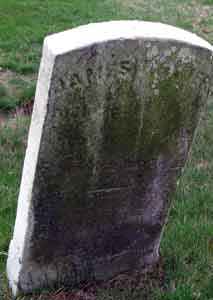
BAKER, JAMES T. (1829-1868). Major and lieutenant colonel by brevet; captain, 174th New York, Company E; first lieutenant, 65th New York Infantry, Company B; private, 7th Regiment, New York State Militia, Company H. A native of New York, he enlisted at New York City as a private on April 19, 1861, mustered into the 7th Regiment that day, and mustered out with his company on June 3. Shortly thereafter, he re-enlisted at New York City as a first lieutenant on June 20, 1861, was commissioned into the 65th on August 3, 1861, and was discharged for disability on July 1, 1862. Returning to service on October 31, 1862, he re-enlisted as a private at New York City, mustered into the 174th New York the next week on November 6, rose to the rank of captain, and was discharged on July 13, 1863. He was brevetted to major and lieutenant colonel “for valuable and meritorious services during the War to date from March 13, 1865.” He died of consumption at Milwaukee, Wisconsin. Section 36, lot 3800.
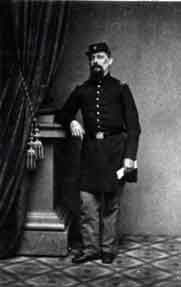
BAKER, JOHN ABBOTT (1812-1862). First lieutenant and ordnance officer, 7th Regiment, New York State Militia. A native of New York, Baker settled in New York City in 1838 where he was harness and saddle maker until 1851. He then founded an enterprise that manufactured and imported military goods and equipment. That business, which advertised that items could be furnished on short notice such as caps, swords, sashes, horse equipment, was located at 53 Walker Street in New York City as of 1859.
During the Civil War, Baker enlisted at New York City as a first lieutenant on April 17, 1861, mustered into the 7th Regiment, and was commissioned into the Field and Staff as a first lieutenant and ordnance officer. He mustered out after 30 days on June 3 at New York City. While he was serving in uniform, his business continued to fulfill contracts for the Union Army including contracts for cartridge boxes. Although he did not muster in with his regiment when it was called to service in 1862, he joined the regiment at Fort Federal Hill, Maryland, and died there of heart failure on June 12, 1862.
The following account of his death appeared in the Baltimore Clipper: Sudden death of an officer, Lieut. J. A. Baker, ordnance officer of the Seventh New York Infantry, stationed at Fort Federal Hill, died quite suddenly yesterday morning about two o’clock, The deceased was a popular officer with the command and on Thursday evening was present at dress parade. Afterwards he made several visits in the city in company with Sergt. Major Winans Arthur, returned to the Fort and whilst riding in a carriage, he breathed his last. The remains were conveyed yesterday afternoon to the depot of the Philadelphia, Wilmington and Baltimore Railroad en route to New York, the escort consisting of Company Two, Capt. Clarke commanding. Col. Marshall Lefferts and Lieut. Col. Price accompanied the remains to the depot.
His last residence was 53 West 15th Street in Manhattan. After his death from heart failure, his widow, Laura Sherwood Baker (see), took over his business and retained some interest in it until 1871. Section 172, lot 13432.
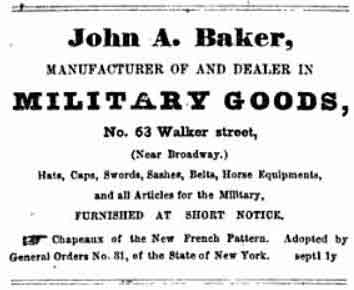
BAKER, JOHN LOCKWOOD (1844-1913). Corporal, 83rd New York Infantry, Company H. Born in Sag Harbor, Long Island, he enlisted as a private and immediately mustered in at New York City on June 10, 1861. During his service, he was promoted to corporal on or about April 15, 1863, and wounded in battle on May 6, 1864, at Wilderness, Virginia. On June 23, 1864, he mustered out at New York City.
In 1886, Baker applied for and was granted an invalid pension, certificate 1,125,369. He became a member of Brooklyn’s Ulysses S. Grant Post #327 of the G.A.R. in 1889. At the time of his death from angina, he resided on Surf Avenue in Sea Gate, Brooklyn. Belle Baker applied for and received a widow’s pension in 1916, certificate 810,556. Section 137, lot 29235, grave 1.
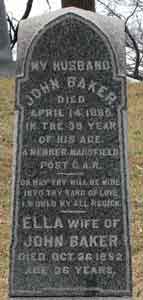
BAKER, JOHN T. (1846-1885). Drummer, 162nd New York Infantry, Companies A and I. Baker was born in Ireland, and at the age of 16 enlisted on September 1, 1862, at New York City, as a private. After mustering into Company A of his regiment on September 18, he was promoted to drummer on October 18. On January 16, 1864, he transferred intra-regimentally from Company A to Company I. Baker mustered out on October 12, 1865, at Savannah, Georgia.
Baker was a member of the Mansfield Post #35 of the G.A.R. He last resided at 247 Hooper Street in Brooklyn, New York. He died from heart disease. In 1890, Ella W. Baker, who is interred with him, applied for and received a widow’s pension, certificate 323,513. In 1912, an application for a minor’s pension was filed under application 990,440 but there is no certificate number. Section 65, lot 11076.
BAKER, JOHN W. (1842-1910). Private, 40th New York Infantry, Company F. He enlisted at Yonkers, New York, on June 16, 1861, mustered into the 40th the same day, and was discharged for disability on January 16, 1864, at Convalescent Camp. In 1879, he applied for and received an invalid pension, certificate 177,927. Baker last resided at 22 Cooper Street in Brooklyn. His widow, Georgianna Baker, received a pension after his death from heart disease in 1910, certificate 703,750. Section 178, lot 12610.
BAKER, JOSEPH A. (1819-1869). Private, 4th New York Heavy Artillery, Battery A. Born in New York, Baker enlisted at the age of 42 as a private at Port Richmond, New York, on December, 16, 1861, mustered into the 4th Heavy Artillery on that date, and was discharged on December 10, 1862, at Fort Ethan Allen, Virginia. He last lived at 141 Grand Avenue in Brooklyn. Baker died from typhoid fever. Section 91, lot 925.

BAKER, LAURA SHERWOOD (1835-1914). Manufacturer of Civil War equipment including Union uniforms, headgear and accoutrements. Laura Sherwood Baker was born in New York. Her husband, John Abbott Baker (see), began the business of manufacturing military headgear in the early 1840s. In 1859, it was located at 63 Walker Street in Manhattan. While serving in the Union Army, John Baker died from heart failure on June 12, 1862. Laura Baker then took over her husband’s business. Her mark, L. S. Baker, appears on federal cartridge boxes for the .58 caliber rifled musket (of which 15,000 were ordered in 1862 for Union Army). In addition, her mark appears on federal percussion cap boxes.
Laura Sherwood Baker’s business was listed under her name from 1862-1864 at which time she sold the enterprise to James McKenney and the firm was renamed Baker & McKenney. After moving to a new address at 141 Grand Street, they were awarded a contract from the Union Army on September 17, 1864, for 10,000 sets of infantry accoutrements. In 1871, she withdrew her interest in the company. She last lived at 50 South Munn Avenue in East Orange, New Jersey. Her cause of death was cerebral arteriosclerosis. The business, renamed Ridabock & Company in 1888, after a bankruptcy, remained in business until about 1940. Section 172, lot 13432.
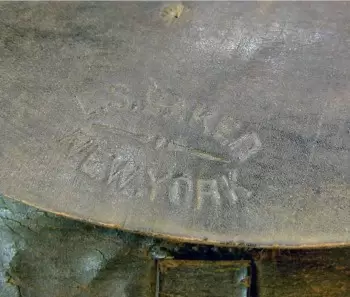
BAKER, LEWIS (1839-1865). Private, 164th New York Infantry, Company E. Born in New York City, Baker enlisted as a private at Brooklyn on August 19, 1862, mustered into the 164th the next day, and deserted on October 1 of that year. He last lived on Downing Street in Manhattan. Section 57, lot 2415.
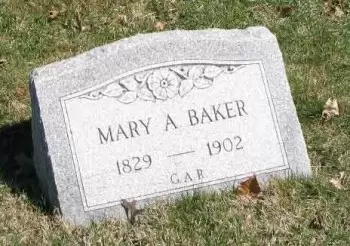
BAKER, MARY ANN (1829-1902). Possible connection to the Grand Army of the Republic (G.A.R.). Born in Nova Scotia, Canada, Mary Ann Baker immigrated to the United States in 1835. G.A.R., which may be a reference to the Grand Army of the Republic, an organization for Civil War veterans, is carved into her tombstone. However, her connection to the G.A.R. is unknown. She was the widow of Benjamin Baker, a fisherman, as per entries in the New York City Directories of 1865, 1868, 1879 and 1889. Benjamin Baker is not buried in the same lot making it difficult to trace the possible soldier history of a man with such a common name. Mary Baker was employed as a matron at the New York City House of Detention on Mulberry Street. She last lived at 142 East Houston Street in Manhattan. Baker died from a fractured femur. Section 135, lot 14964, grave 665.
BALCH, CHARLES L. (1841-1872). Private, 83rd New York Infantry, Company L. Born in Rhode Island, he enlisted as a private on September 10, 1861, and mustered into the 83rd New York that same day. Further details of his service are unknown. His death a suicide, he last lived at 51 East 85th Street in Manhattan. Section 23, lot 9221.
BALDWIN, CHARLES E. (1840-1921). Sergeant, 12th Regiment, New York State Militia, Company H. In 1861, he enlisted as a private for a tour of three months and served in Company H of the 12th Regiment. In 1862, he re-enlisted as a sergeant for another three months and served with the same regiment and company, now part of the New York State National Guard. Baldwin applied for and received a pension in 1904, certificate 1,098,057. His last residence was 151 Cauldwell Avenue in the Bronx. Section 78, lot 10301, grave 1.
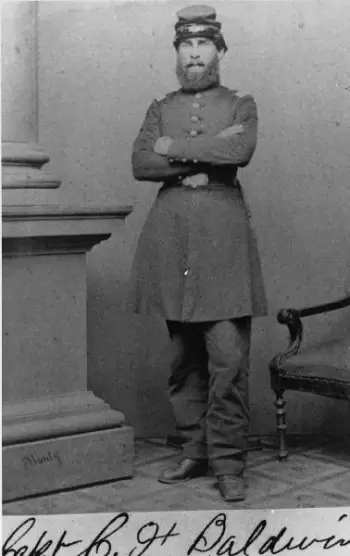
BALDWIN, CHARLES F. (1836-1912). Major, 84th New York (14th Brooklyn) Infantry, Company D. A Brooklyn native, he joined the 14th in 1851. He enlisted there as a captain on May 18, 1861, and was commissioned five days later into the 14th. He was wounded at First Bull Run, Virginia, and at Groveton, Virginia (Second Bull Run), on August 29, 1862, promoted to major on October 1, 1862, and was discharged for disability resulting from his wounds on December 24, 1862.
Baldwin then worked for many years in New York City’s Finance Department. He was the last 14th Regiment officer who served in the Civil War to die. He was a member of the Fourteenth Regiment War Veterans Association, the Devin Post #148 of the G.A.R., and an organization for ex-officers of the Civil War. While ill, he was struck by a trolley car, and died soon thereafter. As per his obituary in the New York Tribune, which referred to him as Major Baldwin, his funeral took place at the home of his son, Joseph Baldwin, at 10 Woodruff Avenue in Brooklyn. Section 206, lot 32747, grave 2.
BALDWIN, CLARENCE A. (1840-1879). Quartermaster sergeant, 6th New York Cavalry. Baldwin enlisted as a quartermaster sergeant on September 15, 1861, at New York City. One month later, on October 15, he mustered into the 6th New York Cavalry, Field and Staff. He was discharged on November 1, 1862. Baldwin last resided in New York City at 16 West Street. His death was attributed to nephritis. Section 10, lot 13324.
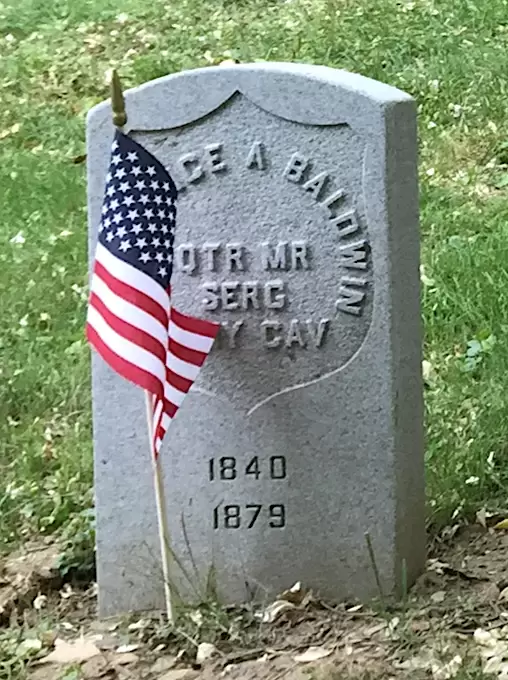
BALDWIN, HENRY (1827-1910). First lieutenant, 145th New York Infantry, Companies B and F. After he enlisted at New York City as a private on August 14, 1862, Baldwin, who was born in New York, quickly rose through the ranks. Upon being mustered into Company B of the 145th New York on September 11, 1862, he was promoted to quartermaster sergeant and transferred to the Field and Staff. On January 21, 1863, he was promoted to second lieutenant effective upon transferring back to Company B the next month on February 25. On March 11, 1863, he was promoted to first lieutenant effective upon his transfer to Company F on May 29 of that year. He mustered out on January 6, 1864.
In 1893, Baldwin applied for and received an invalid pension, certificate 902,872. He last lived in Red Bank, New Jersey, where he succumbed to prostate disease. Mary A. Baldwin applied for and received a widow’s pension in 1921, certificate 951,996. Section 45, lot 20440.
BALDWIN, JOHN H. (1844-1921). Private, 13th Regiment, New York State National Guard, Company E. A native New Yorker, he enlisted there on May 28, 1862, immediately mustered into the 13th New York, and mustered out at Brooklyn on September 12 of that year. In 1906, he applied for and received an invalid pension, certificate 1,121,912. He last resided on Tompkins Avenue in Brooklyn where he died from nephritis. Section 145, lot 26559.
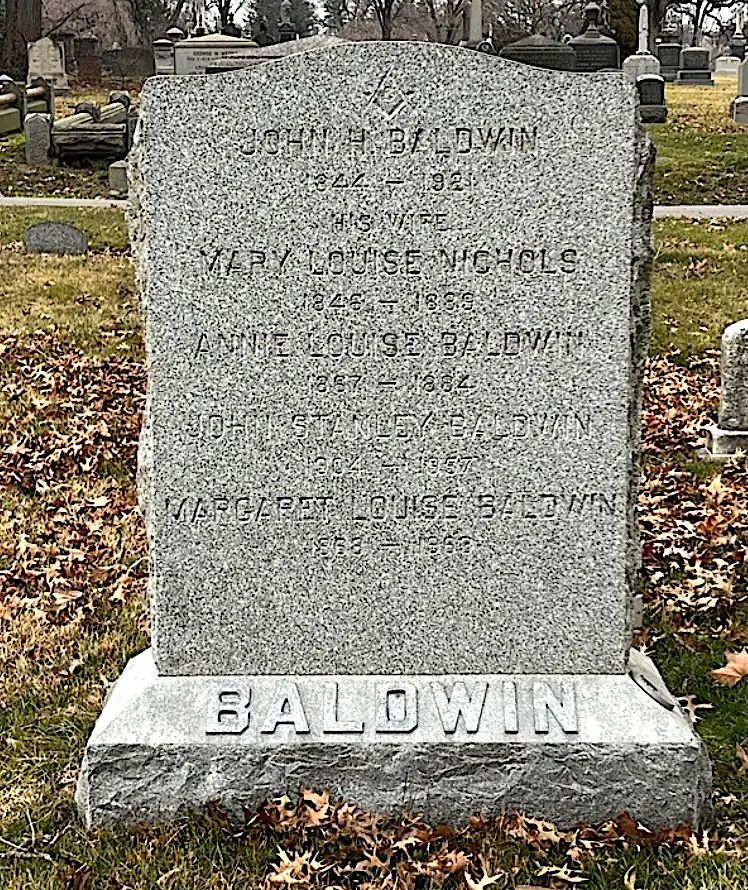
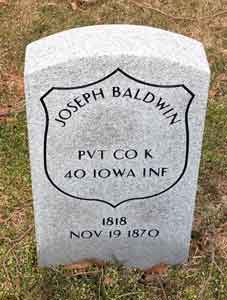
BALDWIN, JOSEPH (1818-1870). Private, 40th Iowa Infantry, Company K. Buried in Green-Wood’s Soldiers’ Lot, this may be the Joseph Baldwin who was born in Ireland and lived in Vinton, Iowa, at the time of his enrollment. He enlisted at age 44 as a private on August 16, 1862, mustered into the 40th Iowa on November 3 of that year, and was discharged for disability at Snyder’s Bluff, Mississippi, on July 21, 1863. He last resided on Harrison Street in Brooklyn. Section 115, lot 13536 (Soldiers’ Lot), grave 115.
BALDWIN, THOMAS A. (1825-1881). Sergeant, 51st New York Infantry, Company G. Baldwin enlisted at Brooklyn as a private on January 5, 1864, and immediately mustered into the 51st New York. During his service he was promoted to corporal on December 1, 1864, and rose to sergeant on February 1, 1865. He mustered out at Alexandria, Virginia, on July 25, 1865. He last lived in Brooklyn. Baldwin died from tuberculosis. Section 2, lot 5499, grave 187.
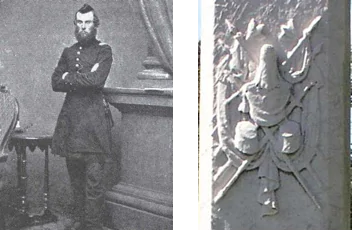
BALDWIN, WILLIAM M. (1832-1878). Captain, 84th New York (14th Brooklyn) Infantry, Company D. According to the 1850 census, Baldwin was a clerk. After enlisting as a second lieutenant at Brooklyn on April 18, 1861, he was commissioned into the 14th on May 23, promoted to first lieutenant on October 11, 1861, and to captain on October 1, 1862. Wounded at Laurel Hill, Virginia, on May 10, 1864, he returned to service and mustered out at New York City on June 6, 1864. On December 27, 1864, he applied for and received an invalid pension, certificate 38,373. He last resided at 240 9th Street in Brooklyn. Baldwin died from tuberculosis. Section 106, lot 234.
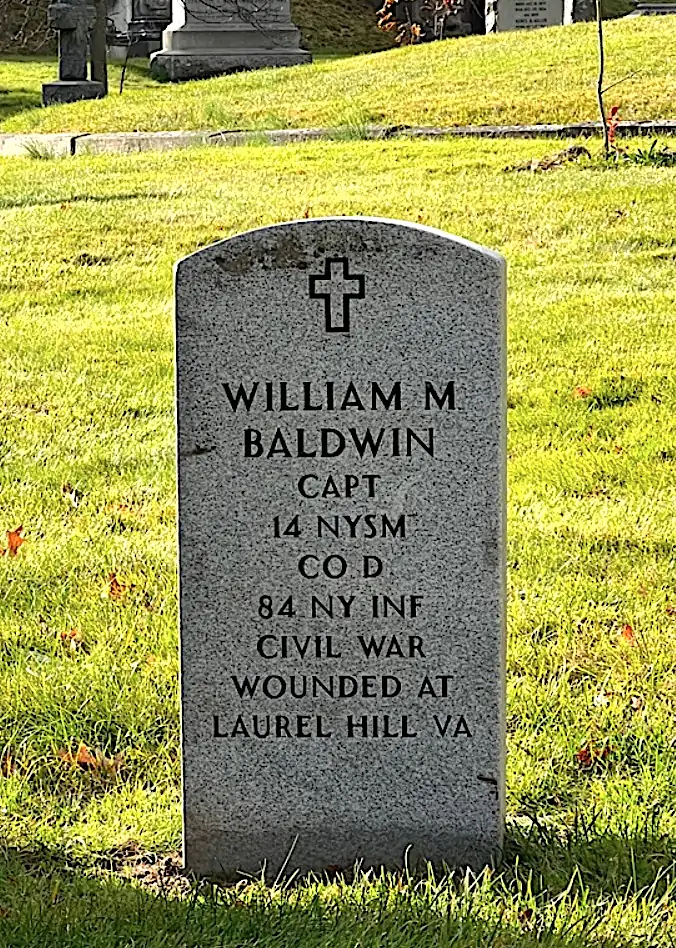
BALEN, JR., PETER J. (1840-1919). Private, 7th Regiment, New York State Militia, Company D. New York City-born, Balen served for 30 days as a private in the 7th Regiment during its activation in 1861. In 1911, he received a pension, certificate 1,165,643. He died from sclerosis at the Home for Incurables in the Bronx. Section 113, lot 16142.
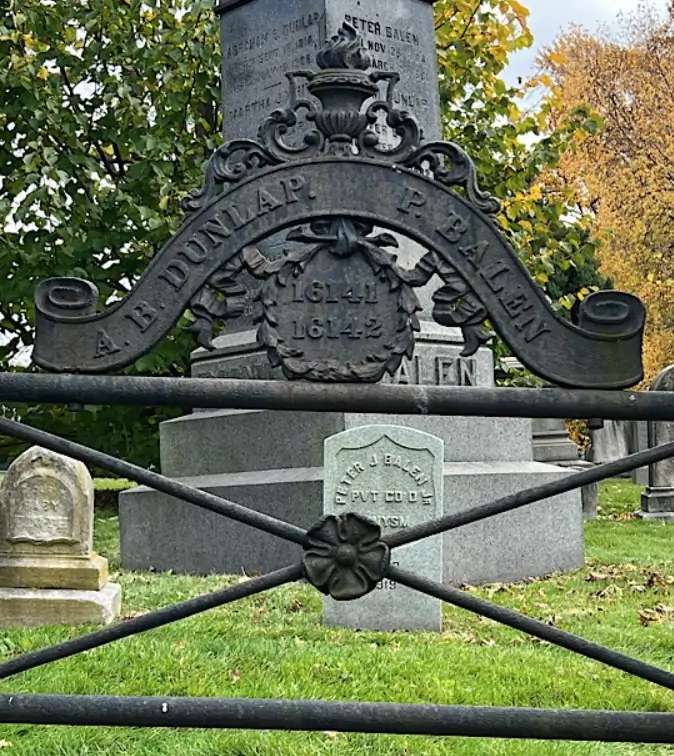
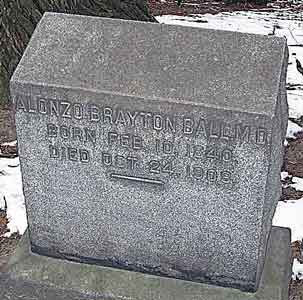
BALL, ALONZO BRAYTON (1840-1908). Contract surgeon, United States Volunteers. Born in New York City and a medical student at Columbia College, he interrupted his studies in May 1862 to enter the service of the United States Sanitary Commission, working in the field during the Peninsular Campaign and in the military hospital at Frederick, Maryland, until February 1863. The Sanitary Commission was created as a private relief agency in 1861 to support sick and wounded soldiers in the United States Army.
Ball then returned home to continue his medical education, graduating from Columbia as class valedictorian in March 1863. From July 1863 to December 1865, he was senior assistant physician at New York Hospital. He resigned to enter private practice. From 1868 to 1870, he was professor of medicine at Women’s Medical College of the New York infirmary (now part of Cornell medical College). He was a lecturer at Columbia College of Physicians and Surgeons from 1870-1876. The New York City Directory for 1876-1878 lists him as a physician; at that time, he lived at 88 West 36th Street. As of 1897, he was a professor of clinical medicine at Columbia.
In addition to teaching, he served as a physician at St. Luke’s, Bellevue, and New York Hospitals. He was an honorary member of the Association of American Physicians, and belonged to numerous medical societies. His last residence was 42 West 36th Street, Manhattan. He died from a cerebral hemorrhage in Boston, Massachusetts. In 1910, Helen S. Ball applied for a widow’s pension, application 936,736, but there is no certificate number. Section 41, lot 4571.
BALL, GRANVILLE (1834-1921). Private, 13th Regiment, New York State Militia, Company B. Originally from Albany, New York, Ball was a laborer as per the 1855 New York State census. At that time, he was living in Schoharie, New York, with his wife and her parents and siblings. As per the Brooklyn Directory for 1857-1862, he was a hatter whose home was on Myrtle Avenue. At the onset of the Civil War, he served as a private with the 13th Regiment when it was activated for three months from April 23, 1861, through August 6, 1861.
The 1863 through 1866 Brooklyn Directories lists Ball as a hatter; the 1865 New York State census indicates that he was living in Brooklyn with his wife and their five children. He is also listed as a hatter in the Brooklyn Directories for 1870-1873 and 1873-1876. The 1880 census notes that he was a hatter as does the Brooklyn Directory for 1884-1886. The Veterans Schedule of 1890 confirms his Civil war service. In 1892, Ball applied for and received an invalid pension, certificate 1,024,803. The 1900 census reports that he was a public watchman.
As per his obituary in the Brooklyn Standard Union, which confirms his Civil War service, he was a member of the Winchester Post #197 of the G.A.R. and the Independent Order of Odd Fellows. Ball last lived at the home of his daughter at 33 Prospect Place in Brooklyn. His death was attributed to apoplexy. Section 128, lot 12807, grave 50.
BALL, GUSTAVE W. (1845-1883). Sergeant, 1st New York Mounted Rifles, Companies H and K; private, 4th New York Provisional Cavalry, Company K. A native New Yorker, he enlisted at New York City as a private on August 12, 1862, and immediately mustered into Company H of the 1st New York Mounted Rifles. On April 18, 1864, he was promoted to corporal, and rose to sergeant on July 10. He re-enlisted in the 1st New York on September 1, 1864, was reduced in rank to private on about January 1, 1865, and transferred to Company K on July 21, 1865. Ball was transferred to Company K of the 4th New York Provisional Cavalry on September 6, 1865, and mustered out on November 29 of that year at City Point, Virginia. His last residence was in Saugerties, New York, where he died from tuberculosis. Section B, lot 8575, grave 739.
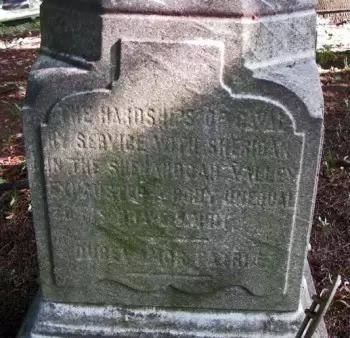
BALL, WILLIAM W. (1842-1867). Private, 8th New York Cavalry, Companies K and F. Born in New York, he enlisted as a private on August 30, 1862, at Caledonia, New York, and immediately mustered into Company K of the 8th Cavalry. Ball was listed as a prisoner of war in Dumfries, Virginia, on March 4, 1863, was released on an unknown date, and transferred to Company F on November 1, 1864. He served in the Union Army’s Cavalry under General Sheridan in the Shenandoah Campaign and mustered out at Alexandria, Virginia, on June 6, 1865.
His elaborate gravestone is inscribed with these words, The Hardships Begotten By Service With Sheridan In The Shenandoah Valley Exhausted A Body Unequal To His Grave Spirit. Ducit Amor Patria. The latter remark is Latin for, “Led by Love of Country.” His last residence was located at 43 West 11th Street in New York City. His death caused by phthisis (tuberculosis) on June 23, 1867, at the age of 25, was likely a result of his wartime experiences and exposure. Section 41, lot 4571.
BALMANNO, ALEXANDER (1830-1902). Private, 71st Regiment, New York State National Guard, Company A; United States Volunteers, Quartermaster Department. Born in Geneva, New York, but a longtime resident of Brooklyn, he was assistant foreman of Engine No. 22 in the Volunteer Fire Department. Balmanno enlisted as a private in 1862 for a period of three months and mustered into Company A of the 71st Regiment. He was also employed by the Quartermaster Department, United States Volunteers, possibly as a teamster.
According to his obituary in the Brooklyn Daily Eagle, Balmanno’s father was a noted Scotch historian; his mother was a gifted Scotch writer and author of Shakespeare’s Heroines and Evenings With Lamb and Hood. Maintaining his interest in his family’s roots, he was a chief of the Caledonian Club and member of the Clan MacDonald. An antiquarian and numismatist, he was a founder of the American Numismatic and Archaeological Society and a collector of ancient coins and Long Island Native American relics. His collection of Greek and Roman coins was purchased by the British Museum.
A builder and contractor, Balmanno was instrumental in developing South Brooklyn (Park Slope South) and enjoyed yachting and other outdoor sports. In 1892, he applied for a pension, application 1,099,202. He last lived at 184 14th Street, Brooklyn. Annie Balmanno, who is interred next to him, applied for a widow’s pension soon after his death from inanition (exhaustion) in 1902, application 756,015. There are no certificate numbers for either application. Section 178, lot 12234, graves 12 and 13.
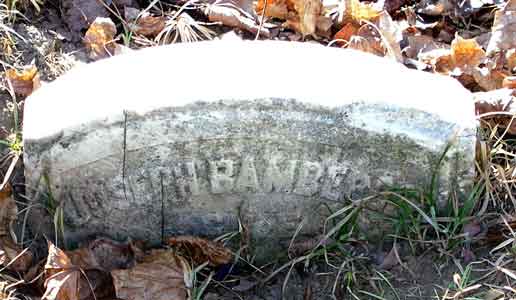
BAMBERGER, JOSEPH (1832-1902). Private, 66th New York Infantry, Company E. Of German origin, he enlisted at New York City on September 28, 1861, and mustered into the 66th New York on November 4, 1861. On September 17, 1862, he was wounded in action at the Battle of Antietam, Maryland, and was moved to Washington, D.C. He was discharged for wounds on January 29, 1863, at the Summit House Hospital in Philadelphia, Pennsylvania. His last residence was 1406 Bergen Street in Brooklyn. Bamberger died from pneumonia. Section 206, lot 21347, grave 15.
BAMPTON, BENJAMIN CHASE (1836-1921). First assistant engineer, United States Navy. A native of New York City, he was educated in the public schools there and was apprenticed as a machinist. Bampton first joined the United States Navy as a third assistant engineer on May 21, 1857, and served on the frigate Mississippi in the East Indies, China and Japan. He rose to second assistant engineer on August 2, 1859, and then became a first assistant engineer on December 17, 1862. In the first two years of the Civil War, he was attached to the sloop-of-war USS Iroquois, then served on the monitor Passaic, the frigate Wabash and the sloop-of-war Nyack for four years. As per his obituary in the New York Tribune, he fought under Admiral David Farragut in many Naval battles during the Civil War including the siege of New Orleans.
Bampton was listed as an engineer in the 1864, 1865, and 1866 Brooklyn Directories. At the time of his retirement from the Navy on September 6, 1873, with the rank of chief engineer, he had served ten years and eight months at sea. Subsequently, Bampton became the constructing engineer of the Pacific Mail Steamship Company, a position he held for 16 years. Bampton was listed as an engineer in the Brooklyn Directories for 1873-1875 and 1880-1882. The Veterans Schedule of 1890, which confirms his Civil War service, reports that he served on the USS Iroquois. He belonged to the Freemasons, the Brooklyn Masonic Veterans’ Association, and the Military Order of the Loyal Legion. He last lived at 313 Adelphi Street in Brooklyn where his funeral was held under Masonic auspices. Section 156, lot 23325.
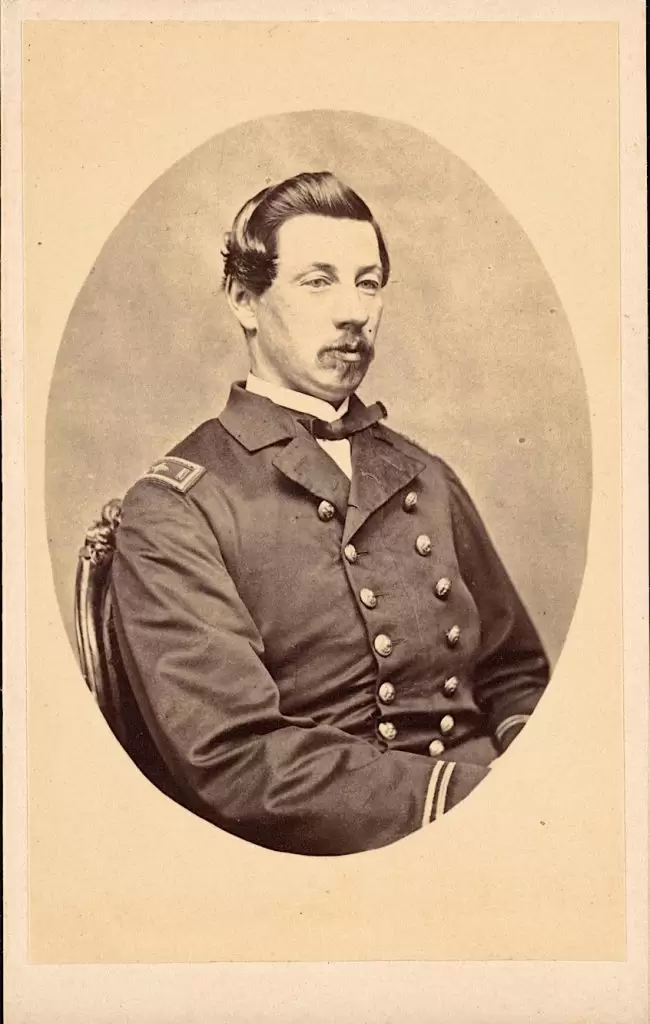
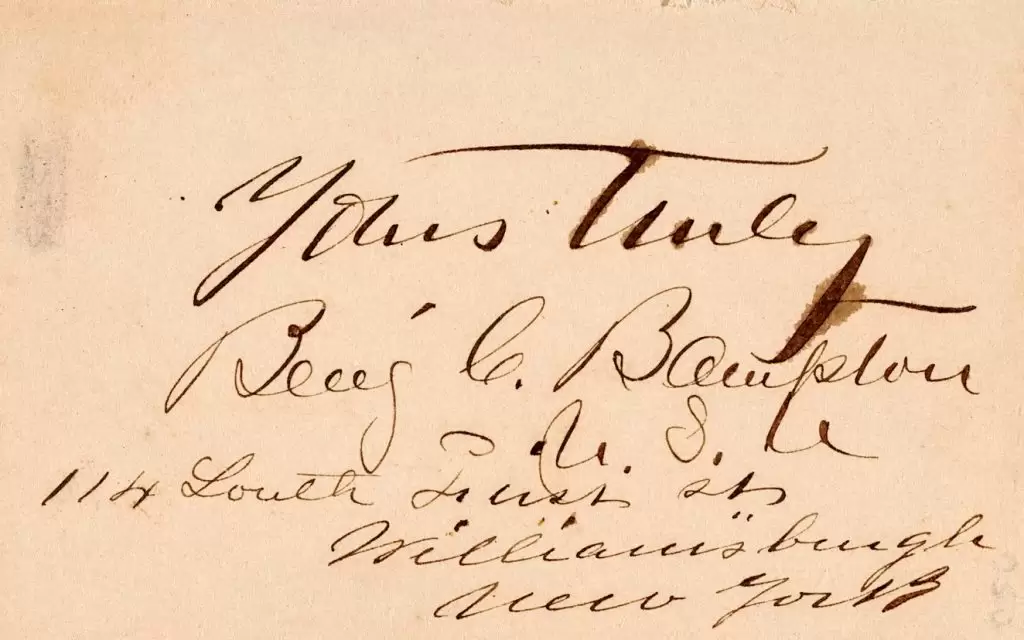
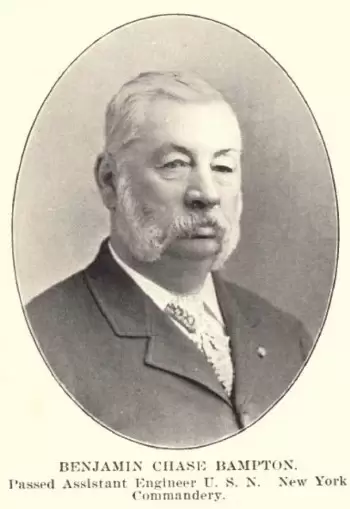
BANG, MARTIN (1835-1872). Private, 20th New York Infantry, Company A. Bang, who was born in Germany, enlisted on May 10, 1861, at New York City, as a private, and mustered into his company the same day. He mustered out on June 1, 1863, at New York City. His last residence was on Hudson Street in Manhattan. Section 165, lot 16943.
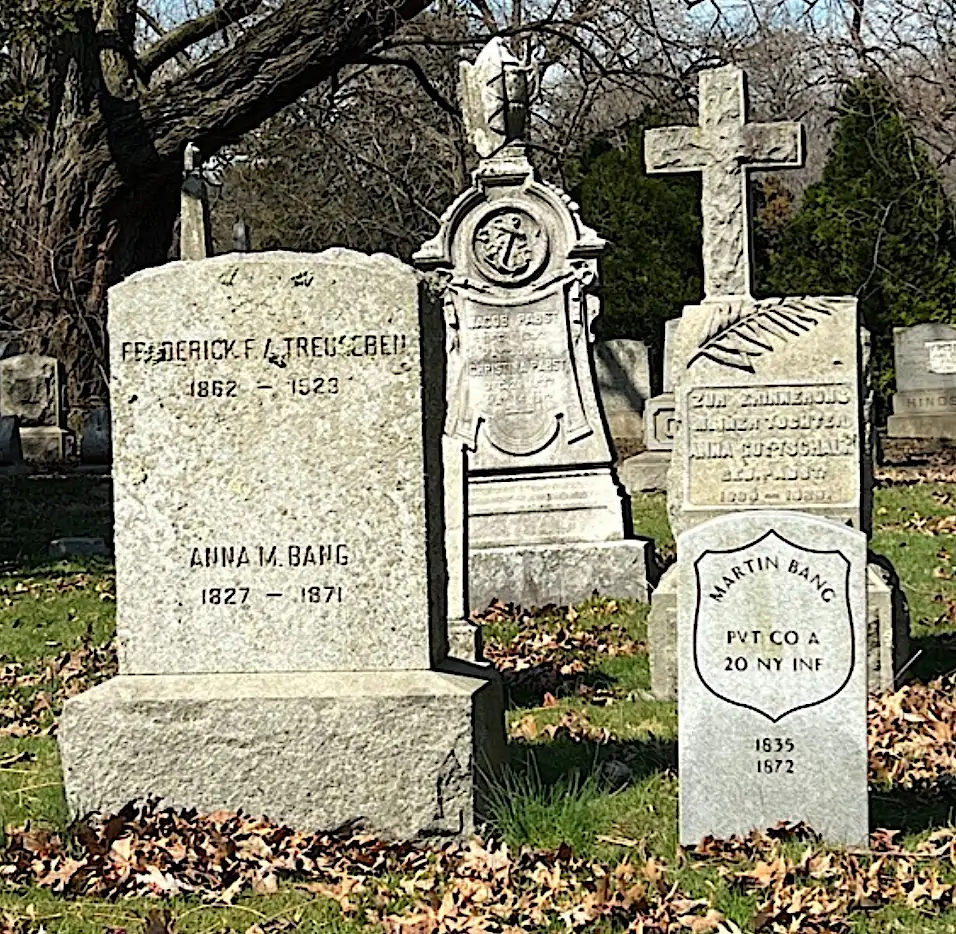
BANG, WALDEMAR (or WOLEMAS, CHARLES) (1838-1903). Private, 5th Regiment, New York State Militia, Company A. Waldemar Bang, a Danish native who was also known as Charles, enlisted on May 1, 1861, served with the 5th Regiment for three months, and mustered out on August 7. In 1894, his application for an invalid pension was approved under certificate 1,006,281. He last lived at 439 51st Street in Brooklyn. Section 6, lot 20118, grave 1002.
BANGS, FRANCIS NEHEMIAH (1828-1885). Quartermaster sergeant, 17th Regiment, New York State National Guard, Company H. A member of the class of 1845 at University of the City of New York (now NYU), Bangs, who was born in New York, also studied at Wesleyan University and Yale Law School; his father, Reverend Nathan Bangs, was president of Wesleyan. During the Civil War, he served for 30 days in 1863 with the 17th Regiment, rising in rank from private to quartermaster sergeant.
Bangs was a prominent and respected attorney in New York City with an early specialty in bankruptcy cases. As per the 1877 New York City Directory, he was a lawyer at 137 Broadway who lived at 254 West 55th Street. He was a partner in several New York City law firms; ultimately when Bangs’s eldest son, Francis Sedgwick Bangs joined him in 1880, the establishment was renamed Bangs & Stetson. The 1884-1885 New York City Directory lists him as a lawyer at 45 Williams Street in Manhattan; he still lived at the West 55th Street address and continued to work until three weeks before his death. Described as a “fearless advocate,” he took part in the impeachment of Judges Barnard and Cardozo who were involved in the Tammany Ring. He gained prominence in the libel suit against Luigi Palma di Cesnola, first director of the Metropolitan Museum of Art, and suits following the failure of the investment firm of Grant & Ward. He served as president of the Bar Association of New York in 1882-1883, of which he was a founding member, and was a member of the Union League Club of New York.
Bangs last resided at 254 West 55th Street in New York City, but died from kidney disease in Ocala, Florida. As per his obituary in the New York Daily Graphic, which noted that he served in the Civil War for a short time, he traveled to Florida about three weeks before his death, via steamer, and was accompanied by his second wife, whom he married in 1882, two of his sons and a physician. Roscoe Conkling and other eminent figures attended his funeral. Section 52, lot 8027.
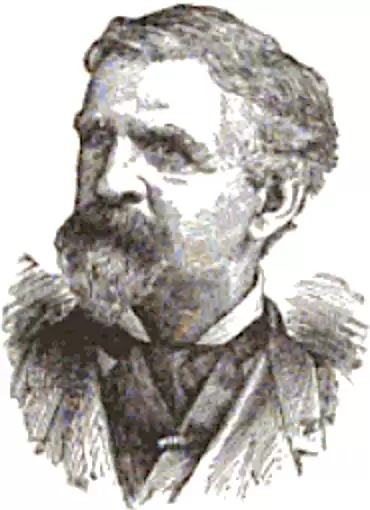
BANKER, HEZEKIAH (1829-1863). Private, 87th New York Infantry, Company E. After enlisting on November 11, 1861, at New York City, he immediately mustered into the 87th as a private. He was taken as a prisoner of war, paroled on an unstated date, and deserted on October 31, 1862, at Annapolis, Maryland. He last lived at 599 Eighth Avenue in Manhattan where he died from consumption. Section 12, lot 8811.
BANKS, FRANCIS S. (1834-1872). Second lieutenant, 12th Regiment, New York State Militia. Company G. Originally interred at Green-Wood, his remains were removed in 1886. After Banks enlisted as a second lieutenant at New York City on April 19, 1861, he was commissioned into his company on May 2, and was detailed as acting military secretary on June 1. He mustered out after three months on August 5 at New York City. His last residence was in Nice, France; his death was attributed to tuberculosis.
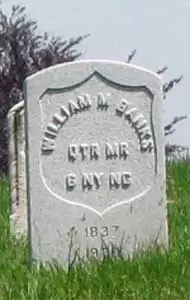
BANKS, WILLIAM M. (1837-1920). Quartermaster, 6th Regiment, New York State National Guard. A New York City native, Banks enlisted as a private on April 21, 1861, served as a quartermaster with the 6th Regiment’s Militia in 1861 and mustered out after three months on July 31. In 1863, he returned as a quartermaster in the Field and Staff of the 6th’s National Guard when it was activated that year for 30 days.
In 1904, Banks successfully applied for an invalid pension, certificate 1,099,777. His last residence was in Cleveland, Ohio. Upon his death in 1920, his wife applied for and received a widow’s pension, certificate 896,849. Section 107, lot 898.
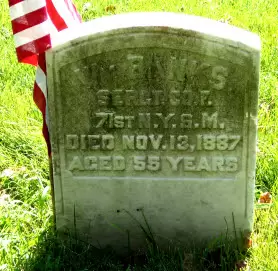
BANKS, WILLIAM O. (1831-1887). Sergeant, 71st Regiment, New York State National Guard, Company F. He enlisted and mustered in on May 27, 1862, and mustered out on September 2 after serving for three months. He was a member of the G.A.R., George C. Strong Post #534, and last resided at 254 Sackett Street in Brooklyn. Banks died from fatty degeneration of the heart. Section 200, lot 26111.
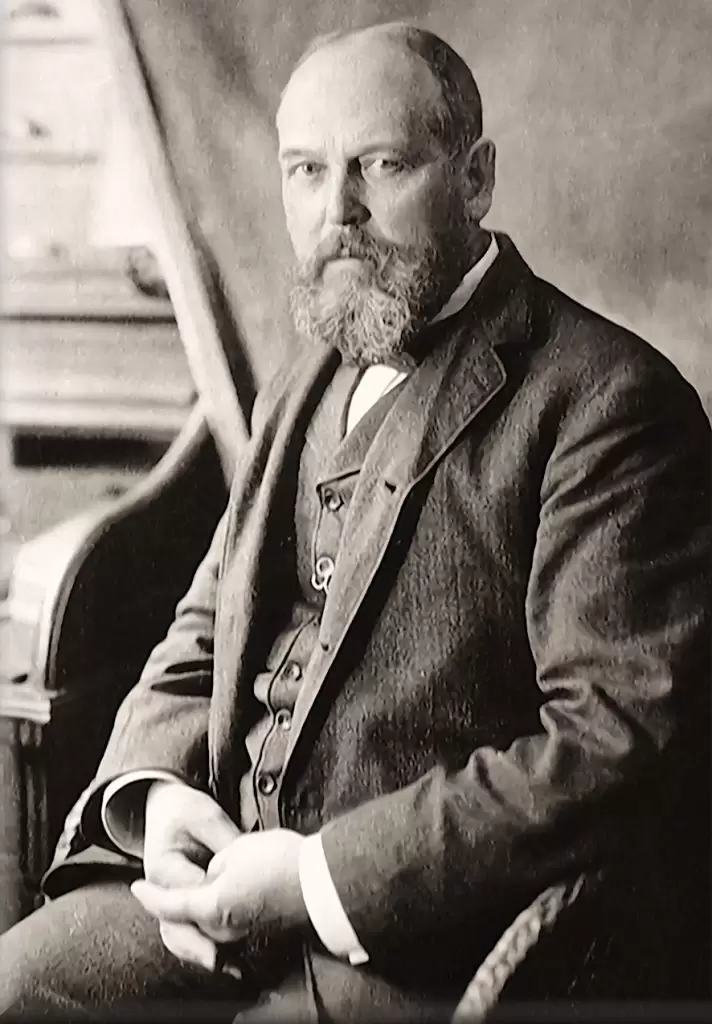
BANNERMAN, FRANCIS (1851-1918). Weapons dealer. Born in Dundee, Scotland, he was brought to Brooklyn by his parents at the age of three. His father joined the Union Navy at the outbreak of the Civil War, but was soon injured and discharged. Francis and his father then went into business buying rope scraps for resale to paper manufacturers.
When the Civil War ended, the Bannermans began to buy surplus Union arms to resell as scrap metal. They also modified some of these guns for resale. By 1884, he was in his own business, selling arms by mail order from a handwritten sheet. In 1888, he issued his first printed catalog, offering small arms, cannon, and other equipment. These catalogs, which his firm would issue until 1965, were known as “the Bibles of the gun collector.” The New York City Directories for 1895-1896, 1896-1897 and 1897-1899 list him as dealing in military goods; as of 1897 his business was at 579 Broadway. His greatest purchase was the bulk of the guns, ammunition, and equipment seized by United States forces in Cuba during the Spanish-American War. This comprised tons of equipment, including 30 million rounds of ammunition. At about the same time, he purchased 371,000 new United States uniforms, and Springfield rifles recovered from the sunken USS Maine.
In 1900, Bannerman purchased Polopel Island in the Hudson River four miles south of West Point, renamed it Bannerman’s Island, and built his arsenal and a five-story castle there. As per an article in the Philadelphia Inquirer on October 6, 1946. Bannerman had purchased from the government 90% of the weapons from the Spanish-American War and needed a place to store them; Polopel Island fit his needs because it was isolated and convenient. In its earliest days, that island was used by Native Americans. It was there that he presided over 40 employees and the world’s largest private arsenal. He opened his store at 501 Broadway in New York City in 1905. It was a collector’s mecca for the next fifty years. Bannerman believed that he could earn more by selling the old materièl to collectors rather than by selling the metal for its scrap value. During World War I, he donated substantial amounts of military equipment to England, including the outfitting of 1,000 Scotch National Guardsman. He also sent converted naval guns to General John Pershing in France. It was believed that his overwork in connection with his gift of 50,000 garments to Belgium led to his death.
Articles in the New York Sun and Poughkeepsie Daily Eagle on December 30, 1918, noted that the settlement of Bannerman’s estate was filed in Probate Court in Poughkeepsie, New York; his estate was valued at $200,000 (the equivalent of $3.4 million in 2020 money). Originally, his estate was divided equally among his four children. However, he amended that will (drawn in Brooklyn on March 11, 1915) on a handwritten note, to provide that his sons, David and Francis (Frank), who joined his business and helped build it, would each receive two-fifths interest in his military business and his other son, Walter, would receive one-fifth; his daughter isn’t mentioned as receiving interest in the business. The estate consisted only of personal property; Ellen Bannerman, his wife, and his son David were the executors.
His sons, Frank and David, continued the family business into the 1960s. The aforementioned article in the Philadelphia Inquirer, written after Frank Bannerman’s death in 1946, noted that the Broadway store supplied weapons for military use during World War II; this was a departure from the business model after World War I which was mostly sales of antiquities. During World War II, sabers were supplied to the Fort Riley cavalry school and gun slings were sent to army units; all usable rifles, revolvers and shotguns went to the national defense. The Bannerman’s store appealed to those of all social strata. It sold authentic trimmings to Henry Ford for his restoration at Greenfield Village and sold King Farouk of Egypt a naval collection of shot and shell. At the time that article was written, buttons from uniforms from the Spanish-American War sold for a dime, old muskets with their mechanisms removed for $1.50, and an Australian boomerang for $7.85. Museums also purchased rare weapons for its collections. In 1966, Bannerman’s Island was acquired by New York State. Section 131, lot 35160.
BANNING, JR., EDMUND PRIOR (1845-1923). First lieutenant, United States Marines. Edward was born in Titusville, Pennsylvania, the fifth child of Edmund Sr. and Lydia née Peck; the couple had ten children, five boys and five girls. Edmund’s father was an eminent physician and lecturer whose maternal grandfather and guardian disinherited him at age eighteen because he chose medicine, not farming, as a career, unlike the family’s previous five generations. Edmund Jr’s obituary notes that he was educated in Tarrytown, New York.
As per an online biographical sketch from the Banning papers at the Indiana Historical Society, Banning Jr. enlisted in the Marine Corps as a private in 1861 and rose to lieutenant. The Lakeland Evening Telegraph published an interview on February 6, 1913, with Dr. Banning, referring to him as an old solder, which confirms his Civil War service. In that article, Banning spoke of his relationship with General Daniel Sickles, stating that he fought in his brigade and knew him after the war. His obituary in the Dayton Herald reports that he was the first private in the marines to receive the rank of lieutenant in the Civil War. As per the Philadelphia Inquirer on November 22, 1869, First Lieutenant Edmund P. Banning resigned from the corps.
After the Civil War, he followed in his father’s footsteps, choosing to be a physician, and attended the Cleveland University of Medicine and Surgery and the Cleveland Homeopathic Medical College. He later lectured on orthopedics at the Herring Medical College at Fort Wayne, Indiana. Banning married four times. His first two wives died; his third wife, Carrie (Carina) Carpenter, whom he married on February 11, 1879, in Geneva, New York, was a 1877 graduate of the University of Wisconsin and subsequently graduated from the Cleveland University of Medicine and Surgery. She opened a medical practice in Fort Wayne in 1898. The couple had five children and divorced on an unknown date.
The Fort Wayne Sentinel reported on January 22, 1902, that Dr. Banning filed for bankruptcy showing liabilities of $17,106.73 and assets of $551.25. The aforementioned article in the Lakeland Evening Telegraph, reprinted from the Times-Union, on February 6, 1913, came after Sickles had been removed from the New York Monuments Commission upon discovery that $27,000 was embezzled. Banning told the interviewer that he did not believe Sickles would have engaged in that behavior. Banning said in part:
I knew General Sickles well in the early days before the war. I knew him afterward, when he commanded the Excelsior Brigade, I have known his since the war, and am confident that it would be as impossible for him to do a criminal act as it would have been to the Father of Our Country. He was a brave man, he was a just man, and I shall never forget, after a fight when a large number of Confederates had been captured, his words, “Treat the boys right, they feel that they are fighting a just cause just as much as we are.
Before settling in Dayton, he was an officer at Hering Medical College in Chicago for ten years. As per his obituary in the Dayton Herald, Dr. Banning practiced medicine there for the last five years of his life. In an advertisement that he ran in the Dayton, Ohio Daily News on May 2, 1920, Banning noted that “for over 45 years” he had specialized in study of the spine and “the development of a spinal correctional system.” He last lived at 836 Neal Avenue in Dayton and died after an extended illness. Upon his death, Banning’s body was taken to Cincinnati for cremation before burial at Green-Wood. He was survived by his fourth wife, Mae, and three children. Section 22, lot 13673.
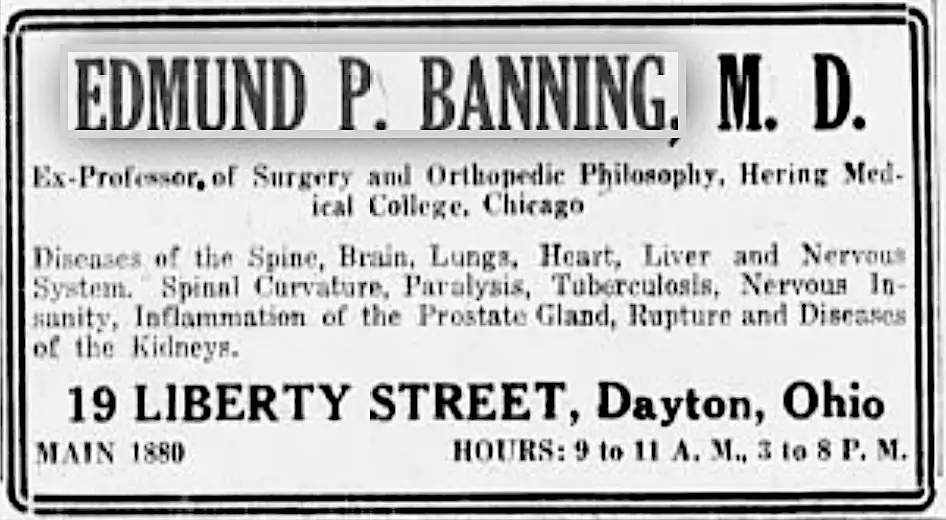
BANTA, GEORGE A. (1832-1896). First lieutenant, 12th Regiment, New York State National Guard, Company E. Originally from New Jersey, Banta enlisted at New York City as a first lieutenant on June 31, 1862, was commissioned into the 12th Regiment on that date, and mustered out of service on October 8 at New York City. When the regiment was reactivated a year later, he re-enlisted at New York City as a first lieutenant, was commissioned into the same company on July 6, 1863, and mustered out after 30 days on July 2o at New York City.
After the war, he was a manufacturer of refrigerators whose business was on Tenth Avenue in Manhattan. A member of many civic organizations, he belonged to the Holland Society, the Old Guard Association of the 12th Regiment, and the Freemasons. In 1896, his application for an invalid pension was granted, certificate 944,434. His obituary in the Brooklyn Standard Union confirmed his association with the 12th Regiment. As per his obituary in the New York Herald, comrades from the organizations to which he belonged were invited to attend his funeral. His last residence was 322 Halsey Street in Brooklyn where he died from nephritis. Emma Banta, his widow, applied for and received a pension, certificate 452,893. Section 97, lot 9378, grave 6.
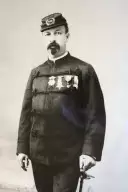
BANTA, WILLIAM (1843-1927). First lieutenant and commissary of substance, 12th New York Cavalry; commissary sergeant, 5th New York Cavalry. After enlisting at New York City on November 1, 1861, he mustered into the Field and Staff of the 5th New York Cavalry that day as a commissary sergeant, and mustered out on September 26, 1862, at Washington, D.C. He re-enlisted on November 20, 1863, at Rocky Point, North Carolina, as a first lieutenant in the 12th Cavalry, and mustered out at Raleigh, North Carolina, on July 19, 1865.
As per his obituary in the New York Sun, which confirms his Civil War service, Banta owned a hat business on Sixth Avenue near 14th Street, following in the footsteps of his father whose hat store was on Canal Street. He last lived at 91 West 4th Street in Manhattan and was survived by two sons and a daughter. He died from heart disease. Section 105, lot 5263.
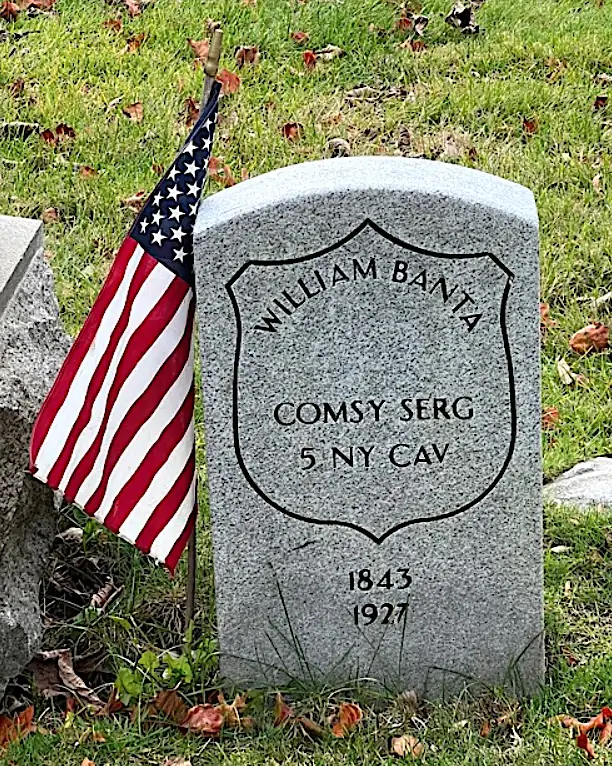
BAPTISTE (or BAPTIS, BAPTIST), JOHN H. (1847-1914). Private, 52nd Regiment, New York State National Guard; 176th New York Infantry, Company I. A native New Yorker, Baptiste enlisted at Brooklyn as a private on October 9, 1862, and mustered into the 52nd National Guard (company not known) seven days later. He transferred into the 176th New York on December 15, 1862, and mustered out at New York City on November 16, 1863. His pension record also indicates service in Company D of the 47th New York but there are no further details. According to his obituary in The New York Times, his two brothers enlisted with him in the same regiment and both were killed in battle.
After the war, Baptiste was employed as a carpenter, builder and contractor. In 1903, his application for a pension was granted, certificate 1,067,790. His last address was 31 Chapel Street in Brooklyn. As per his obituary in the Brooklyn Daily Eagle, comrades in his lodge of the Independent Order of Odd Fellows were invited to attend his funeral at the Walker Chapel at 139 Duffield Street in Brooklyn. In 1915, Bella Michaels Baptiste applied for and received a widow’s pension, certificate 825,917. Section 85, lot 3330.
BARBER, CHARLES H. (1828-1866). Captain, 176th New York Infantry, Company K. A New Yorker by birth, he enlisted as a captain at New York City on January 10, 1863, was immediately commissioned into the 176th New York, and mustered out on December 16 of that year. He last lived at 10 Grove Street in Manhattan. His death was attributed to heart disease. Section B, lot 9895, grave 839.
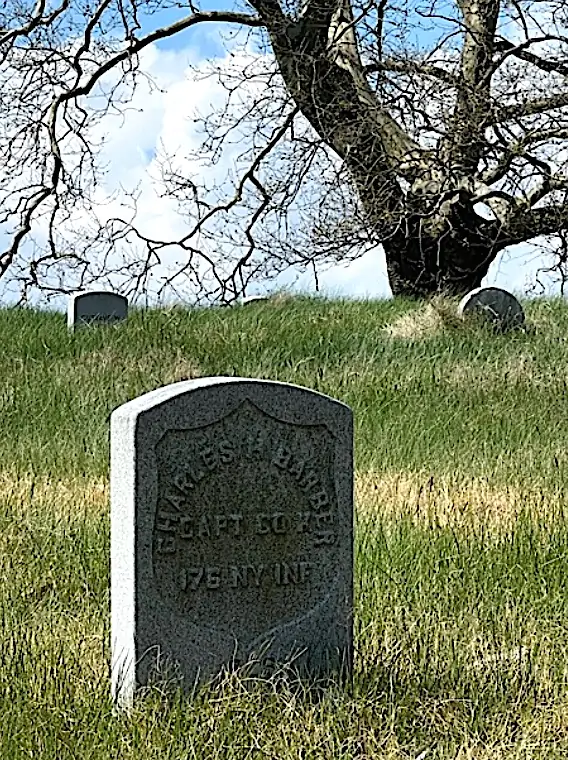
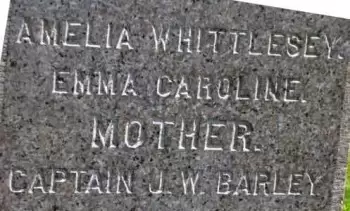
BARLEY, JONATHAN W. (1841-1911). Captain, 37th New York Infantry, Companies C, H, and K; 10th Regiment, Veteran Reserve Corps; Second Battalion, Veteran Reserve Corps; 5th Independent Company, Veteran Reserve Corps. Born in Liverpool, England, Barley enlisted and was commissioned into the 37th New York, Company C, as a first lieutenant on November 4, 1861, at New York City, was promoted to captain on October 8, 1862, and was transferred intra-regimentally to Company H on November 15, 1862. He was wounded in action on May 3, 1863, at Chancellorsville, Virginia, and mustered out at New York City on June 22, 1863.
Barley continued his service when he was appointed to the Veteran Reserve Corps on December 8, 1863. Initially serving as captain of the 10th Regiment, he was transferred to the 159th Company, Second Battalion, on August 1, 1864, assigned to the 5th Independent Company on December 23, 1865, and discharged on August 20, 1866. His application for an invalid pension was granted under certificate 77,596. His last residence was 917 St. Marks Place in Brooklyn. He died from cancer. In 1911, Elizabeth Barley, applied for a widow’s pension, application 976,227. Section 146, lot 22276.
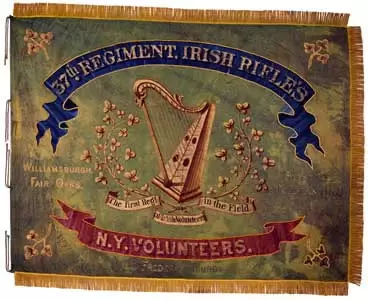
Regimental Color 37th New York Volunteer Infantry Carried at Chancellorsville, Virginia, May 1-3, 1863.
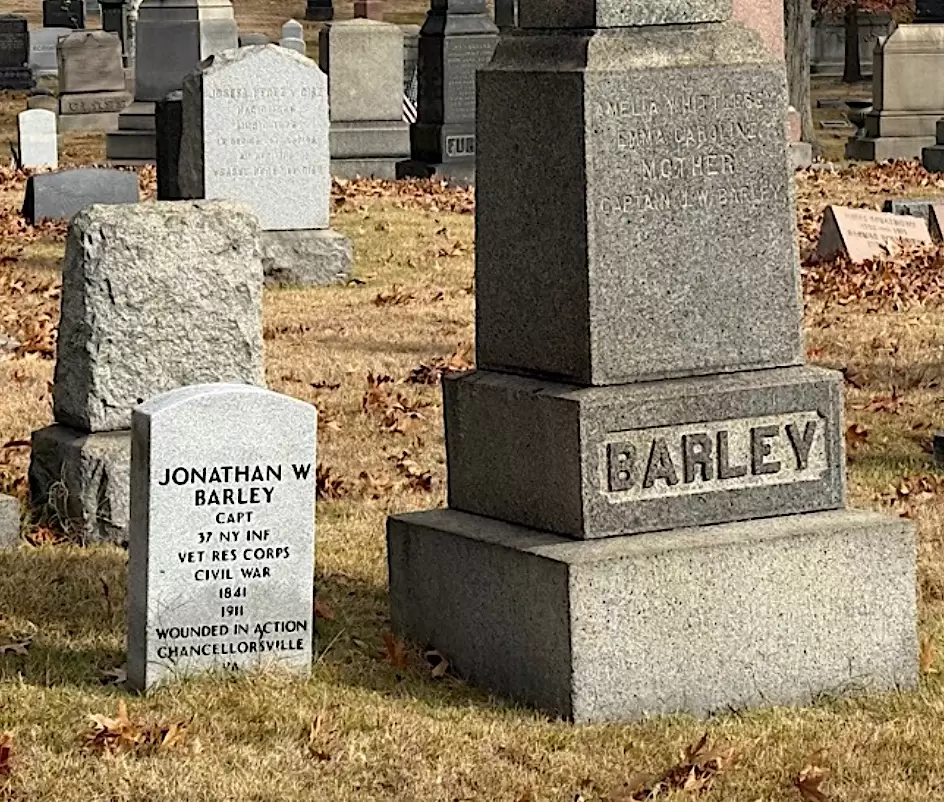
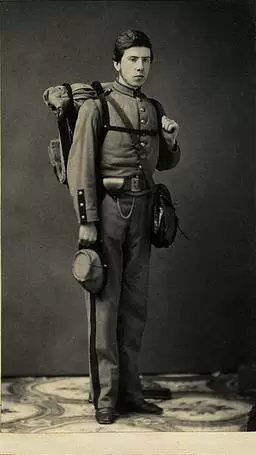
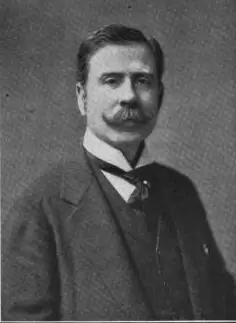
BARNES, ALFRED CUTLER (1842-1904). Sergeant, 23rd Regiment, New York State National Guard, Company A; unknown rank, 7th Regiment, New York State Militia, Company C. Born in Philadelphia, Pennsylvania, his family moved to Brooklyn in 1845 where his father, a publisher, was head of a prominent book concern. Several of his ancestors served in the Revolutionary War and the War of 1812, others were founders of the city of Hartford, Connecticut.
When the Civil War broke out, Barnes, a member of the 7th Regiment (rank unknown), accompanied the regiment on its march to Washington, D.C., but took sick at Annapolis, Maryland, was confined to a hospital for a week, and returned home before mustering in. He later served as a sergeant for 30 days with the 23rd Regiment in 1863 and was engaged in the campaign at Gettysburg, Pennsylvania.
In 1867, Barnes retired from the militia with the rank of lieutenant, but remained active in military affairs. In 1876, he was elected major of the 23rd Regiment. In 1880, he was commissioned Inspector of Rifle Practice with the rank of brigadier general, then became colonel of the 13th Regiment in 1884, and held that same position in the 23rd Regiment in 1900. Educated at the Brooklyn Polytechnic Institute, he became a partner in his father’s business beginning in 1868. When the schoolbook business of the Barnes Company separated in 1891 and became the American Book Company, he was the vice president. He was also the founder of the Astor Place Bank and became its president, and was director of the Corn Exchange Bank.
Active in civic life, he was a trustee of the committee that oversaw the construction of the Brooklyn Bridge, was president of the Brooklyn Public Library, and was a trustee of numerous educational institutions including Cornell University, the Polytechnic Institute and Adelphi Academy in Brooklyn. Among many other organizations to which he belonged was the 23rd Regiment Veteran Association, the Lafayette Post #140 of the G.A.R. in which he was a commander, the Sons of the Revolution, the Pennsylvania Society, the Society of Colonial Wars, Society of the War of 1812, and the Hamilton Club of Brooklyn. An avid traveler, he made a trip around the world in 1892-1893, and visited every state in the United States. As per an article in the Brooklyn Daily Eagle on June 19, 1899, Barnes was appointed to a citizens’ reception committee by Mayor Van Wyck to welcome Admiral George Dewey to Brooklyn upon his return to the United States from his triumph at the Battle of Manila Bay during the Spanish-American War. An article in The New York Times noted that in February-March of 1902, Barnes gifted Cornell University with an observatory equipped with the latest astronomical facilities.
At the time of his death from pneumonia, Barnes resided at 114 Pierrepont Street in Brooklyn. As per his obituary in the Brooklyn Daily Eagle, his funeral took place at the First Presbyterian Church on Henry Street in Brooklyn; another notice of his death in that newspaper requested that comrades of the 13th Veterans Association attend his funeral. An additional article about Barnes’s funeral on the same page as the notices of death indicated that only officers would attend in uniform and that the funeral would be “unostentatious.” As such, there would be a full choir but no sermon or address and six uniformed sergeants from the 23rd Regiment would carry his casket. As per death notices in the New York Herald, members of the Lafayette Post of the Grand Army of the Republic, in which he was a past commander, and Sons of the Revolution in the State of New York, were invited to attend his funeral. According to his obituary in The New York Times, the veterans of the 13th and 23rd Regiments attended his funeral. Section 112, lot 20912.
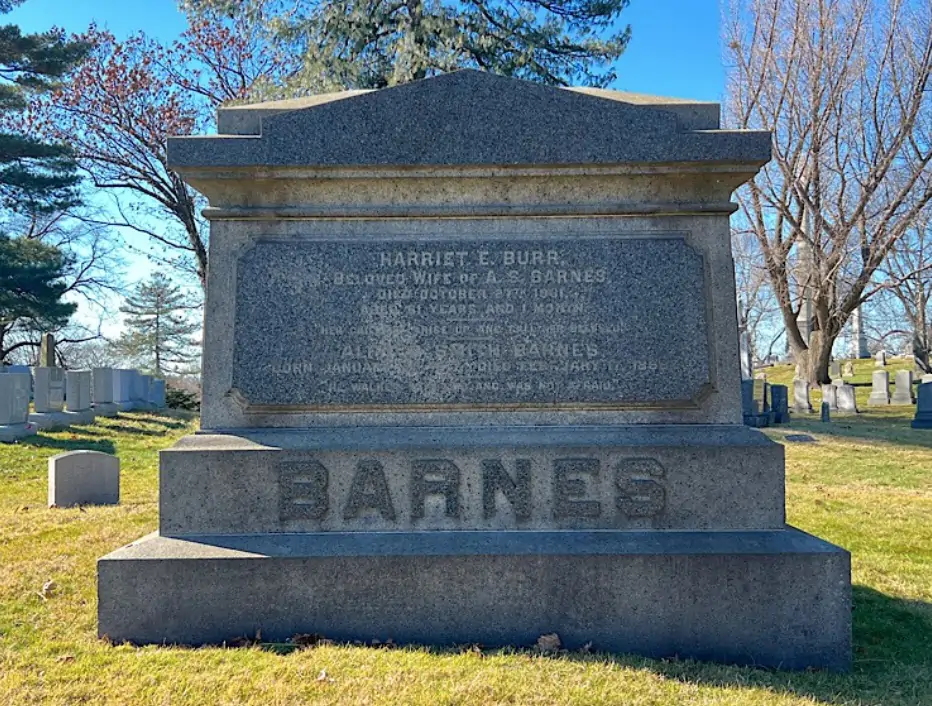
BARNES, EDWARD H. (1824-1866). Private, 79th New York Infantry, Company D. A native of Ireland, Barnes enlisted at New York City as a private on May 13, 1861. On May 27, 1861, he mustered into Company D of the 79th New York from which he deserted on August 6, 1862, at Aquia Creek, Virginia. He last lived at 585 Grand Street in Manhattan. Section 114, lot 8999, grave 1027.
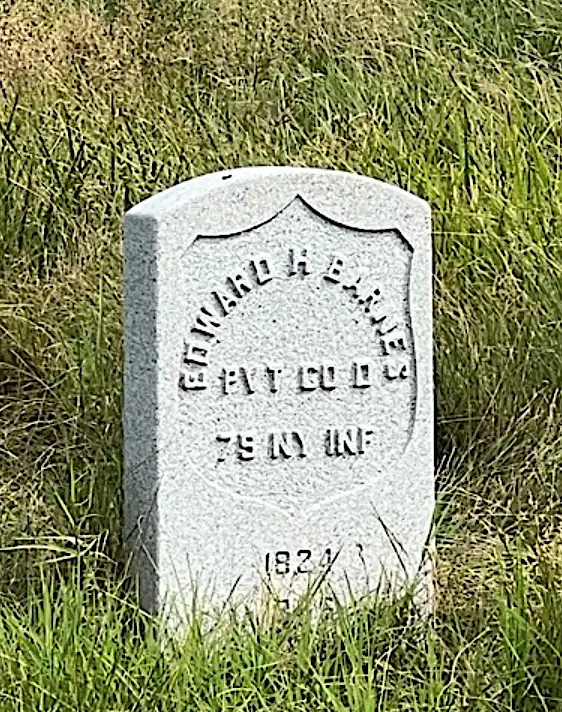
BARNES, EDWARD SALTER (1839-1899). Private, 8th Regiment, New York State National Guard, Company E. Barnes enlisted as a private at New York City on May 29, 1862, and mustered into the 8th Regiment that same day. He mustered out with his company after three months on September 10 at New York City. Although he applied for an invalid pension in 1896, application 1,184,469, it was never certified. As per his death certificate, he was a painter. He last lived at 387 Palisade Avenue in Jersey City, New Jersey. Barnes’s death was a suicide attributed to a pistol shot to the head. In 1913, his wife applied for a widow’s pension which was granted under certificate 809,591. Section 3, lot 8368.
BARNES, SAMUEL W. (1837-1880). Private, 8th Regiment, New York State National Guard, Company E. A New York State native, Barnes enlisted at New York City as a private on May 29, 1862, mustered into the 8th Regiment that day, and mustered out after serving three months on September 10 at New York City. His last residence was 309 West 40th Street in Manhattan. Section 85, lot 1595, grave 50.
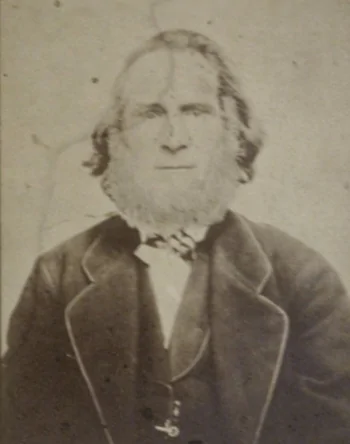
BARNES, WARREN W. (1849-1924). First lieutenant, 7th New Jersey Infantry, Companies F and D. Born in New York City, Barnes enlisted as a corporal on September 2, 1861, mustered that day into Company F of the 7th New Jersey Infantry, and was promoted to sergeant on December 1, 1862. He was wounded in the right hand at the Battle of Chancellorsville and Spotsylvania Court House, Virginia, on February 5, 1863. Barnes was promoted to second lieutenant on September 5, 1863, and rose to first lieutenant on January 28, 1864, effective upon his transfer to Company D on March 23, 1864. He mustered out on October 7, 1864, at Trenton, New Jersey.
As per the censuses of 1870, 1880, 1900 and 1910, Barnes worked as a Post Office clerk; he is listed as a clerk in the New York City Directories for 1875-1876, 1876-1878 and 1884-1885. On March 16, 1886, he mustered into the John A. Dix Post #135 of the G.A.R. He last lived at 295 West 147th Street in Manhattan. Shortly after his death, his wife applied for and was awarded a widow’s pension, certificate 956,441. Section 2, lot 8642.
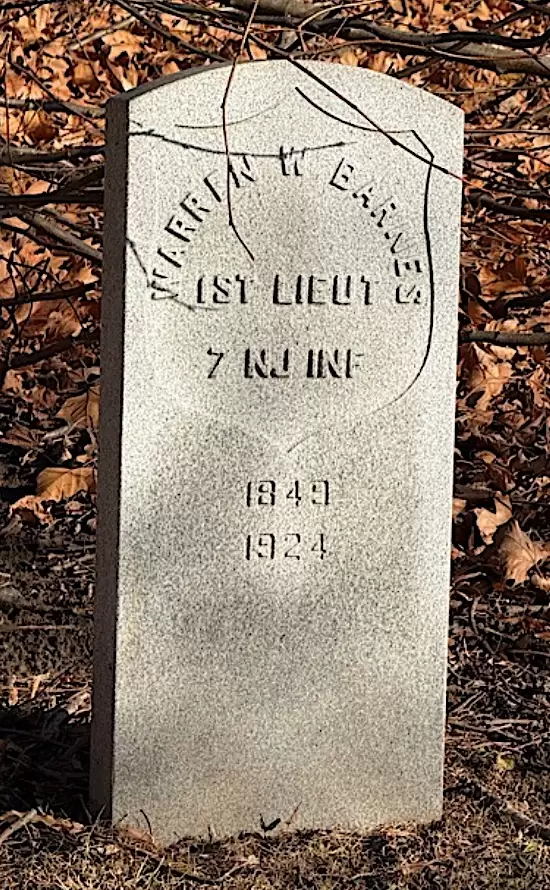
BARNES, WILLIAM (1846-1885). Private, 34th New York Light Artillery. After he enlisted as a private at Brooklyn on March 25, 1864, he mustered immediately into the 34th Light Artillery. He was wounded at Petersburg, Virginia, on June 20, 1864, and mustered out on June 21, 1865, at Hart’s Island, New York Harbor. He last lived at 109 West 133rd Street in Manhattan. Section 119, lot 7062.
BARNETT, EDWARD A. (?-1864). Commander, United States Navy. Barnett became a midshipman in the United States Navy in 1837, acting master in 1847, lieutenant in 1850, and commander in 1862. He died on May 25, 1864. Section 170, lot 12769.

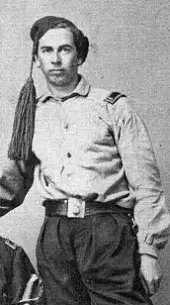
BARNETT, GEORGE (1840-1910). Major by brevet; adjutant, 17th New York Veteran Infantry, Companies G and B; first lieutenant and adjutant, 9th New York Infantry. After enlisting at Albany, New York, and being promoted to first lieutenant and adjutant on April 29, 1863, he mustered into the Field and Staff of the 9th New York the next day. He was transferred out on October 17, 1863, the same day he was commissioned into Company G of the 17th New York Veteran Infantry. On November 1, 1863, he was transferred to Company B, and later attained the rank of adjutant on March 30, 1865, when he was transferred to the Field and Staff. His service was recognized on March 13, when he was brevetted to the ranks of captain and major of U.S. Volunteers “for faithful and meritorious service.” Barnett mustered out on July 13, 1865, at Alexandria, Virginia. He last lived in Brooklyn. His death was attributed to heart disease. Section 128, lot 31262, grave 93.
BARNETT, SAMUEL (1833-1875). Private, 4th New York Infantry, Company K. Serving for less than a month in 1861, Barnett, a native of Ireland, enlisted and mustered into the 4th on May 2 at New York City, and was discharged for disability later that month on May 20. He last resided in Brooklyn where he died from tuberculosis. Section 64, lot 7147.
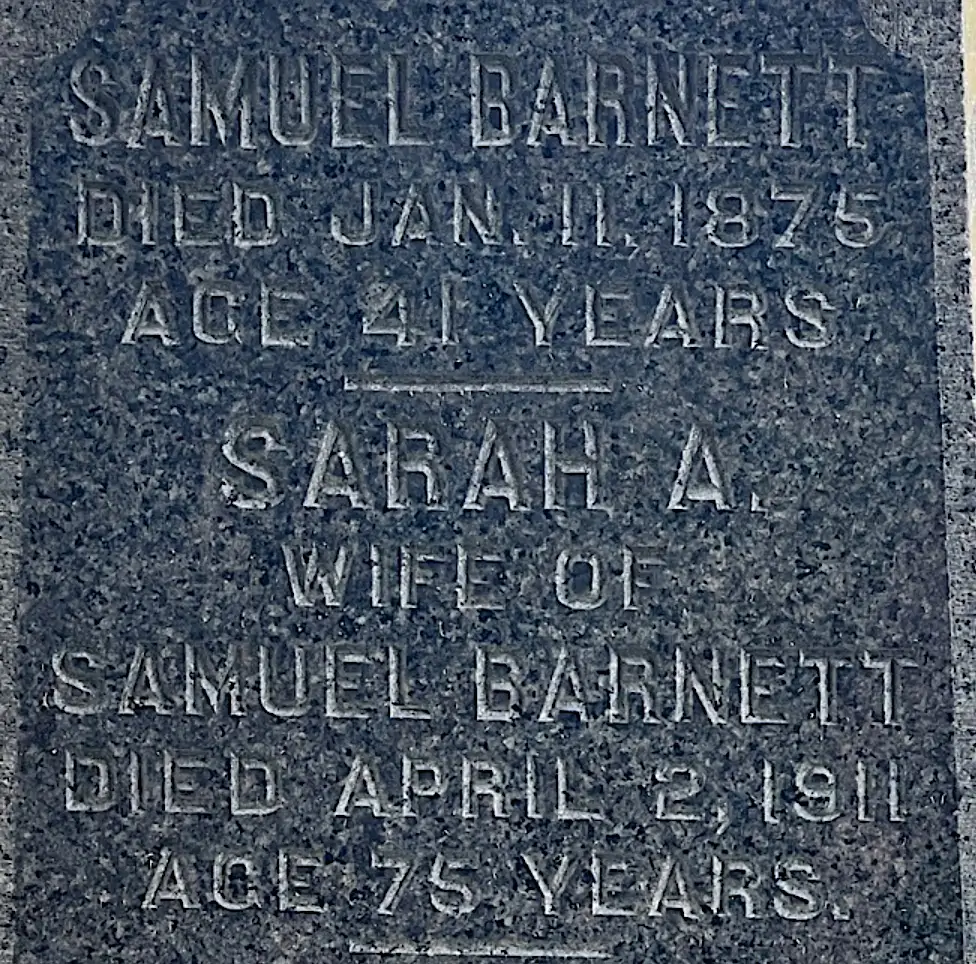
BARNIE, JR., ALEXANDER (1838-1919). Quartermaster sergeant, 84th New York (14th Brooklyn) Infantry, Company H. A native of Manhattan, he moved to Brooklyn when he was ten years old. He worked as a carpenter and, in 1857, enlisted in Brooklyn’s 14th Regiment. When the Civil War began, he enlisted as a private at Brooklyn on April 18, 1861, and mustered in on May 23. Promoted to quartermaster sergeant on September 1, 1861, he served three years in the south, and mustered out at New York City on June 6, 1864. He later was promoted to major and was given command of the New York State Arsenal in Manhattan.
For fifteen years, Barnie worked in the War Record Bureau in Albany. He was a charter member of the Ulysses S. Grant Post #327 of the G.A.R. In 1902, his pension request was granted, certificate 1,061,758. His funeral was held at the Fourteenth Regiment Armory and his body was escorted to Green-Wood by a detachment from the 14th. His family lived at 425 Gold Street in Brooklyn. Barnie died from hemiplegia (paralysis). Section 101, lot 7504.
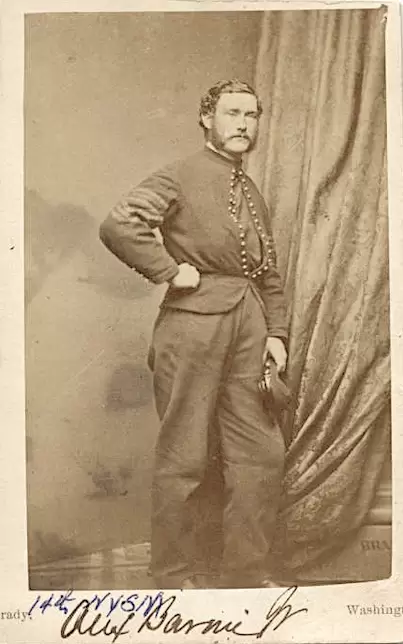
BARR, GEORGE H. (1818-1888). Captain, 12th New York Infantry, Company A. On April 19, 1861, he enlisted at New York City as a captain and was commissioned into the 12th New York on May 2, 1861, serving until his resignation one month later on June 5. According to the 1870 census, he was employed as a dry goods clerk. In 1887, his application for an invalid pension was granted, certificate 463,814. Barr last lived in New York City. His death was attributed to apoplexy. Adrianna Barr, who is interred with him, applied for and was granted a widow’s pension, certificate 263,909. Section 50, lot 8643.
BARR, JOHN (1845-1924). Private, 145th New York Infantry, Company G; 107th New York Infantry, Company E. Barr enlisted as a private at New York City on August 21, 1862, and mustered into the 145th New York on September 11. His muster roll notes that he was absent and detailed to the Ambulance Corps on November 2, 1862; he returned to the rolls on April 11, 1863. He was transferred into Company E of the 107th New York on January 12, 1864, and mustered out at Washington, D.C., on June 5, 1865. In 1882, he applied for and received an invalid pension, certificate 850,352. A widower at the time of his death, he last lived at 81 Third Avenue in Brooklyn. His death was attributed to a cerebral hemorrhage. Section 129, lot 27373, grave 42.
BARR, JOHN M. (1838-1900). Private, 101st New York Infantry, Company C. Born in Victory, New York, he was employed as a schoolteacher. He enlisted as a private at Hastings, New York, on October 6, 1861, mustered into the 101st a month later on November 22, and was discharged for disability on April 28, 1862, at Georgetown, D.C.
Barr taught mathematics for thirty years in various schools in New York with his last appointment being in Brooklyn. In 1892, he was appointed an inspector in the New York Customs House and occupied this position at the time of his death. He was a member of the Freemasons and of the Grand Army of the Republic’s Clarence D. McKenzie Post #399 (which he joined on March 19, 1889). He applied for and received an invalid pension.
As per Barr’s obituary in the New York Herald, comrades from his G.A.R. Post #399, Masonic lodge and members of the following groups were invited to attend his funeral: the Scottish Rite of New York, the Mystic Shrine of New York, the Memphis Rite of New York, and Branch 23 of the Iron Hall of Baltimore (a fraternal benefit society with a secret initiation ceremony). A death notice in the New York Herald from the Scottish Rite referred to Barr as an illustrious noble in that organization; members were invited to attend his funeral. His last residence was 190 15th Street, Brooklyn. He died from pneumonia. His wife applied for and received a widow’s pension. Section 136, lot 28307, grave 75.
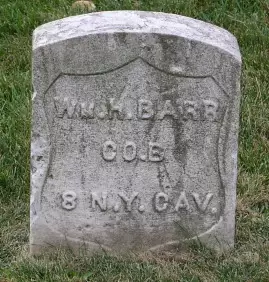
BARR, WILLIAM H. (1846-1896). Private, 8th New York Cavalry, Company B. He enlisted on February 28, 1865, at New York City, mustered into the 8th New York immediately, and mustered out on August 26 of that year at Elmira, New York. Barr last lived at 708 Flushing Avenue in Brooklyn. His death was attributed to Bright’s disease. Section 85, lot 5492, grave 4.
BARRETT, JOHN (1824-1884). Private, 87th New York Infantry, Company A. A Canadian by birth, he enlisted as a private at New York City on November 12, 1861, and mustered into the 87th New York a day later. After being wounded in battle at Fair Oaks, Virginia, on May 31, 1862, he was discharged for disability on February 14, 1863, at New Haven, Connecticut. Barrett applied for an invalid pension in 1863. He last lived at 368 8th Avenue, New York City. His wife, Laurelin Barrett, applied for and was granted a widow’s pension in 1895. Section 13, lot 9227.
BARRETT, JOHN (1828-1919). Acting ensign, United States Navy. Barrett was born in England. His pension index card notes that he first enlisted on May 6, 1861, and became a mate in the United States Navy on August 16, 1861. He was assigned to the Potomac Flotilla, became an acting ensign on September 30, 1863, and was honorably discharged on July 18, 1868.
As per the New York State census of 1865, Barrett lived in Brooklyn, was married and worked as a laborer. The 1875 New York State census reports that he lived in Brooklyn with his wife and two children. In 1893, his application for an invalid pension was granted under certificate 23,175. Barrett died at the Sailors’ Home at Snug Harbor, Staten Island, on May 10, 1919. He died from nephritis. Mary A. Barrett applied for and received a widow’s pension in September 1919, certificate 882,079. Section 131, lot 35331.
BARROWS, WILLIAM H. (1830-1912). Private, 48th New York Infantry, Company K. Barrows, who was born in Mattapoisett, Massachusetts, enlisted at Brooklyn and mustered immediately into the 48th New York on February 23, 1865. He mustered out on June 10, 1865, at Raleigh, North Carolina. A clerk at the start of the War, census records show that he lived in Lenox, Massachusetts, in 1870 and was then employed as a seaman. In 1899, he applied for and received an invalid pension, certificate 987,692. According to census records in 1900, he relocated to 22 Lafayette Street in Fairhaven, Massachusetts, where he resided at the time of his death from senility. His obituary in the New York Tribune notes that he was a former resident of Brooklyn. Section 168, lot 16341.
BARRY, EDWARD (1831-1887). Private, 5th New York Cavalry, Company I; Veteran Reserve Corps. A native of Cork, Ireland, Barry enlisted as a private at New York City on March 16, 1863, and mustered immediately into the 5th New York Cavalry. He was transferred into the Veteran Reserve Corps on April 15, 1864. In 1872, he applied for and received an invalid pension, certificate 118,888. He last lived a 259 39th Street in Brooklyn. His death was attributed to suicide by poison. Section 126, lot 5047, grave 621.
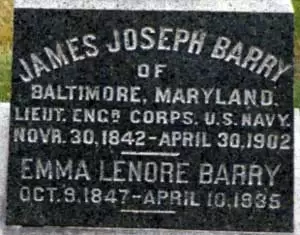
BARRY, JAMES JOSEPH (1842-1902). Second assistant engineer, United States Navy. Barry began his career in the Navy as a third assistant engineer on December 8, 1862. He rose to second assistant engineer on April 8, 1864, and served in that position until he was made a first assistant engineer on January 1, 1868. On February 24, 1874, he passed the exam for assistant engineer and retired on January 9, 1891. His last residence was at 106 McDonough Street in Brooklyn. Barry died from nephritis. As per his obituary in the New York Herald, which noted that he was a retired Navy veteran, a requiem mass honoring his memory was held at Church of Our Lady of Victory at the corner of McDonough Street and Throop Avenue. Section 153, lot 19550, grave 3.
BARSTOW, WILLIAM P. (1829-1897). First lieutenant, 52nd New York Infantry, Company F. He enlisted at Brooklyn as a first lieutenant on June 19, 1863, was commissioned into the 52nd the same day, and mustered out after 30 days on July 25 at Brooklyn. His last address was 234 Greene Avenue, Brooklyn, where he died from Bright’s disease. Section 71, lot 854.
BARTHMAN (or BARTHMANN), FREDERICK WILLIAM (1842-1914). Musician, 20th New York Infantry, Company F. Born in Hamburg, Germany, he immigrated to New York City as a youth, arriving as a cabin boy. He enlisted on May 3, 1861, mustered into the 20th three days later, and mustered out on June 1, 1863.
After the war, he went into the jewelry business, opening Straat and Barthman on DeKalb Avenue in Brooklyn, and married his partner’s daughter. When Straat died, the firm was renamed William Barthman. He is listed as a jeweler in the Brooklyn Directories for 1877 and 1880-1882; he then lived at 104 Kosciusko Street in Brooklyn. The business was at several locations in Manhattan before moving in 1884 to the location where it remains in business to this day: the Barthman building at the corner of Broadway and Maiden Lane. It is known as “the store with the clock in the sidewalk.” He is listed as a jeweler at the Maiden Lane address in the Brooklyn Directories for 1894-1896 and 1896-1898; at that time, he lived at 627 Greene Avenue in Brooklyn.
Barthman also served on the Brooklyn Board of Education and was a member of the G.A.R. He last lived at 22 Montgomery Place in Brooklyn. As per his obituary in the Brooklyn Daily Eagle, members of the U. S. Grant Post #327 of the G.A.R. were requested to attend his funeral in uniform; officers were requested to wear their side arms. Death notices from his Masonic Lodge and the Aurora Grata Consistory of Masonic Masons also appeared in the Brooklyn Daily Eagle; members were invited to attend his funeral. Shortly after his death from heart disease in 1914, Eleanor Barthman applied for a widow’s pension; it was granted under certificate 775,279. Section 88, lot 36491.
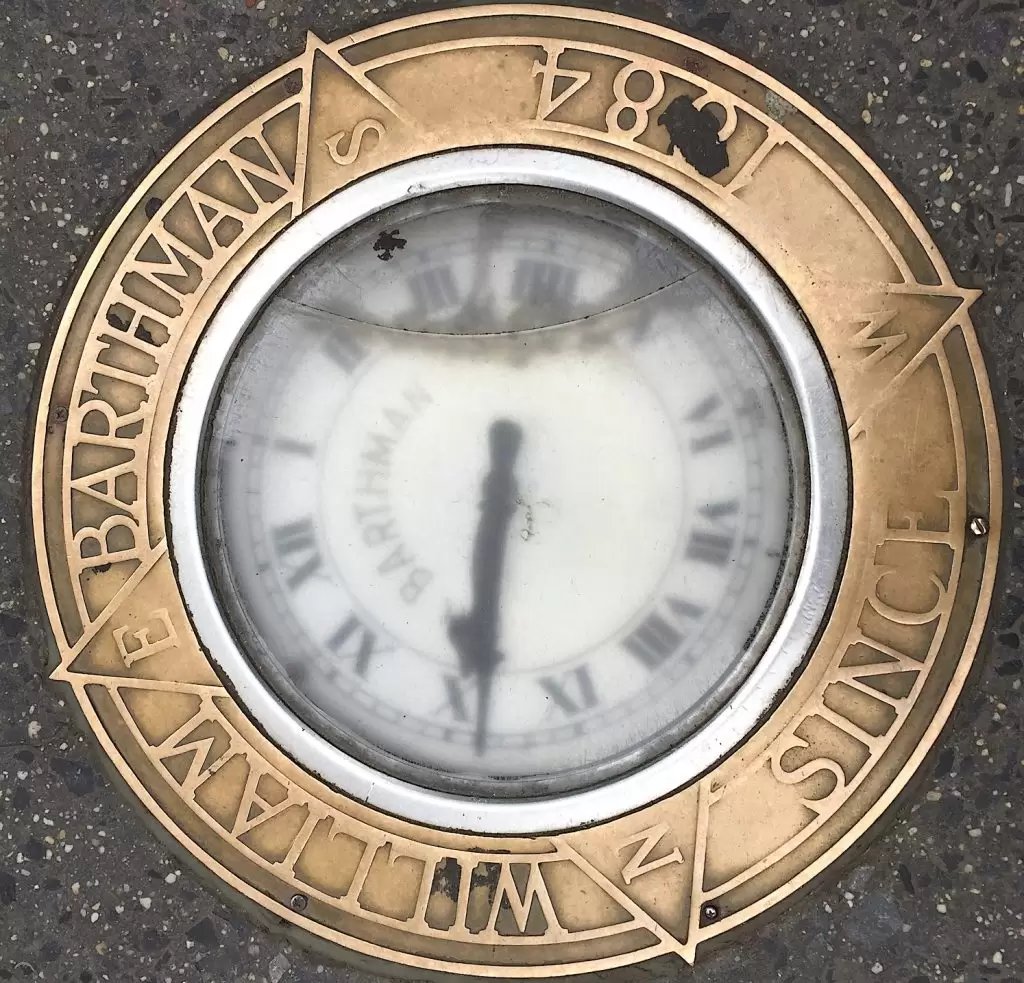
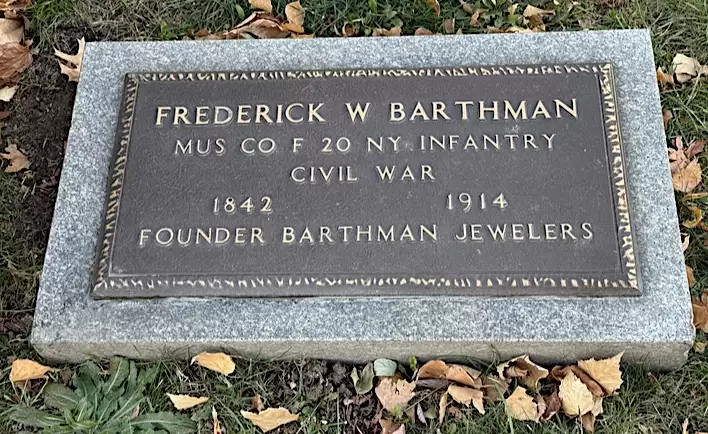
BARTHOLOMEW, HEWITT (1831-1874). Private, 40th New York Infantry, Companies E and D; Veteran Reserve Corps. Originally from England, he enlisted as a private at Yonkers, New York, on June 14, 1861, and mustered into the 40th New York on that date. He was wounded in action at the Battle of Fredericksburg, Virginia, on December 13, 1862, and was subsequently transferred intra-regimentally to Company D on May 25, 1863. On November 2, 1863, he was transferred into an unknown company of the Veteran Reserve Corps. His last residence was 45 Norfolk Street in Manhattan. Section 17, lot 17245, grave 1396.
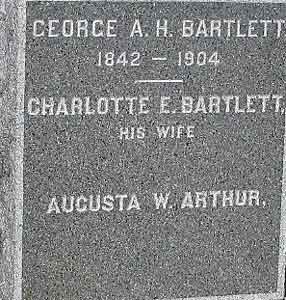
BARTLETT, GEORGE A. H. (1842-1904). Private, 71st Regiment, New York State Militia, Company C. Bartlett served in the 71st Regiment for three months in 1861. He applied for and was granted an invalid pension in 1893, certificate 992,171. At the time of his death from a cerebral laceration, he lived at 12 St. Felix Street in Brooklyn. Charlotte Bartlett, who is interred with him, applied for and received a widow’s pension, certificate 584,461. Section 193, lot 31773, grave 2.
BARTLETT (or BARLITT), GEORGE W. (1834-1893). First lieutenant, 14th New York Infantry, Company I; 5th New York Heavy Artillery, Companies D, K, and M. Bartlett, who was born in New York, was 5′ 5″ tall with brown hair, a straight nose, dark blue eyes and a full moustache. On May 7, 1861, he enlisted at Martinsburg, New York, was commissioned into Company I of the 14th New York on May 17, 1861, and resigned from service on December 11, 1861. Bartlett re-enlisted on an unknown date, mustered into the 5th Heavy Artillery as a sergeant, then rose to second lieutenant of Company M on August 21, 1862. His promotion to first lieutenant became effective upon his transfer to Company K on December 24, 1864. On June 26, 1865, he mustered out.
A news article written after muster out noted that the 5th Heavy Artillery defended Washington, D.C., and built a garrison at Maryland Heights which it defended July 3-8, 1864. When the battalion reached New York City via the USS Cayuga, the men were greeted by the Citizens’ Committee which feted them with a hearty welcome and plenty of food at hosting hotels. In 1888, his application for an invalid pension was granted, certificate 435,138. A resident of Watertown, New York, in 1890, he was listed in the town directory as a mechanic by trade. He was a resident of Hempstead, New York, at the time of his death from heart disease. Section 156, lot 24741, grave 6.
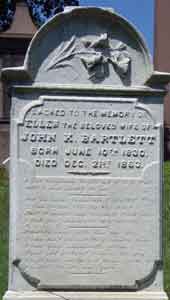
BARTLETT, JOHN K. (1830-1883). Boatswain, United States Navy. Born in Portland, Maine, he served in the Navy during the Civil War and took the helm of the warship Vermont during a treacherous storm at sea. Risking his life when the badly damaged ship appeared to be uncontrollable, he managed to take hold of the rudder and save the vessel and the lives of the men on board. The United States government publicly recognized these actions. In 1865, he was listed as a boatswain, (a petty officer in charge of the ship’s riggings, cables, anchors, and deck crew), aboard the USS Colorado, part of the North Atlantic Squadron. A news article in The New York Times on August 30, 1867, noted that Bartlett was a boatswain on the Colorado when it arrived in New York from Cherbourg, France, and Nova Scotia, Canada, the previous day. After the War, he owned storage warehouses on the New York waterfront and lived in Brooklyn at 67 St. James Place. Section 99, lot 8639.
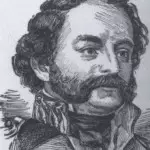
BARTLETT, WASHINGTON ALLEN (1816-1865). Colonel, 99th New York Infantry. After serving as the first chief magistrate of the city of San Francisco, Washington Allen Bartlett became a naval lieutenant in the Mexican War and remained in the United States Navy until 1855. He was colonel in the Naval Brigade, known as the Union Coast Guards, in 1861, but the regiment was not accepted for service and it was reorganized as the 99th New York Infantry. Bartlett was seriously injured in a fall at Fortress Monroe, Virginia. He died in New York City. Section 90, lot 772.

BARTON, HAMILTON W. (1837-1900). Private, 71st Regiment, New York State Militia, Company C. Born in New Jersey, Barton served for three months in 1861 with the 71st Regiment. Barton’s cause of death was paralysis. His last address was 242a Classon Avenue in Brooklyn. In 1901, Julia Barton applied for and received a widow’s pension, certificate 662,637. Section 196, lot 30720, grave 1.
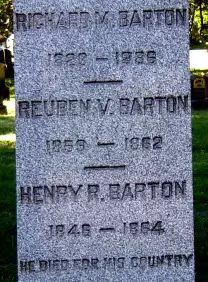
BARTON, HENRY R. (or RICHARD H.) (1846-1864). Private, 176th New York Infantry, Company B. Born in Florida and a resident of Jersey City, New Jersey, Barton enlisted at New York City as a private on September 15, 1862, and mustered into his company three days later. Although records state that he was killed in action on June 21, 1863, at La Fourche, Louisiana, his gravestone bears the inscription, “He died for his country,” and indicates the year of death as 1864. Interment at Green-Wood was on March 11, 1864. Section 169, lot 8003.
BARTON, ROBERT (1840-1876). Corporal, 48th New York Infantry, Company I. Barton, who was born in Ireland, enlisted as a corporal on August 13, 1861, at Brooklyn, mustered into his company three days later, and was discharged on an unknown date. In 1874, his application for an invalid pension was granted, certificate 131,947. Barton died from tuberculosis. He last resided at 232 West 28th Street in Manhattan. His widow applied for and received a pension, certificate 174,452. Section 194, lot 28820, grave 3.
BARTOW, WILLIAM J. (or I.) (1833-1905). Private, 7th Regiment, New York State Militia, Company F. Bartow, who was born in New York City, served in 1861 for 30 days with the 7th Regiment when it was activated that year. His last address was 239 Macon Street in Brooklyn where he succumbed to heart disease. His widow, Rachel Bartow, who is interred with him, applied for a pension in 1905, application 836,044, but no certification number is listed. Section 109, lot 46.
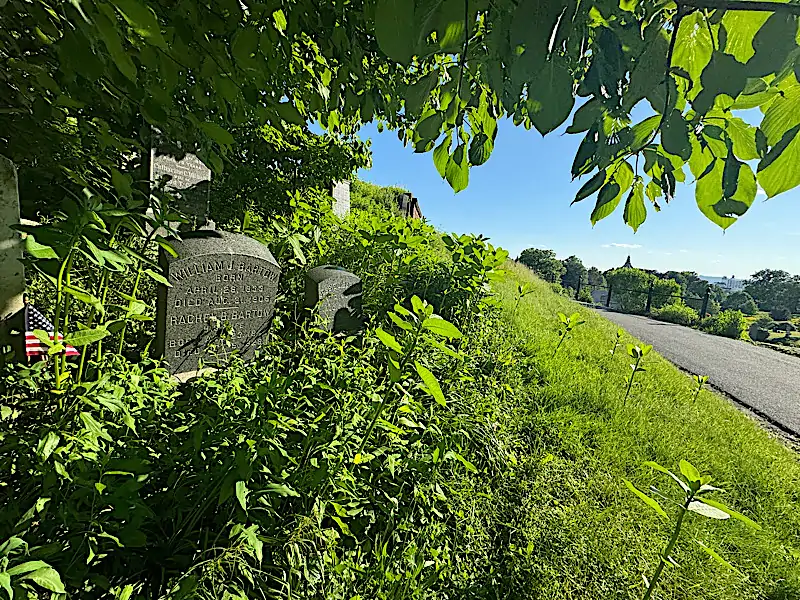
BARTSCH (or BANASCH), FREDERICK (1833-1908). Second lieutenant, 8th New York Infantry, Company G. Born in Austria, he enlisted and mustered into the 8th New York as a corporal at New York City on April 23, 1861. He rose through the ranks becoming a sergeant major, was transferred to Field and Staff, and became a second lieutenant (but was not commissioned) on August 14, 1861, the date he was transferred back to Company G. Bartsch died from senility. He last lived on 18th Avenue in Brooklyn. Section 135, lot 27263, grave 1420.
BARWICK, THOMAS (1826-1866). Private, 5th New York Cavalry, Company A. A native of England, Barwick enlisted and mustered into the 5th New York Cavalry on January 30, 1864, at New York City, as a private. On July 19, 1865, he mustered out at Winchester, Virginia. His last residence was 934 Atlantic Avenue in Brooklyn where his cause of death was listed as delirium tremens (alcohol withdrawal). Section A, lot 9146, grave 153.
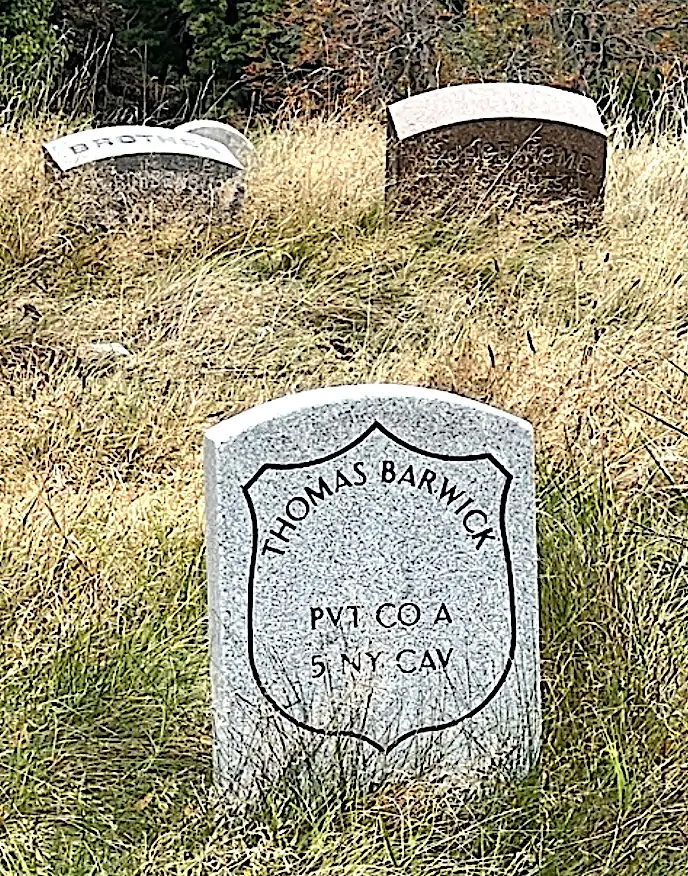
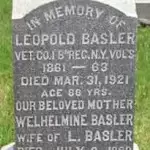
BASLER (or BASELER), LEOPOLD (1835-1921). Sergeant, 56th Regiment, New York State National Guard, Company D; private, 8th New York Infantry, Company I. A native of Germany, he immigrated to the United States in 1858 on the ship Oasis. His obituary, however, reports that he immigrated to Brooklyn at age 13. During the Civil War, Basler enlisted on April 23, 1861, at New York City, and mustered into the 8th New York on that date. He mustered out on April 23, 1863, at Brooks’ Station, Virginia. He became a naturalized citizen in October 1863. Basler is listed as a shoemaker in the 1863 Brooklyn Directory; he then lived on 16th Street near Sixth Avenue. On July 11, 1864, he re-enlisted as a sergeant with the 56th Regiment, and mustered out on November 6 of that year.
Basler is listed as a shoemaker in the 1866, 1870-1873 and 1890-1892Brooklyn Directories. In 1890, his application for an invalid pension was granted, certificate 649,607. His obituary in the Brooklyn Daily Eagle notes that he was a master cobbler who attracted customers from Borough Park, Williamsburg, Fort Hamilton and Flatbush. His work was considered fastidious and his shoes fit perfectly and were considered “the last word” in leather craftsmanship. Basler’s obituary notes, “He was a faithful husband, a good American and everybody liked him.” Leopold and Eleanor Basler, his second wife, died together when gas fumes escaped from their kitchen stove and accidentally killed them as they slept. The tragedy was discovered the next morning when their daughter, Annie Vogel, who lived in the upstairs apartment, came to visit them. He last lived on 17th Street in Brooklyn, an area once known for Gowanus oysters that were shipped to the Caribbean. Section 137, lot 28542.
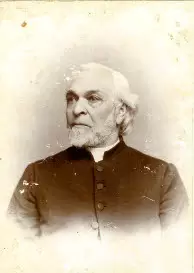
BASS, JOB GARDINER (1816-1901). Chaplain, 90th New York Infantry. Born in Charleston, South Carolina, he was 5′ 6″ with a dark complexion, black eyes, and gray hair. A clergyman by occupation, he enlisted at age 46 as a chaplain at East New York on November 24, 1862, was commissioned that day into the 90th New York, and mustered out at New York City on December 10, 1864. The 1863 and 1864 Brooklyn Directories list him as a reverend at 45 DeKalb Avenue in Brooklyn. His son, William Henry Bass (see), also served in the War.
The Brooklyn Directories for 1865 and 1866 note that he was a reverend whose home address was still 45 DeKalb Avenue; the Brooklyn Directories for 1873-1876 and 1880-1882 list him as a reverend whose home address was 57 DeKalb Avenue. Bass was active in the William Rankin Post #10 of the G.A.R. and worked as a chaplain until his death, his ministry being the Brooklyn Penitentiary. He last lived at 431 Waverly Avenue in Brooklyn. Bass’s cause of death was senility. Section 189, lot 16826, grave 7.
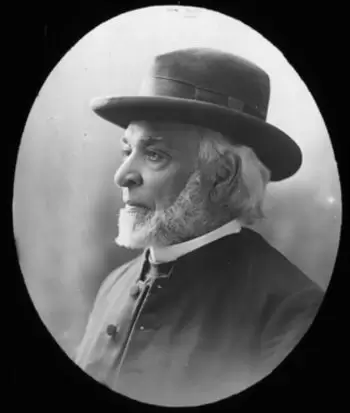
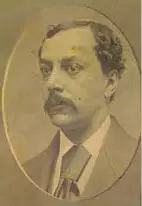
BASS, WILLIAM HENRY (1841-1874). Hospital steward, 6th New York Cavalry; 2nd New York Provisional Cavalry. Born in Charleston, South Carolina, on William Henry Harrison’s Inauguration Day, he was named for the new president. His family moved to Toronto, Canada, before re-settling in the United States in Brooklyn. After enlisting at New York City on October 10, 1861, he mustered into the 6th New York Cavalry as a hospital steward with the rank of ward master on October 25. He was 5′ 8″ tall with hazel eyes and black hair; he had a dark complexion and was, by occupation, a chemist. On May 3, 1863, he was captured at the Battle of Chancellorsville, Virginia. Confined in Richmond, Virginia, on May 7, he was paroled at City Point, Virginia, on May 14, reported to Camp Parole, Maryland, on May 16, then went to Camp Convalescent until July 24, 1863.
Bass re-enlisted on December 16, 1863, with the rank of private, again serving as a hospital steward, and was transferred into the 2nd Provisional Cavalry. On August 16, 1864, he was captured at Kernstown, Virginia, was confined at Richmond on August 20, and was paroled at Varina, Virginia, on October 8, 1864. He was then assigned to the Division 1 hospital at Annapolis, Maryland. He mustered out at Louisville, Kentucky, on August 9, 1865.
After the Civil War, Bass returned to his family’s drug business and helped run their establishment on DeKalb Avenue. His battlefield experience gave him expertise as a surgeon although he never had formal training in that specialty. According to a descendant, his death in 1874 resulted from the lingering effects of disease and malnutrition resulting from his wartime imprisonment. Job Bass (see), his father, also served in the War. He last lived at 57 DeKalb Avenue in Brooklyn. Lydia Bass, who is interred with him, applied for and received a widow’s pension in 1890, certificate 301,946. Section 189, lot 16826.
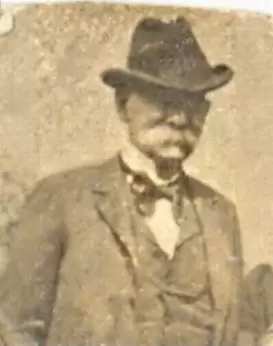
BASSFORD, STEPHEN ALLEN (1827-1904). Colonel, 94th Ohio Infantry; captain, 74th Ohio Infantry, Company B. Bassford was employed in the cigar business before the Civil War traveling between Toledo and Cleveland, Ohio, to barter his stock. He then became a section foreman for the Little Miami Railroad for the portion of track that was built between Dayton and Xenia, Ohio. An ardent Free-Soiler, he went to Kansas to cast a ballot for that state’s admission to the Union as a free state before returning to Ohio.
After enlisting as a private on October 3, 1861, Bassford was promoted to captain two months later on December 5, and mustered into the 74th Ohio on January 18, 1862. He became lieutenant colonel on August 11, 1862, effective upon his transfer to the 94th Ohio where he later became its colonel. Colonel Joseph W. Frizell, his commanding officer, credited Bassford in his report of October 10, 1862, noting his coolness and bravery under severe battle conditions.
According to the New York City Directory for 1877 and the Brooklyn Directory for 1885-1886, Bassford was in the segar (cigar) business. In 1894, he successfully applied for an invalid pension, certificate 976,503. He last resided at 631 East 136th Street in New York City where he died from a stroke. His obituary in the New York Herald confirms his service as a colonel in the 94th Ohio during the Civil War and asked that newspapers in Xenia, Ohio, print a notice of his death. Anna Bassford, who is interred with him, applied for and received a widow’s pension in 1904, certificate 592, 123. Section 92, lot 3026.
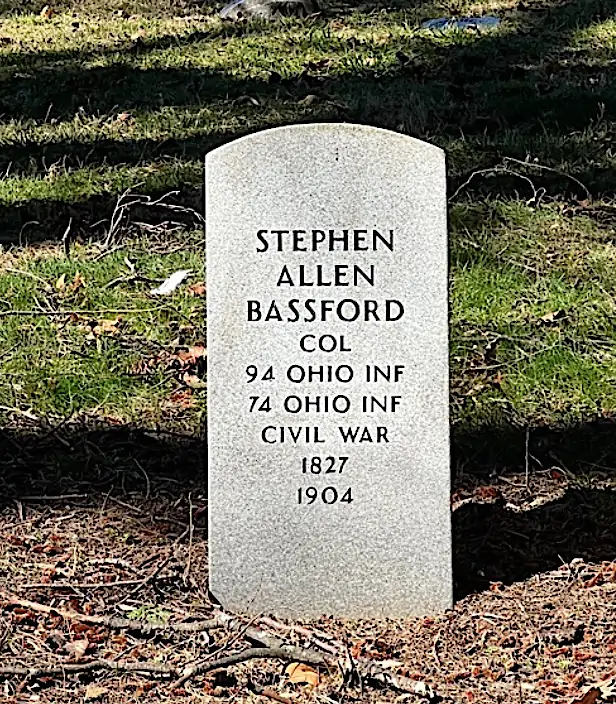
BATEMAN, BENJAMIN C. (1834-1873). Private, 101st New York Infantry, Company E; 37th New York Infantry, Company E; 40th New York Infantry, Companies K and F. Bateman served as a private with three New York regiments. He enlisted at Rome, New York, on December 20, 1861, mustered into the 101st the next day, and transferred into the 37th on December 24, 1862. On May 29, 1863, he was transferred to Company K of the 40th New York. He transferred to Company F on July 7, 1864, and mustered out at Washington, D.C., on June 27, 1865. He last resided in Hoboken, New Jersey. Section 17, lot 17245, grave 285.
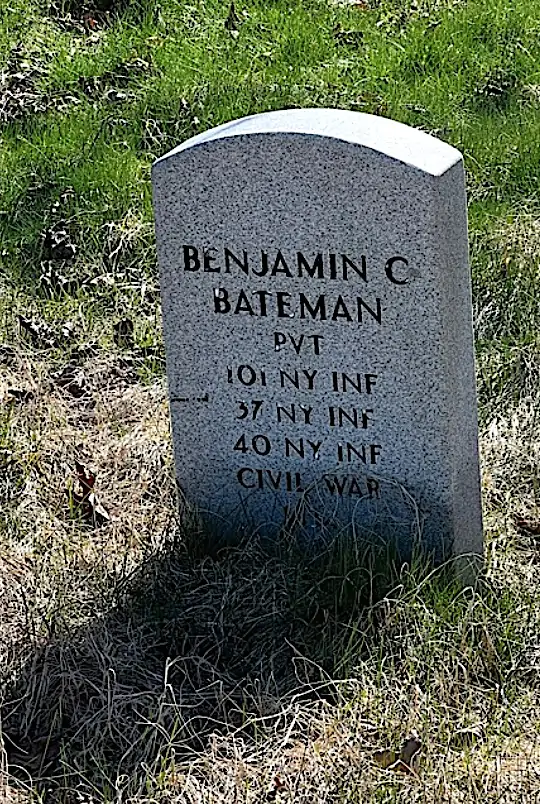
BATES, AARON PEARCE (1837-1907). Captain, 102nd New York Infantry, Company D. Originally from Connecticut, Bates lived on President Street in Brooklyn and was a lawyer when he entered service. He was 5′ 5½” tall with gray eyes, dark hair and a light complexion. He enlisted as a first lieutenant at New York City on October 26, 1861, and was commissioned into the 102nd New York on February 15, 1862. He was promoted to captain on November 15, 1862, and resigned on February 8, 1863, the same day that he was discharged.
After his military service, Bates resumed practicing law. He is listed as a lawyer in the Brooklyn Directories for 1863, 1864, 1866, 1867-1870, 1870-1873, 1880-1882, 1885-1886, 1890-1892, 1892-1894, and 1894-1896. As of the 1890 Directory, his practice was at 186 Remsen Street and his home address was at 534½ Pacific Street. Bates died from rheumatism. His last residence was 534½ Pacific Street in Brooklyn. Section 114, lot 20769.
BATES, EDWARD GUMBS (1837-1891). Private, 21st New Jersey Infantry, Company G. After Bates enlisted as a private on August 25, 1862, he mustered into the 21st New Jersey on September 15, and mustered out at Trenton, New Jersey, on June 19, 1863. His military service was confirmed by the Schedule of Surviving Soldiers and Sailors. He was employed as an agent. He last lived at 295 8th Street in Brooklyn where he succumbed to pneumonia. In 1909, his wife applied for and received a widow’s pension, certificate 680,797. Section 138, lot 27591.
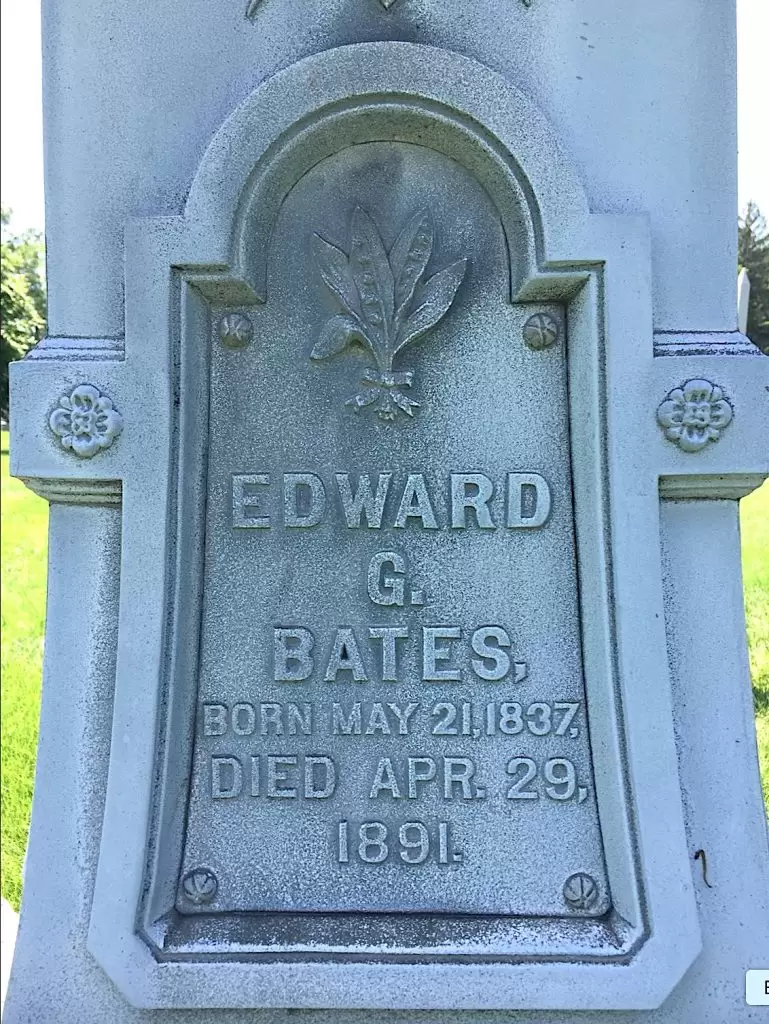
BATES, ISAAC F. (1840-1913). Sergeant, 139th New York Infantry, Company C; private, 82nd New York Infantry, Company B. A New York City native, Bates enlisted there as a private on May 28, 1861, mustered into the 82nd the same day, and deserted at Washington, D.C., on August 1 of that year. After re-enlisting as a private at Brooklyn on August 22, 1862, he mustered into the 139th New York on September 9. He was promoted to sergeant on November 7, 1864, and mustered out on June 19, 1865, at Richmond, Virginia.
The Brooklyn Directory for 1880-1882 lists Bates as a bookkeeper. In 1883, he became a member of the Ulysses S. Grant Post #327 of the G.A.R. In 1903, he received an invalid pension, certificate 1,065,279. As per his obituary in the Brooklyn Daily Eagle, comrades from his G.A.R. Post #327 were invited to attend his funeral in uniform. His last residence was at 73 84th Street in Brooklyn. Bates died from apoplexy. Section 59, lot 1213, grave 10.
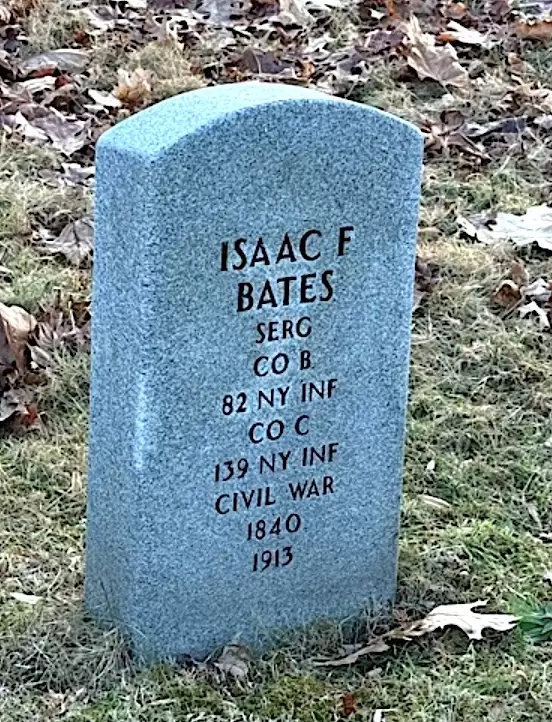
BATES, JOHN W. (1839-1868). Private, 71st New York Infantry; 120th New York Infantry, Company F. On August 12, 1862, he enlisted at Brooklyn as a private in the 71st New York Infantry. Almost two years later, on July 7, 1864, he was transferred into the 120th New York Infantry, Company F. He mustered out from service at Washington, D.C., on June 3, 1865. His death notice, in the New-York Daily Herald, confirms his service in the 120th Infantry.
Green-Wood’s interment records note that he was born in Ireland, was single, had worked as a clerk, died of “softening of the brain,” and last lived at 100 William Street in Brooklyn. Section 189, lot 16544.
BATES, JOSEPH (1832-1904). Private, 22nd Regiment, New York State National Guard, Company D. Bates was born in Newtown, Stewart Island. After enlisting at New York City on May 28, 1862, he mustered immediately into the 22nd New York, and mustered out after three months at Newburgh, New York, on September 5. He last resided at 974 Clinton Street in Brooklyn where he died from diabetes. Section 161, lot 12714, grave 13-14.
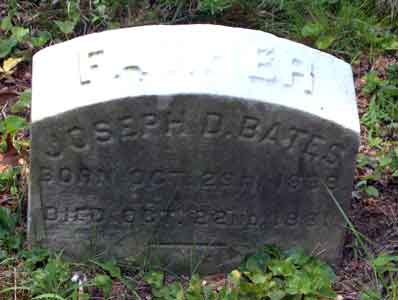
BATES, JOSEPH D. (1841-1881). First lieutenant, 56th Regiment, New York State National Guard, Company I; private, 13th Regiment, New York State Militia, Company G. Bates, a native of New York, served for three months in the 13th Regiment, New York State Militia, in 1861. He returned to the same unit and company on May 28, 1862, at Brooklyn, served for three months, and mustered out there on September 12. In 1863, he was commissioned first lieutenant on June 18 and served for 30 days in the 56th Regiment, New York National Guard, mustering out on July 24 at Brooklyn. He also served in the 56th from July 11-November 26, 1864. He last lived at 4 Dean Street in Brooklyn where he died from tuberculosis. Hannah M. Bates, who is interred with him, applied for and received a widow’s pension in 1892, certificate 373,652. Section 77, lot 8688.
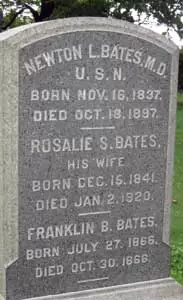
BATES, NEWTON L. (1837-1897). Surgeon, United States Navy. A New Yorker by birth, Bates entered the Navy as an assistant surgeon on July 30, 1861, and was assigned to the Seneca, a steam gunboat, in the South Atlantic Blockading Squadron from 1861-62. He was in the Mississippi Squadron in 1863, then was stationed at the Naval Laboratory at New York from 1864-1867. During that time, he was commissioned surgeon on September 16, 1865.
After the Civil War, he was fleet surgeon for the South Atlantic Station on the Portsmouth, an apprentice ship, and later on the Swatara, a steam-sloop, in the European Station. Bates also was a surgeon on the Miantonomoh and the Pawnee. Two weeks before his death, he was appointed Surgeon General of the Navy. He was also President McKinley’s personal physician. He last lived in Washington, D.C. Bates died from interstitial nephritis. Section 168, lot 20780.
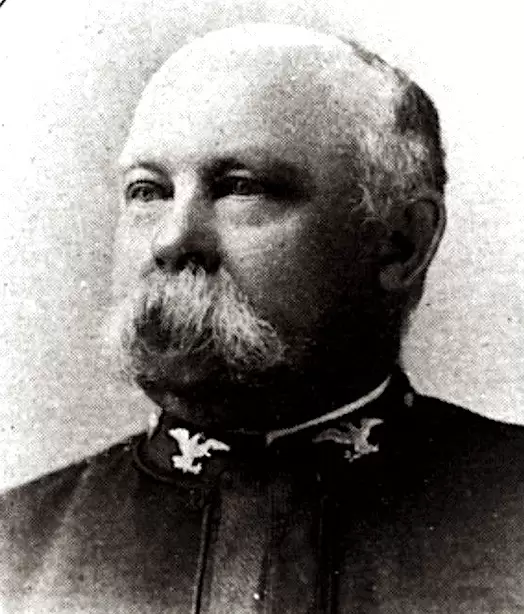
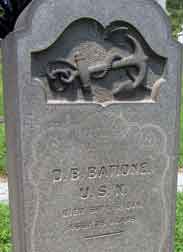
BATIONE, DOMINICK (1839-1878). Paymaster, United States Navy. Born in Spain, Batione was appointed an acting assistant paymaster on March 15, 1865. He was discharged in October 1865, but was appointed assistant paymaster in July 1866, and paymaster in August 1868. He last resided at the St. Cloud Hotel in Manhattan. Batione died from peritonitis. Section 76, lot 1087.
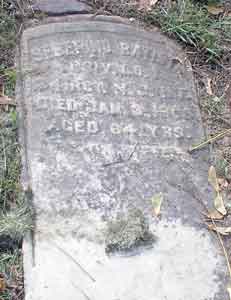
BATISTA, SEVERINO (or SABRENO) (1844-1908). Private, 34th New Jersey Infantry, Companies D and I. Originally from Cuba, he enlisted on April 10, 1865, and mustered into the Company D of the 34th New Jersey. During his time of service, Batista transferred within the 34th to Company I, and mustered out on April 9, 1866, at Mobile, Alabama. In 1899, his application for an invalid pension was approved, certificate 1,011,121. He last lived at 764 Franklin Avenue in Brooklyn. His death was caused by the flu. Shortly after his death, Mattie O. Batista applied for and received a widow’s pension, certificate 660,293. Section 4, lot 21072, grave 93.
BATTERSBY, JENYNS (or JENYUS) CHARLES (1819-1899). Colonel by brevet; lieutenant colonel, 1st New York Cavalry, Companies D and B. Born in Ireland, he immigrated to the United States in 1835, and was 5’11” when he began his military service. On July 19, 1861, he enlisted at New York City and was commissioned into the 1st New York Cavalry’s Field and Staff as a first lieutenant and adjutant. He was transferred to Company D on November 12, 1861, and to Company B on December 12, 1861. Battersby was captured in action on October 2, 1862, near Blue Gap, Virginia, where he commanded the 1st, also known as the Lincoln Cavalry, and was paroled four days later at Winchester, Virginia, and sent under the flag of truce to the federal lines near Harpers Ferry, Virginia (now West Virginia). General Robert E. Lee, Confederate States of America, wrote of his capture in a report dated October 6, 1862, “I have the honor to report that on the 2nd instant a scouting party of Colonel Imboden’s command encountered a company of the enemy’s cavalry near Hanging Rock, Hampshire County, and captured Captain [Jenyns Charles] Battersby, Company B, First New York Cavalry, 5 of his men, 14 horses, with arms, equipments, &c…”
On February 28, 1863, Battersby was listed as having been absent without leave as of February 5, and was listed as under arrest at Harpers Ferry on December 31, 1863. Nevertheless, after being commissioned as captain of Company B on April 1, 1864, he rose to major on December 13, 1864, retroactive to November 20, having been appointed acting inspector general of the 2nd Brigade on November 6, a position he was still holding as of December 31. He was promoted to lieutenant colonel on January 14, 1865, retroactive to December 1, 1864. In February 1865, as lieutenant colonel, he commanded the 1st Cavalry in a skirmish at Mt. Crawford, Virginia. During the Appomattox Campaign in Virginia, he commanded the 1st from March 28 to April 9, 1865. The division commander was George Armstrong Custer. On June 6, 1865, while in the line of duty at Clouds Mills, Virginia, he “was thrown from his horse causing injury to the abdomen, producing in time rupture of the left groin, resulting finally in the rupture of both sides.” He mustered out at Alexandria, Virginia, on June 27, 1865. On September 21, 1865, he was brevetted colonel with the following citation, “for gallant and meritorious conduct at Nineveh, Mt. Crawford, Waynesboro and other battles during the War.” From November 18 to December 30, 1865, he was treated at St. Luke’s Hospital in New York City for diarrhea, fistula, and liver inflammation, complications of his wartime abdominal injury.
Battersby spent the last years of his life working on a painting of Grant and Lee at Appomattox. The painting was the subject of an 1892 Christmas story written by Edith Sessions Tupper in Collier’s Weekly. Battersby sought damages for libel, stating that he was ridiculed in the article. Ultimately, he received $2,000 in damages (he sought $25,000) but that was reversed on appeal. In 1890, he applied for an invalid pension that was granted on account of his deafness, certificate 649,623. By 1898, his injuries, and deafness in both ears resulted in total disability. He died in Clifton Springs, New York. Section 206, lot 30057, grave 2.
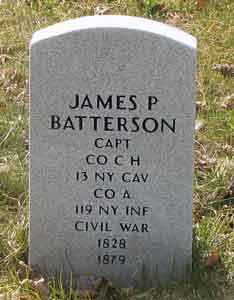
BATTERSON, JAMES P. (1828-1879). Captain, 119th New York Infantry, Company A; 13th New York Cavalry, Companies H and C. On June 26, 1862, Ohio-born Batterson mustered into the 119th as a first lieutenant but was not commissioned. Commissioned a captain on August 5, 1862, he was discharged on December 6, 1862, at Fairfax, Virginia. He re-enlisted at New York City on March 3, 1863, mustered in as a captain and was commissioned into the 13th New York Cavalry on August 7, 1863. He resigned on February 15, 1864.
As per the New York City Directory for 1876-1878, he was in the furniture business and his home was at 531 Eighth Avenue in Manhattan. He last lived at that Eighth Avenue address at the time of his death from heart disease. His wife, Letitia Batterson, applied for and received a widow’s pension, certificate 347,290. Section 15, lot 17263, grave 177.
BATTLE, THOMAS (1830-1876). Private, 15th New York Light Artillery; 32nd New York Light Artillery. A Canadian by birth, he enlisted as a private on September 11, 1861, at New York City, and mustered into the 15th New York Light Artillery on November 8 (company not stated). He re-enlisted on February 23, 1863, and transferred into the 32nd Light Artillery on February 4, 1865. The place and date of discharge are unknown. He last lived at 665 10th Avenue in Manhattan. Battle died from cirrhosis. Section 115, lot 11193, grave 234.
BATTY, GEORGE W. (1839-1884). Sergeant, 155th New York Infantry, Company E. A New York native, Batty enlisted at New York City as a sergeant on September 26, 1862, and mustered into the 155th New York on November 18. He was wounded at Spotsylvania Court House, Virginia, on May 18, 1864, and mustered out in absentia on July 15, 1865, at Washington, D.C. He last resided at 58 Montgomery Street in New York City where he died from tuberculosis. Section D, lot 7078, grave 198.
BAUER, ERNST (1836-1890). Private, 45th New York Infantry, Unassigned Company. A native of Germany, Bauer enlisted as a private at Tarrytown, New York, on January 10, 1865, and mustered immediately into the 45th New York; he was not assigned to any company. As per his muster roll, he was a carpenter who was 5′ 9¾” tall with grey eyes, brown hair and a fair complexion. He mustered out on May 7, 1865, at Hart’s Island, New York Harbor.
The 1875 New York State census indicates that Bauer was married with three children, worked as a butcher, and lived in Brooklyn. The 1880 Manufactures Schedule for Brooklyn notes that he was producing calf rennet for cheese. He had $1,250 invested in his business, employed four people who worked ten hour days, had paid $350 to his employees, had $1,800 in materials, and produced $3,000 of product. Bauer became a naturalized citizen in 1878. He last lived on Morrell Street in Brooklyn. The cause of his death was chronic nephritis. Section 59, lot 1877, grave 46.
BAUMANN, FREDERICK (or FREDERICKE) (1834-1887). Private, 178th New York Infantry, Company I. Of German birth, he enlisted as a private at New York City on August 29, 1863, mustered into the 178th on September 3, and deserted a month later on October 14 at New York City. He last lived at 145 Penn Street in Brooklyn. Baumann died from tuberculosis. Section 188, lot 19628.
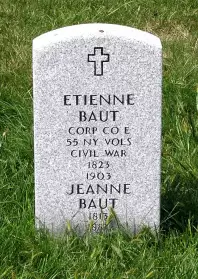
BAUT, ETIENNE (or ELTINE, ETTINE) (1823-1903). Corporal, 55th New York Infantry, Companies C and D; private, 142nd New York Infantry, Company K; 169th New York Infantry, Company E. Originally from France, he immigrated to the United States in 1854 and was a crimper (hair-dresser) by trade. He enlisted as a private at Staten Island on August 1, 1861, mustered into the 55th New York on August 28, 1861, and was promoted to corporal on January 18, 1862. Transferred to Company D on October 1, 1862, he was discharged for disability on December 25, 1862, at Point Lookout, Maryland.
Baut later re-enlisted as a private at New York City under the name of Eltine Baut on March 5, 1865, mustered immediately into the 142nd New York, and was transferred into the 169th on June 7 (as Ettine Baut). On July 19, 1865, he mustered out at Raleigh, North Carolina. His last residence was 229 Sullivan Street, Manhattan. Baut died from gangrene. Section A, lot 8100, grave 244.
BAYLES, NATHANIEL HARVEY (1819-1883). First lieutenant, 4th New York Infantry, Companies H and K. A New York City native, Bayles was working in the ship-stores business as per the New York City Directory of 1857. During the Civil War, he enlisted as a second lieutenant on April 24, 1862, and was commissioned that day into Company H of the 4th New York Infantry. At that time, he was stationed at Fort McHenry, Maryland. On December 1, 1862, he was promoted to first lieutenant and simultaneously transferred into Company K. His muster roll states that he was on Signal Service at Suffolk, Virginia. He mustered out on July 30, 1863, at New York City.
According to the census of 1870, Bayles was an oil manufacturer living in Brooklyn; the New York City Directories for 1872 and 1873 indicate that he was employed in “oils” and the 1880 census lists “no occupation.” He last lived at 140 Putnam Avenue in Brooklyn. Bayles died from cholera morbus (gastro-intestinal disease). In 1890, his wife applied for and received a widow’s pension, certificate 349,178. Section 74, lot 11187.
BAYNHAM (or BAYNHAN), THOMAS (1845-1891). Private, 14th Infantry, United States Army, Company D. Originally from Ireland, Baynham was 16 when he enlisted in the United States Army. He served from 1861 until 1865 in Company D of the 14th Infantry of the Regular United States Army. Baynham is listed as a machinist in the New York City Directory for 1885-1886 with a home address at 273 East 4th Street in Manhattan and in the 1891 New York City Directory with a home address at 330 East 4th Street. He died from bronchitis. Section 204, lot 29742, grave 21.
BEACH, BENJAMIN FRANKLIN (1834-1862). First lieutenant, 73rd New York Infantry, Company C. Beach, who was born in New York State, enlisted at Camp Scott, New York, as a first lieutenant, on July 5, 1861, and was commissioned into the 73rd New York on October 8. He was killed in action at Williamsburg, Virginia, on May 5, 1862, and was interred at Green-Wood on May 22 of that year. His last address was on West 25th Street in Manhattan. Section 73, lot 887.
BEACH, EDWARD (1840-1910). Private, 6th New York Cavalry, Company B. A native New Yorker, Beach was a plumber at the time of his enlistment. He enlisted as a private on August 11, 1862, at New York City, and mustered immediately into Company B of the 6th New York Cavalry. Wounded on September 11, 1863, at Raccoon Ford, Virginia, he was discharged on June 5, 1865, at Cloud’s Mills, Virginia.
In 1874, Beach applied for and received an invalid pension under certificate 956,141. He belonged to G.A.R. Post #266. Although his name was not listed in the 1890 Veterans Schedule, he was listed in the G.A.R. Mortuary Table as a member of the 6th New York Cavalry. His last address was 487 East 134th Street in the Bronx. He died from heart disease at New York Hospital. Section 6, lot 20118, grave 523.
BEACH, JAMES S. (1835-1900). Private, 71st Regiment, New York State Militia, Company F. A native of New York, he enlisted on April 19, 1861, mustered into the 71st and served from May 3, 1861 through July 31, 1861. His last residence was on West 4th Street in Manhattan. Beach died from heart disease. Section 2, lot 5499, grave 1160.
BEACH, LEWIS (1835-1886). Private, 96th New York Infantry, Company A. A native of New York City, he enlisted at Chateaugay, New York, as a private, on November 23, 1861. On that date, he mustered into Company A of the 96th New York from which he deserted on February 20, 1862, at Plattsburg, New York. His last address was in Cornwall in Orange County, New York. Beach died from typhoid disease. Section 32, lot 12945.
BEACH, WARREN CARPENTER (1844-1922). Captain, 11th Infantry, United States Army. Warren Carpenter Beach was born on February 10, 1844, in Saratoga, New York to William Augustus Beach and Ann Eliza Porter Beach. He joined brothers Miles, John and William. Eleven years later, according to the 1855 New York State census, the Beaches were living in Troy, New York in a household that included the four brothers, along with a younger sister Ann. That census also lists four other people at the same address: Rosanna McCollum, Ann Kelly, Catherine Donavan and Henry Curtis.
In the 1865 New York State census, 21-year-old Warren listed his residence in Troy, New York with his family, even though by that year he had graduated from West Point and was assigned to the 15th Infantry.
Thirty-one-year-old Warren was living in Billings, Dakota Territory, according to the census of 1880. His occupation is listed as captain in the United States Army. There is no mention of family members; however, in 1883, according to the Ancestry websiterecords, Warren was back in Manhattan and married to Julia Norrie, “daughter of a prominent New York City family” (New York Herald obituary, January 16, 1922).
Warren spent approximately 21 years in the United States Army and throughout his years of service, he steadily climbed through ranks and responsibilities. According to the United States Army Historical Register, he entered West Point in1861 and graduated in1865 with the rank of second lieutenant. Upon graduation, Warren was assigned to the 15th Infantry. During the year that he served in the 15th Infantry, he was promoted to 1st lieutenant. In 1866, Warren was transferred to the 24th Infantry where he served as a recruiter adjutant. Typically adjutants provided administrative and support services that may include maintaining personnel records and recording orders, as well as other administrative and support duties (National Archives, Records of the Adjutant General’s Office, 1780’s-1917). He was transferred again in 1869 to the 11th Infantry. By 1873, Warren was listed in the 24th Infantry and had been promoted to captain. He served in that rank until he resigned from the Army in 1886.
The New York Herald obituary noted that Warren spent many years serving on Governors Island in New York Harbor. During the Civil War and until the early 1900s, Governors Island was a recruitment depot and barracks, and later in the war it became a prisoner-of-war holding facility. After the war, Governors Island was turned into an army headquarters and garrison (govisland.com). Since Warren’s service ranged from 1865 to 1886, it seems likely that his role as a recruiter adjutant meant that he kept administrative records and provided support to senior officers on the island.
According to the 1910 census records, Warren (50) and Julia (49) were living in their own home in Washington, D.C. Warren listed his occupation as “soldier,” but noted his employment as “wage earner.” But by 1920, Warren and Julia had moved back to New York City and were living in an apartment on 5th Avenue in Manhattan.
During his life in Manhattan, Warren was active in the city’s social life. The New York Herald obituary noted that he was a member of the Union Club, which according to its entry in Wikipedia, was considered “the most thoroughly aristocratic private institution in the city.” Interestingly, “From the beginning, the Union Club was known for its strongly conservative principles. During the Civil War, the club refused to expel its Confederate members, despite taking a strong line on suppressing anti-draft riots.”
Warren also belonged to the Players Club – a club for artists and arts lovers, and the Metropolitan Club of both New York City and Washington, D.C. The Metropolitan Club was “founded as a gentlemen’s club in March 1891 by a group of wealthy New Yorkers led by the financier John Pierpont Morgan,” according to Wikipedia.
Warren had a box at the Metropolitan Opera, according to his obituary, where he attended performances regularly. He was known to bring red carnations to performances, which he threw to the prima donna. It was after a walk home from the opera on January 13, 1922, that Warren died at the age of 77 in the lobby of his 585 Fifth Avenue apartment building. His brother-in-law, Dr. Van Horne Norrie, was called and he pronounced Warren dead of heart failure, according to the New York Herald obituary. Warren’s wife Julia had died the previous August; they had no children and are interred together. Section 139, lot 13368.
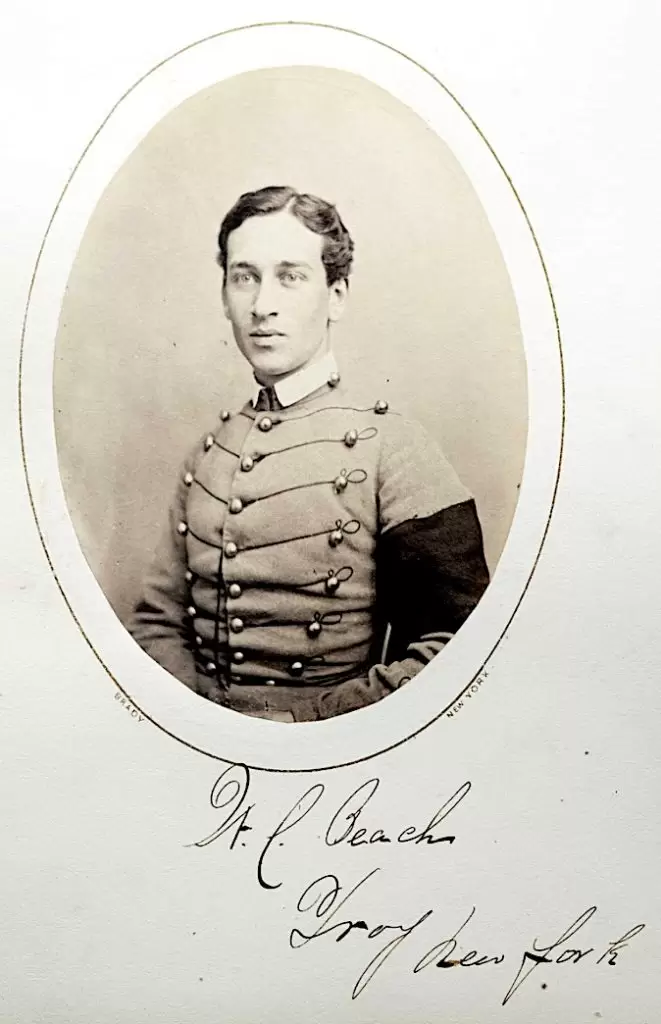
BEADLE, HARRY HOBART (1828-1902). First lieutenant, 13th Regiment, New York State National Guard, Company F. Born in Wallingford, Connecticut, Beadle worked for the Meriden (Connecticut) Cutlery Company before moving to Brooklyn in 1856. He is listed as a clerk in the Brooklyn Directory for 1858.
During the Civil War, he enlisted as a private in Company F, 13th Regiment, on December 30, 1861, and on the following January 4, was commissioned second lieutenant. As per his obituaries in the Brooklyn Daily Eagle and The New York Times, Company F originated from what known as the Carroll Guard, a group that drilled in the Sunday school room of the South Congregational Church. On May 26, 1862, he mustered into service with his regiment, which formed part of the reserves, and was not called into active service. On September 12, 1862, he mustered out with his company at Brooklyn, and on October 6, 1863, and was promoted to first lieutenant.
In civilian life, Beadle is listed in the cutlery business in the Brooklyn Directory for 1866 and in the New York City Directories for 1875-1878. Still active in military affairs, he was made captain of his regiment on March 7, 1868, and elected lieutenant colonel of his regiment on November 10, 1876. On December 30, 1878, he was brevetted colonel prior to his honorable discharge on October 20, 1879. The Brooklyn Daily Eagle noted that he was in command of his regiment at the time of the Brooklyn Theater fire. He was a member of the G.A.R., Ulysses S. Grant Post #327, and the Thirteenth Regiment Veteran Association, helping to organize the latter organization; he was president of the Veteran Association at the time of his death.
A musician, he was the organist for his church for twenty-eight years. He resided in Brooklyn at the time of his death from heart disease. As per his obituary in the Brooklyn Daily Eagle, he died suddenly at his home at 329 Union Street after dressing and saying that he felt “quite well.” The Eagle reported that he was at his desk at the Water Registrar’s office the day before and had been a clerk there for some time; that obituary noted that he had been ailing for about six months but had spent Thanksgiving with his family and was feeling much better. Beadle’s obituary in the New York Herald notes that his funeral took place at the South Congregational Church at the corner of Court and President Streets in Brooklyn. In 1907, his widow, Mary A. Beadle, applied for and was granted a pension, certificate 655,762. He was also survived by two sons, Harry W. and William, and a daughter, identified as Mrs. Schemedlin, whose husband was a captain of the 13th Regiment. Section 205, lot 31290, grave 2.
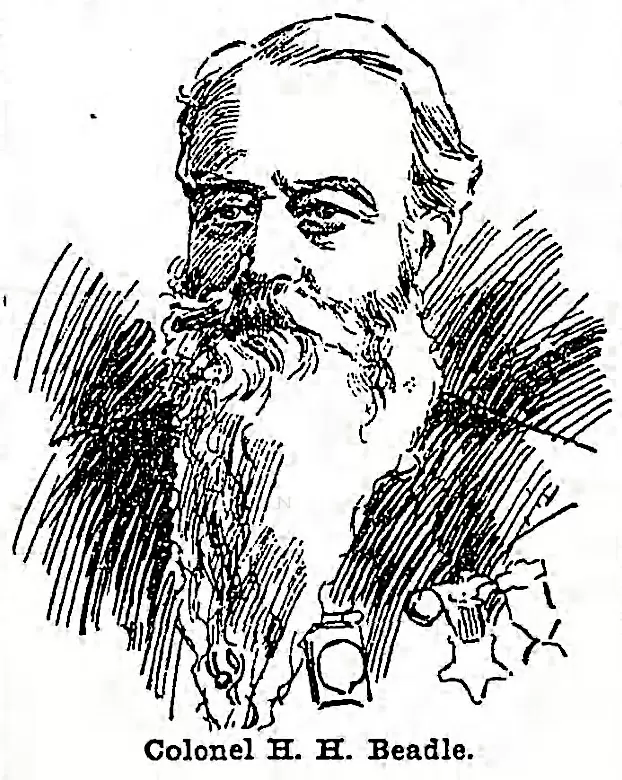
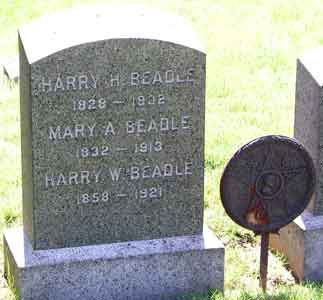
BEAL, JR., GEORGE WASHINGTON (or U). (1839-1909). Rank unknown, 13th Regiment, New York State Militia, Company H. As per his obituary in the Brooklyn Citizen, Beal was born in Saratoga County, New York, in 1838: his online family history and the 1900 census note 1839 as his birth year and his birthplace as Brooklyn. His parents were Dr. George and Elenor “Lany” Arnold Beal. The aforementioned family history shows that the family lived in Clifton Park in Saratoga at the time of the 1840 and 1850 federal censuses and the New York State 1855 census.
According to the 1840 census, seven free persons, two adults and five children, lived at his Clifton Park. The 1850 census reports that George attended school, lived in Clifton Park with parents George and Sary (sic) and had six siblings. The 1855 New York State census, which lists the mother’s name as Lany, shows that George was 17 and living at home with five siblings. George married Elizabeth Catherine Shiver McKiney in May 1859. By 1860, Beal lived in Williamsburg(h), Brooklyn; his wife is not listed in the same household.
As per his application for an invalid pension, George served in Company H of the 13th Regiment, New York State Militia and used the alias of William G. Beal. His Draft Registration Record, filed in June 1863, reports that he was a twenty-five-year-old clerk. He then lived at 272 South 5th Street in Brooklyn.
At the time of the 1870 census, George was living in Brooklyn with his wife Elizabeth and children, Caroline (9), William (7), Francis (3) and Sarah (6 months); he was working as a house painter. Sarah is mentioned as a child in the New Jersey Episcopal Diocese of Newark Church records as are her parents, George Washington Beal and Elizabeth Schriber (sic). The 1875 New York State census shows the family still living in Brooklyn; Francis is not named on that census. At the time of the 1880 census, George and his wife, called Libby, had a new daughter, Hattie, aged 2; they were living at 428 Fourth Avenue and George still worked as a painter. The 1900 census documents that the Beals were married 41 years, owned their home at 166 Sheffield Avenue and George still worked as a painter. Their daughters, Sarah and Hattie (Harriet), lived at home as did Sadie (age 13) and Randolph (age 9) (relationship unstated). The 1905 New York State census shows the Beals living in Brooklyn with their son Edward (age 38).
In 1891, Beal filed for and received an invalid pension, certificate 1,075,405. Beal was a member of Winchester Post #197 of the G.A.R. and the United Order of Workmen. As per his obituary in the Brooklyn Citizen, which confirms his Civil War service, Beal was a resident of Brooklyn for about fifty years. He had been in the painting business. His sudden death, attributed to heart disease, took place at 1033 Sutter Avenue. That obituary reports that he was survived by daughters, Sadie Foss and Carrie Casler, and a son, Edward. His grave is in the same lot as the Casler family. His death certificate confirms that he was married and was a painter. In June 1909, shortly after his death, Elizabeth Beal filed for and received a widow’s pension, certificate 688,057. Section 200, lot 2437.
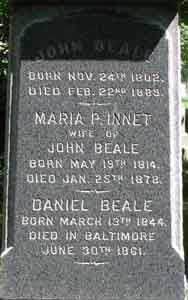
BEALE (or BEAL), DANIEL (1844-1861). Private, 13th Regiment, New York State Militia, Company E. Daniel was born on March 13, 1844, in Brooklyn. Census records reveal a remarkably stable home life. According to the 1850, 1855, and 1860 censuses, Daniel lived at 312 Degraw Street in Brooklyn, a brick home owned by his father John, originally of Maine. John was a grocer. Daniel, who lived there with his mother, Maria, and his aunt, Ann Noyes, grew up with his two older brothers, John and Frederick, as well as his cousin, Ellen Noyes, who was the same age as Daniel. All the children attended school. The family retained the services of the same servant, Elizabeth Farrel, originally of Ireland, for all 10 years. About the only change across this time is the value of the family estate increasing from $6,000 in 1850 to $10,000 in 1860. In the 1860 catalog of the Brooklyn Collegiate and Polytechnic Institute, Daniel is listed as a senior.
Daniel likely enlisted in April 1861 when the 13th Regiment was organized under the command of Colonel Abel Smith, or possibly in May when 300 reinforcements were added. The 13th was stationed in Maryland. There Daniel quickly contracted typhoid fever and died in the Baltimore Infirmary on June 30, 1861. His regiment-mate wrote a scathing letter that day which was published in the Brooklyn Daily Eagle on July 5, 1861. He describes the regiment’s anger towards their colonel, specifically for his refusal to let anyone notify Daniel’s parents that he was sick. The only reason John Beale found out about his son’s illness was due to “one of the boys of one of the other companies had written to his father.” John arrived the day before Daniel died.
The aforementioned letter written that day that was critical of the colonel of the 13th Regiment, a comrade of Beale wrote in a private letter in Letters From The Seat Of War:
I will tell you one thing he done; there were four men in our company in the hospital in the city, one of them was not expected to live from one moment to another, and he would not let a man from our company go the telegraph office to notify his folks nor any one else, and he would not go himself; one of the boys of one of the other companies had written to his father; it was the only way he found out his son was sick; his father arrived yesterday, and his son, the one that was sick, died this morning at 4 o’clock; his name is Daniel Beale and is to go home to-night; the Colonel will not let any of our company go and see him, only our Captains and Lieutenants. Now, what do you think of that? The Colonel has been brought before Gen. Banks several times since we have been here for what, I do not know. If swearing will ruin a man there will be at least 900 ruined men in Brooklyn when the 13th arrives. And all just on his account…
In an article the next day, July 6, 1861, in the Brooklyn Evening Star, we receive more information about the strife between the enlisted men and the officers of the 13th regiment: the “matter most neglected is the surgical department.” Surgeons were at home, replaced by “shadows” and medicine was in short supply. Some of the doctors did not “know the difference between castor oil and oil of vitriol.” The telegraph alerting Daniel Beale’s family to his illness is mentioned as well as the fact that the telegraph “should not have lain three days on the table of the Colonel.” There is some blame pointed at the officers for not recognizing Daniel’s fever sooner and letting him rest more. The Baltimore Infirmary receives “lavish” praise from Daniel’s friends, though. The “noble institution” at the “corner of Greene and Lombard streets” was staffed by “ministering angels,” the “sisters of charity,” and “everything within the reach of human art and effort is done to preserve life, even death is made to descend with every alleviation of love and sympathy.”
John Beale returned his son’s body to their home at 312 Degraw Street where the funeral was held on July 2, 1861. He was interred that same day. Section 98, lot 63.
BEALL, JOHN YATES (1833-1865). Captain, Confederate Navy; private, 2nd Virginia Infantry, Confederate States of America, Company G. Beall was originally interred at Green-Wood; his family claimed his remains in 1869 and had them removed. Born in Jefferson County, Virginia, in the Shenandoah Valley into a wealthy Virginia family, his own fortune was estimated at $1 million. Educated at the University of Virginia, he studied law but returned to the family farm in 1855. He joined the Confederate Army when the Civil War began. At that time, he was 5′ 8″ tall with a fair complexion, blue eyes and brown hair. Beall enlisted as a private at Charlestown, Virginia, on April 18, 1861, and mustered into Company G of the 2nd Virginia, known familiarly as Bott’s Grays, on May 11, 1861, at Harpers Ferry, Virginia. He fought at First Bull Run, Virginia, as part of the Stonewall Brigade, was severely wounded in the chest at Harpers Ferry on October 17, 1861, when he led a company of General Turner Ashby’s cavalry in the Shenandoah Valley, and was listed as absent on the rolls for November and December 1861. His wounds left him unable to participate in active service.
Discharged on February 18, 1863, Beall later joined the Confederate Navy as an acting master; he and his men attacked Union ships on Chesapeake Bay. Not given a command, he proceeded to act as a privateer. But, after he and his men captured several commercial ships including a sloop carrying $200,000 worth of sutler’s stores bound for Port Royal, South Carolina, they were captured on November 16, 1863, at Accomack County, Virginia. Imprisoned at Fortress Monroe on January 6, 1864, they were held as pirates, rather than as prisoners of war. But, after Jefferson Davis ordered that Union prisoners be treated as pirates in retaliation, Beall was transferred to Norfolk on February 27, 1864, and from there was exchanged on March 17. Beall, who fought under Stonewall Jackson, was commissioned captain at some point. Just before his exchange he wrote this letter on March 11, 1864:
“Sir, When I was captured Capt. Graham Provost Marshal of Drummondtown took my commission, other private papers and money also the things of my crew. He promised to return them but has not done so. When at Fort McHenry, money and necessary clothing by permission of the military authorities were sent us. The money was not exhausted on our departure and some things went to the Fort McHenry after our departure. We cannot get the money or things. I appeal to you that my commission may be returned, and also my money and things especially those sent to us. John Y. Beall”
Beall later made his way to Canada, which he used as a base for attacks into the United States. Among the plans were disrupting Northern trade on Lake Erie, freeing prisoners held at Johnson’s Island off Lake Erie, and overpowering the USS Michigan which was stationed there to protect the area. The latter plan was foiled on September 19, 1864, when Charles Cole, a guest on the Michigan who was supposed to signal Beall, was discovered and arrested. Beall, who was in command of the Philo Parsons, a passenger ship that he captured, was forced to pull back when his crew mutinied, and returned to Sandwich, Canada, where the Philo Parsons was destroyed. He was again captured on December 16, 1864, after attempting to free Confederate prisoners by derailing a passenger train, but this time he was put on trial on January 17, 1865, for “violation of the laws of War.” Found guilty and sentenced to hang, appeals were made to President Lincoln that he be spared. But they were unavailing, and on February 25, 1865, John Yates Beall was executed on Governor’s Island in New York Harbor. This account of the execution appeared in The Richmond Examiner on Wednesday, March 1, 1865:
EXECUTION OF CAPTAIN BEALL
True to their cowardly instincts, the Yankees carried out their mad purpose of hanging Captain Beall on last Friday. The Yankees, it will be recollected, trumped up the charge against him of being “a spy and guerilla,” but the truth is, he was merely a prisoner of war. Captain Beall is a native of Jefferson County, Virginia, and was about thirty-two years old. He was educated at Virginia University, and at the breaking out of the war he joined the army and became a captain in the Second Virginia Infantry, serving a part of the time under “Stonewall Jackson.” He remained in that branch of the service until last year, when he received a commission in the navy, and going to Canada, assisted, in September last, to seize the steamer Parsons, on Lake Erie. The steamer Island Queen was also seized by Beall and his party, all of whom had gone on board as citizens. They scuttled the Island Queen, and subsequently attempted to get possession of the United States steamer Michigan, with the design as it afterwards appeared, of liberating the prisoners on Johnson’s Island. This plan was frustrated, and Beall was afterwards arrested near Niagara Falls, and in February was convicted by a Yankee court-martial as a “guerilla and spy.” For this gallant service for his country he met with a felon’s doom. He was hanged off New York on last Friday. He met his fate with the most terrible courage. From a long account of his execution in the New York papers, we make the following extracts:
BEALL’S APPEARANCE AND CONDUCT
Beall was of medium size; had light coloured hair and moustache, blue eyes, and his countenance wore a pleasant expression. He was a determined rebel. Though a person of much intelligence he was almost blindly devoted to the cause of Jeff. Davis, and did not scruple to help it forward by any means in his power.
After his conviction he was taken from Fort Lafayette, where he had previously been confined, and placed in the “garrison,” a prison in Fort Columbus, on Governor’s Island. On Wednesday, before the time first appointed for his execution he was put into a cell and closely guarded.
During his imprisonment he has at no time been disorderly, but has treated the officers in charge of him with uniform courtesy, and sometimes conversed freely. He did not at any time waver, but declared that he had done right, and that his death would be that of a patriot.
On Saturday last Beall’s mother arrived here from Harpers Ferry [West Virginia], near where the family resided, and obtaining a pass from General Dix, saw the prisoner. She remained with him for a considerable time; but it is understood returned southward immediately, and did not see him afterwards.
Three clergymen-two of the Roman Catholic church, and one of the Episcopal (Rev. D. Weston) – have visited Beall by his request, and a few other acquaintances or friends have seen him.
It appears that Beall was a religious man; he belonged to the Episcopal church, and was once a lay member of the Diocesian convention of his state. Twice on Friday he took the sacrament, administered by Dr. Weston.
In the course of the morning Beall expressed a desire to have a photographic picture of himself made, and his wish was complied with.
PREPARATION FOR EXECUTION
Shortly before one o’clock Friday afternoon Captain Talman, who had charge of the arrangements for the execution, United States Marshal Murray, who was present by request, and the executioner, entered the cell of the condemned man.
He promptly rose and said he was at their service. He added that he knew their errand, and said he wished the work to be done quickly.
A moment afterwards he remarked: “It is only a question of muscular power-
I think I can bear it.”
His arms were then pinioned, a military cape was thrown over his shoulders, a black cap was put on his head, and the officers and the prisoner emerged from the cell and took their place between two lines of soldiers, who formed the guard to the place of execution.
THE MARCH TO THE SCAFFOLD
Beall marched out of the garrison by the side of Dr. Weston, who read the commendatory prayer from the Episcopal liturgy.
The Marshal and the executioner and two friends of the prisoner followed. Beall marched with a firm step in the direction of the gallows, which had been erected on the south side of Fort Columbus.
As he ascended the brow of a hill, from which the gallows frame was visible he looked hurriedly at the instrument and seemed to smile.
The preparations had not been completed, and a halt on the hill was ordered. At this point he talked with his spiritual adviser. Looking upward, he remarked that the day way a pleasant one. Immediately he added: “The sun shines brightly. I now see it for the last time.” He was, however, perfectly calm and composed. The order was then read by the Post Adjutant, Lieutenant Keiser, Second United States Infantry.
When the Adjutant had finished, Rev. Dr. Weston intoned aloud the prayer for the dead, the soldiers listening with breathless anxiety, and many tears running down their cheeks.
THE LAST WORDS
Marshal Murray and the Provost Marshal of the fort stepping up, asked the prisoner if he had anything to say, to which he replied:
“I protest against the execution of the sentence. It is absolute murder-brutal murder. I die in the defense and service of my country.”
Before the cap was drawn over his eyes, on being asked if he wished to say anything further, he said, “No, I beg you to make haste.”
THE EXECUTION
At thirteen minutes past one o’clock the black cap was drawn over the culprit’s face, the Provost Marshal drew his sword, a noise was heard from inside the box, and the form of John Y. Beall was dangling in the air. The only movement noticeable in the body was a convulsive movement of the right leg, a shrugging in the shoulders and a few twitches of the hand.
After hanging just twenty minutes the body was lowered down, when a medical examination by Dr. Connor, United States Army, proved that the neck was broken instantly, thus ending the earthly career of Beall without any agony. It was then taken to the hospital, whence it will be given to the friends of the deceased for interment.
On March 22, 1870, his remains were reinterred in the Zion Episcopal Church graveyard in Charles Town, West Virginia.
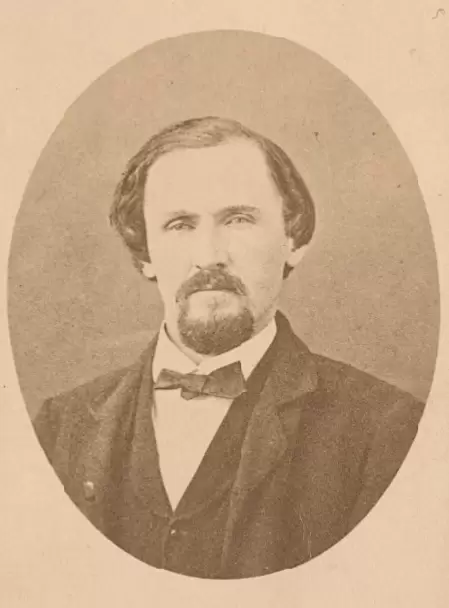

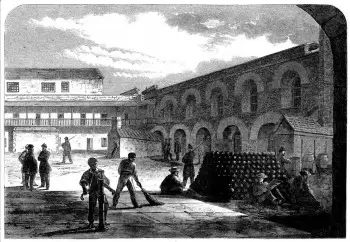
BEAM, PETER MEAD (1846-1910). Acting master’s mate, United States Navy. A Brooklyn native, he served as an acting master’s mate in the Navy during the Civil War. There are no further details about his service. At the time of his marriage in 1883, he was working on a railroad. Beam was a member of Charles H. Burtis Post #185 of the G.A.R. In 1898, his application for a pension from the United States Navy was approved under certificate 25,683. He last lived at 1081 Hancock Street in Brooklyn. Beam’s death was attributed to cancer. Mary Beam, his second wife, applied for and received a widow’s pension from the United States Navy of $15 per month as of February 1910, certificate 21,189. Section 138, lot 25964, grave 1.
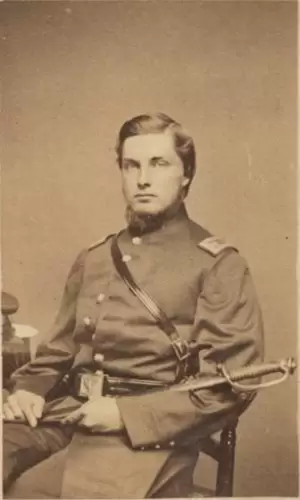
BEARDSLEE (or BEARDSLEY), FREDERICK E. (1844-1888). Captain and assistant quartermaster, United States Volunteers Quartermaster’s Department; second lieutenant, Signal Corps, United States Army. Born in Rochester, New York, he was a graduate of Rensselaer Polytechnic Institute in Troy, New York. On November 19, 1862, he enlisted as a captain and was simultaneously promoted to captain and assistant quartermaster when he was commissioned into the United States Quartermaster’s Department that day. His father, an electrician, invented a magneto-electric generator that was patented in 1859. Together with his father, he developed the telegraph system used by the Army of the Potomac.
He was commissioned as a second lieutenant in the Signal Corps, United States Army, as of March 3, 1863. A photo of Beardslee in a report by Lemuel B. Norton, Captain of the Signal Corps, Army of the Potomac, from Gettysburg, Pennsylvania, had an inscription stating that Beardslee commanded the signal room at that battle and was in charge of field telegraph at Phillip’s House at the Battle of Fredericksburg, Virginia, and then in charge of the telegraph line between Fredericksburg and Bank’s Ford during the famous “Mud March.” In his report, Norton detailed how lines of communication were in place to reach commanding generals and kept in place through July 6, 1863, in case the enemy returned. He was promoted by brevet to first lieutenant and captain on March 13, 1865, and mustered out on August 12, 1865.
According to the 1870 census, Beardslee was living in College Point, New York, and was an assistant inspector on the railroad. In 1876, he worked for a German firm in Mexico and was in charge of operations there for many years. His death, a suicide, was attributed to poisoning by prussic acid at 76 Beekman Street in New York City, at the Denison Laboratory where he worked. According to pension records, he suffered from depression. An article about his death in The New York Times, called him a well-known electrician and chemist who was among the first to experiment with the telephone. The article also stated that his financial situation was troubling him and that he left a final note to his wife. His last residence was 178 Willoughby Avenue in Brooklyn. In 1889, his wife applied for and was granted a widow’s pension, certificate 337,308. Section 6, lot 20118, grave 454.
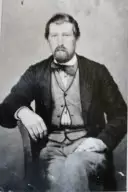
BEARDSLEY, CHARLES H. (1840-1892). First sergeant, 170th New York Infantry, Companies G and E. Serving with the 170th New York, Beardsley enlisted on September 12, 1862, as a private, and mustered into Company G on October 7. After he was promoted to corporal on an unstated date, he was reduced in rank to private, and was promoted to sergeant on April 8, 1863. On June 16, 1864, he was wounded in action at Petersburg, Virginia. On November 1, 1864, he was promoted to sergeant for a second time, and then on March 1, 1865, he was promoted to first sergeant. His pension record indicates that he also served in Company E of the 170th but the date of that intra-regimental transfer is not stated. He mustered out at Washington, D.C, on July 7, 1865.
Beardsley’s application for a pension was granted in 1884, certificate 666,052. He last lived at 211 11th Street in Brooklyn. His death was caused by emphysema. Elizabeth Beardsley, who is interred with him, received a widow’s pension upon his death in 1892, certificate 371,100. Section 147, lot 21895.
BEARNS, JR., FREDERICK (1837-1870). Private, 84th New York (14th Brooklyn) Infantry, Company D. Born in New York State, Bearns enlisted at Brooklyn as a private on May 18, 1861, and mustered into the 14th Brooklyn eight days later. He was discharged for disability at Washington, D.C., on October 31, 1862. He last lived at 99 Walworth Avenue in Brooklyn where he succumbed to congestion of the brain. Section 10, lot 2121.
BEARNS, HENRY MATHEW (or H. M.) (1840-1912). Private, 8th Regiment, New York State Militia, Company B. Bearns served in the 8th Regiment for three months in 1861. The 1890 Veterans Census confirms his Civil War service. As per the 1891 Brooklyn Directory, a Henry M. Bearns, who may have been the soldier, worked in the news business on Broadway and lived at 208 Rutledge Street. His death certificate notes that he was a widower who had been a farmer in Oceanside, Long Island. He died at 956 Covert Avenue in Ridgemond Heights in Queens. His death was attributed to lobar pneumonia. Section 10, lot 2481.
BEATTY, JAMES (1844-1873). Private, 65th New York Infantry, Company E. Beatty, who was born in New York State, enlisted as a private at Jamaica, New York, on November 4, 1864, the same date that he mustered into Company E of the 65th New York. He deserted on June 18, 1864, at Hall’s Hill, Virginia. He last lived at 215 East 27th Street in Manhattan. Beatty died from tuberculosis. Section 17, lot 17245, grave 1232.
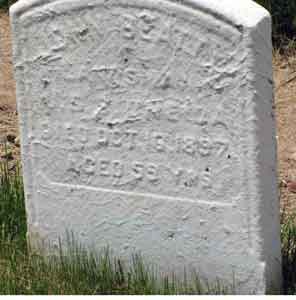
BEATTY, JOHN (1839-1897). Landsman, United States Navy. Beatty served in the United States Navy during the Civil War on the USS North Carolina, Savannah, Oneida, and Princeton. His pension application was approved, certificate 19,209. He last lived at 272 56th Street in Brooklyn. Beatty died from tuberculosis. Agnes Beatty applied for and was awarded a widow’s pension in 1898, certificate 12,401. Section A, lot 9146, grave 188.
BEATY (or BEATTIE), JAMES (1831-1880). Sergeant, 1st New York Engineers, Company L; private, 15th New York Engineers, Company D. After Beaty enlisted as a private at Willets Point, New York, on June 1, 1861, he mustered into the 15th Engineers on June 25, and mustered out on June 25, 1863. On February 20, 1864, he re-enlisted as a private at Brooklyn as James Beattie, and mustered immediately into the 1st New York Engineers. He rose to corporal on September 1, 1864, and to sergeant two months later on November 5. On June 30, 1865, he mustered out at Richmond, Virginia.
His application for an invalid pension, under the name James Beattie and showing service in both regiments, was granted in January 1880, certificate 572,532. He was employed as a machinist according to the New York Mortality Schedule for 1880. He last lived at 126 High Street in Brooklyn. His death was attributed to remittent fever. Section 16, lot 10205.
BEAVAN, EDWARD PRICE (1845-1920). Drummer, 23rd Regiment, New York State National Guard, Company H. A New York City native, he enlisted there as a drummer in 1863, mustered into the 23rd Regiment for its 30 day activation that year, and mustered out at the termination of his enlistment.
Beavan may have been a baseball player in Brooklyn and Staten Island from 1867-1876. According to the Brooklyn Directory for 1888-90, he was employed as a paperhanger; his father established a notable paperhanging and paint business on Gates Avenue in Brooklyn that was taken over by Edward’s brother, William Beavan (see) after his father’s death in 1883. In 1905, his application for a pension was granted under certificate 1,118,192. He last lived at 20 Greene Avenue in Brooklyn. Section 178, lot 12050.
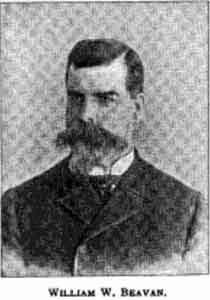
BEAVAN (or BEAVEN), WILLIAM W. (1844-1910). Drummer, 139th New York Infantry, Company C. Born in New York, Beavan enlisted as a private at Brooklyn on August 21, 1862, and mustered into the 139th New York on September 9. At some point he was promoted to drummer before he mustered out on June 19, 1865, at Richmond, Virginia.
According to the census of 1870, Beavan worked as a paperhanger. He is listed as a paperhanger in the Brooklyn Directory for 1880-1882. In 1883, he took over his father’s well-regarded paperhanging and painting establishment at 19 Gates Avenue in Brooklyn, known for decorative house-painting, custom-work, and fine designs. The Brooklyn Directory for 1884-1886, the New York Directory for 1888-1890 and the Brooklyn Directory for 1890-1892 show that he was still employed as a painter and paperhanger. In 1906, he received a pension, certificate 1,128,936. He was the brother of Edward Beavan (see). His last residence was 336 Union Street in Brooklyn. After his death from nephritis in 1910, Ann Eliza Beavan applied for and received a widow’s pension, certificate 701,855. Section 178, lot 12050.
BECHAMPS, JOSEPH H. (1839-1915). Private, 55th New York Infantry, Company A. A native New Yorker, he enlisted on August 1, 1861, at Staten Island, mustered into the 55th New York on August 28, and was discharged for disability on August 6, 1862, at Harrison’s Landing, Virginia. On February 9, 1863, he received an invalid pension, certificate 19,979.
A florist who followed into his father’s trade, Bechamps was employed in his profession as indicated by every census from 1860. According to the 1890 Veterans Schedule, he had lost the sight in his right eye. He last lived at 300 State Street in Flushing, New York. Bechamps died from heart disease. Section D, lot 19022.
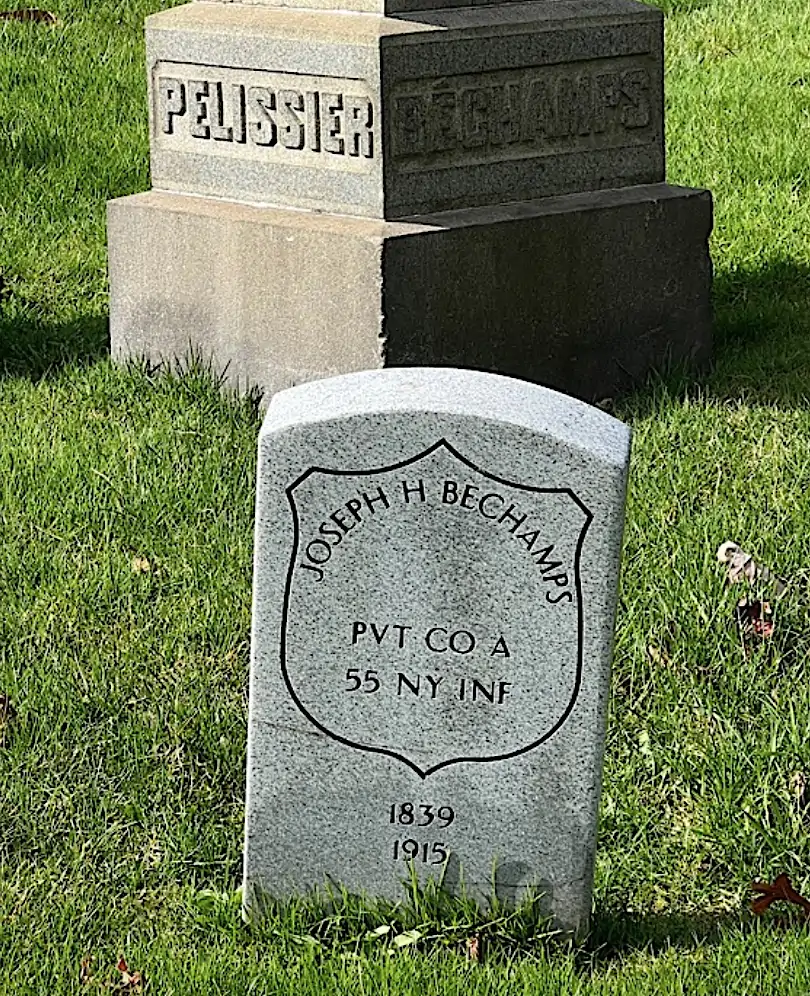
BECK, BERNARD J. (1836-1880). First sergeant, 13th Regiment, New York State National Guard, Company K. Of German birth, he enlisted at Brooklyn on May 28, 1862, mustered into the 13th that day, and mustered out after three months at Brooklyn on September 12. At some point during his service, he was promoted to first sergeant.
His death, due to a gunshot wound to the abdomen, prompted a coroner’s inquest that determined that the wound could have been accidental or self-inflicted. According to an article about the case in the Brooklyn Daily Eagle, he apparently was mentally incapacitated and dependent on alcohol for some time. He died at his residence at 53 Brevoort Place in Brooklyn. Section 95, lot 690.
BECK, DAVID (1820-1895). Corporal, 119th New York Infantry, Companies I and F. Beck enlisted at New York City as a private on August 25, 1862, and mustered into Company I of the 119th New York on September 5. On January 16, 1864, he was promoted to corporal and was transferred intra-regimentally to Company F at some point. He served in many battles including Chancellorsville, Virginia; Gettysburg, Pennsylvania; and in General Sherman’s March to the Sea. He applied for an invalid pension in 1880, application 394,874. His last residence was 18 Willoughby Avenue in Brooklyn. Beck died from Bright’s disease. Section 145, lot 24142, grave 1.
BECKER, EDWARD (1847-1873). Private, 11th New York Cavalry, Companies L and B. Becker, who was born in Germany, enlisted at New York City as a 17 year-old private on January 25, 1864, and mustered into Company L of the 11th New York Cavalry that same date. About two months after he was given an intra-regimental transfer to Company B on July 21, 1865, he mustered out of service on September 30, 1865, at Memphis, Tennessee. He lived at 229 East 2nd Street in Manhattan. He died from meningitis. Section 115, lot 11193, grave 253.
BEDELL, LEROY (or LeROY) (1843-1864). Private, 11th Pennsylvania Cavalry, Company E. Bedell enlisted as a private on February 5, 1862, at Fort Monroe, Virginia, and immediately mustered into Company E of the 11th Pennsylvania Cavalry. At that time, he was a laborer who was 5′ 8″ tall with blue eyes, light hair and a light complexion. He was discharged for disability on October 15, 1862. As per his obituary in the New York World, which confirms his Civil War service, he died of consumption at the home of his brother-in-law, George W. Whitmore. His funeral took place at his brother-in-law’s home at 299 State Street in Brooklyn. Pennsylvania State Records incorrectly report that he survived the Civil War. Section 108, lot 2726.
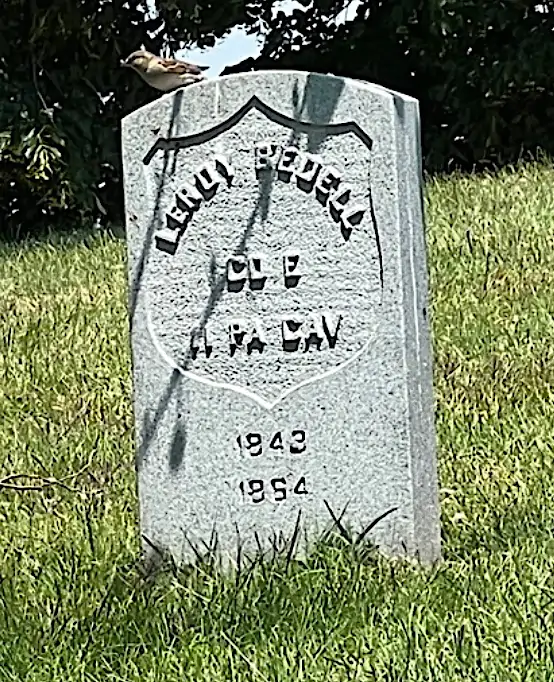
BEDELL, OSCAR D. (1840-1888). Third corporal, 13th Regiment, New York State National Guard, Company H. A New York native, Bedell served with the 13th Regiment for three months in 1862 mustering in as a corporal and mustering out as a third corporal. He last lived at 48a Pulaski Street in Brooklyn. His death was attributed to Bright’s disease. Penelope Bedell applied for and received a widow’s pension in 1901, certificate 534,614. Section 203, lot 26311.
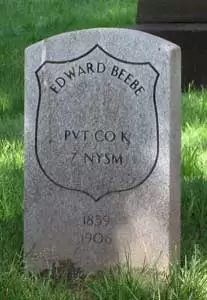
BEEBE, EDWARD (1839-1906). Private, 7th Regiment, New York State Militia, Company K. Beebe served in the 7th Regiment of the New York State Militia and was sent to Washington, D.C., in the days immediately following the attack on Fort Sumter, South Carolina, arriving on April 25, 1861. He mustered out in early June. When his unit was reactivated in 1862, and part of the New York State National Guard, he served with his company for three months from May 25 until he mustered out at New York City on September 5.
His father was in the iron foundry business that originally made the Beebe cooking range and later crafted ornamental ironwork including the dome on the United States Capitol Building and the Bow Bridge in Central Park. In 1906, his application for an invalid pension was granted under certificate 1,124,338. He last lived at 435 West 27th Street in Manhattan. His widow, Emma Beebe, received a pension after his death from cirrhosis in 1906, certificate 676,589. Section 34, lot 6382.
BEEBE, WILLIAM H. (1845-1926). Private, 3rd New Jersey Cavalry, Company G. Born at Malaga, New Jersey, and a resident of Millville, New Jersey, he was a glass-blower by trade. He stood 5′ 7″ tall with gray eyes, light hair and fair complexion. Beebe enlisted as a private on January 5, 1864, at Trenton, New Jersey, mustered into Company G of the 3rd New Jersey Cavalry the same day, and mustered out with his company at Washington, D.C., on August 1, 1865.
After his discharge, Beebe lived in Pittsburgh, Pennsylvania, for two years, moving from there to Salem, New Jersey, where he resided one year. From Salem he moved to Brooklyn, stayed there for four years, spent another four years in Camden, New Jersey, before returning to Brooklyn in 1877. He worked there as a commission merchant out of Wallabout Market, a major venue for vendors near the Brooklyn Navy Yard. In 1908, he applied for and received a pension, certificate 1,142,807.
On July 13, 1913, the Brooklyn Daily Eagle published an article announcing a local encampment at the U.S. Grant Hall on July 15. That article indicated that Beebe was among the comrades who attended the semi-centennial (5oth anniversary) celebration of the Battle of Gettysburg. Beebe died from heart disease. His last residence was 150 East 210th Street in New York City. As per his obituary in the Brooklyn Daily Eagle, his funeral took place at the headquarters of the Ulysses S. Grant Post #327 of the Grand Army of the Republic at 489 Washington Avenue in Brooklyn. He was survived by his wife Emma. Section 196, lot 32578.
BEEBE, WILLIAM HENRY HARRISON (1840-1906). Private, 7th Regiment, New York State National Guard, Company G. Originally from Bridgeport, Connecticut, Beebe enlisted as a private at New York City on May 25, 1862, and mustered that day into the 7th Regiment. He mustered out with his company on September 5, 1862, at New York City.
His obituary notes that he was employed in the tea business for twenty-five years, first with his father’s firm, Beebe & Brother, then with A. A. Low (see) & Brothers. As per the 1875-1876 and 1877 New York City Directories, he was in the tea business at 104 Wall Street. The census of 1880 reports that he was married, living in Brooklyn and employed as a tea merchant. After he left the tea business, Beebe was the private secretary to Seth Low, then was secretary for ten years at Columbia University. (Seth Low was the mayor of Brooklyn from 1881-1885, president of Columbia College from 1890-1901, and mayor of the consolidated city from 1902-1903.) When Low left Columbia University, Beebe continued his relationship with Low as his confidential secretary and manager of his private affairs; a partnership that ended with Beebe’s death in 1901. Beebe’s obituary, which confirms his affiliation with the 7th Regiment, indicates that he was an avid yachtsman and member of the house committee of the New York Yacht Club. In addition, he was a member of the Republican Club and the Union League Club. He last lived at 425 West 117th Street. Section 113, lot 16858.
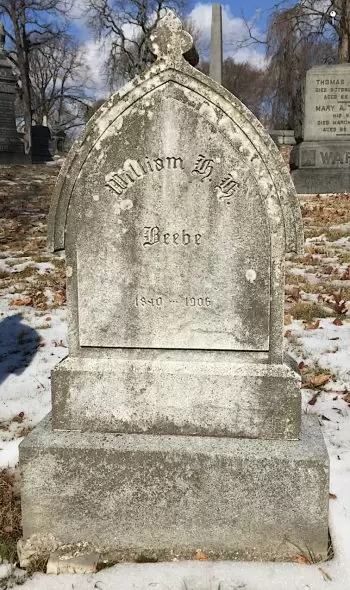
BEECHER, CLARENCE Y. B. (or YALE B.) (1843-1893). Captain, 61st New York Infantry, Company D; quartermaster sergeant, 1st Connecticut Heavy Artillery, Company M. Born in New Haven, Connecticut, where his ancestors were among the founding families in the 1600s, Beecher was a cousin of Henry Ward Beecher (see) and Harriet Beecher Stowe. He enlisted at New Haven as a quartermaster sergeant on January 14, 1862, mustered into the 1st Connecticut Heavy Artillery on February 25, and was reduced to the rank of private on March 10, 1863. He was discharged for promotion to first lieutenant on August 14, 1864, and was commissioned into Company D of the 61st New York on that day. On December 15, 1864, he was promoted to captain and was dismissed on February 14, 1865.
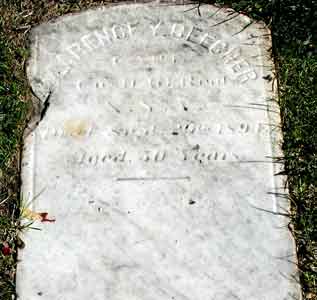
A bookkeeper in 1870, Beecher soon joined the Police Department in New York City, serving as a mounted officer and roundsman during his tenure. The 1873-1876 Brooklyn Directory lists him as a police officer. In one article in the Brooklyn Daily Eagle (July 22, 1877) mentioning him and his police work, it said that he had the nickname, Mamma’s Boy. Apparently he was hot-tempered in his policing and twice got into fracases although it is unclear to what extent he was disciplined for his actions. The 1880 and 1890 censuses and the 1890-1892 Brooklyn Directory indicate that he was a police officer at that time; the aforementioned directory indicates that he lived at 354 11th Street. In 1892, he applied for an invalid pension, application 1,129,404, but there is no certificate number. His last residence was 339 11th Street, Brooklyn. Beecher died from tuberculosis. Although his widow, Jessie Beecher, applied for a pension in 1894, application 591,900, no certification number is available. Section 202, lot 28560, grave 2.
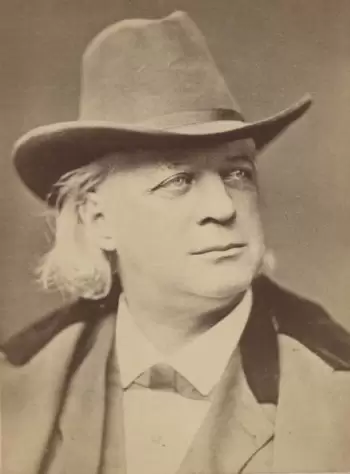
BEECHER, HENRY WARD (1813-1887). Clergyman. In 1847, he came to Plymouth Church in Brooklyn Heights, where he acquired a reputation as one of the great orators of his era. The pulpit from which he spoke has been called “the spiritual center of the Republic for almost half a century,” and Beecher called “the Great Divine.” His sermons were attended by 3,000 people, and were recorded by stenographers for publication. He was so in demand as a lecturer that even at the extraordinary rate of $500 per appearance, he was still obliged to decline many offers to speak. Beecher was an enthusiastic abolitionist, an early and active member of the Republican Party, and a major force in the moral and political debate of his country. He urged Northerners to go to Kansas; when bloodshed broke out there between pro and anti-slavery forces, guns shipped to the Northerners were referred to a “Beecher’s Bibles.” In 1856, he dramatized his anti-slavery position when he held a slave auction at Plymouth Church, making it possible for its members to purchase freedom for a slave named Sarah.
Beecher toured Great Britain in 1863, speaking widely and influentially on behalf of the Union to a public that was sympathetic to the South. On April 14, 1865, when the federal government held special ceremonies at Fort Sumter, South Carolina, to raise the American flag again, Beecher, at the request of President Lincoln, delivered the oration. As the flag went up, the harbor batteries which had fired on Sumter four years earlier roared their salute.
In 1874, Beecher was sued by his former protégé and fellow congregant Theodore Tilton, who alleged that Beecher and Tilton’s wife had engaged in an affair. The trial lasted six months, the jury deliberated for a week, but the jurors were unable to reach a verdict, with nine voting in favor of Beecher and three siding with Tilton. He remained pastor of Plymouth Church until his death. He last lived at 124 Hicks Street in Brooklyn. Beecher’s death was attributed to apoplexy. When his body was placed in Plymouth Church for viewing, 40,000 mourners filed past his casket to bid him goodbye. Section 140, lot 25911.
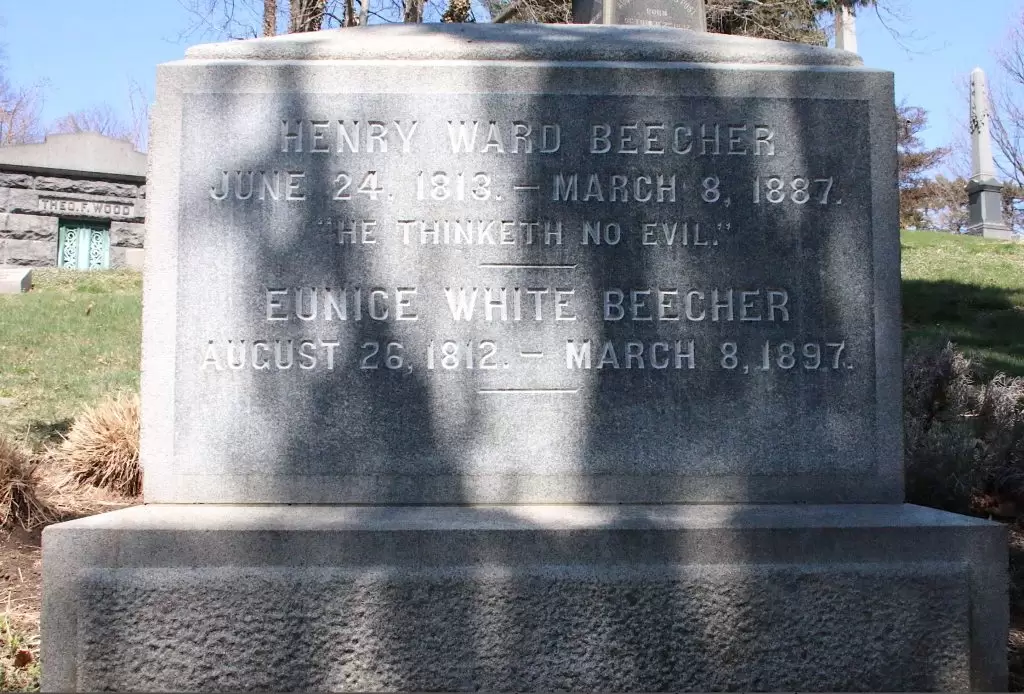

BEERS, WILLIAM F. (1835-1872). Quartermaster, 10th New York Infantry, Companies D, B, and C. Of Irish origin, Beers enlisted as a private on March 1, 1864, at New York City, and mustered into the 10th New York the same day. He quickly rose to corporal of his company on March 15 and was promoted to sergeant the next month on or about April 15. On May 6, 1864, he was wounded in action at the Battle of the Wilderness, Virginia. Rising through the ranks, he was promoted to second lieutenant on August 26, 1864, effective upon his transfer that day to Company B and became a first lieutenant on October 13 of the same year, heading Company C. Subsequently, he became a quartermaster on March 26, 1865, and was transferred to the Field and Staff. He was discharged on June 30, 1865, at Munson’s Hill, Virginia. His last residence was 145 West 22nd Street in Manhattan. Beers died from meningitis. Section E, lot 11002.
BEESTON, SAMUEL (1832-1907). Sergeant, 16th New York Heavy Artillery, Company E; private, 1st New York Infantry, Company E. Beeston was born in England. After enlisting at New York City as a private on November 27, 1863, he mustered into the 16th New York Heavy Artillery, was promoted to sergeant, and mustered out on August 21, 1865, at Washington, D.C.
In 1880, the census recorded Beeston’s occupation as factory worker. According to the Brooklyn Directory for 1888-1890, he was employed as a machinist. In 1892, his application for an invalid pension was approved, certificate 865,548. The Brooklyn Directory for 1894-1896 reports that he was a machinist who lived at 404 Bushwick Avenue. He last lived at 94 North 3rd Street in Brooklyn. Beeston died from nephritis. Section 57, lot 4782.
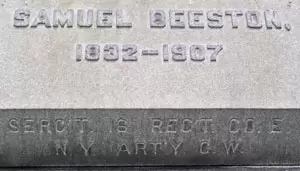
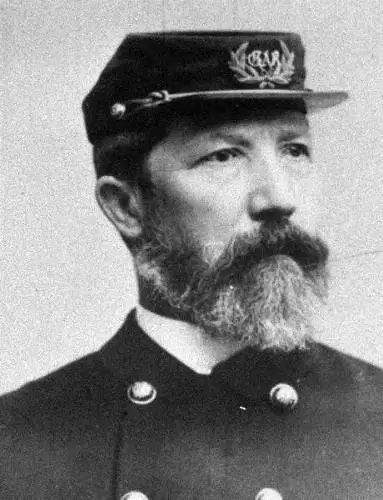
BEHNING, HENRY (1832-1905). Private, 1st Connecticut Infantry, Rifle Company B. Born in Hanover, Germany, he came to the United States in 1854, and brought with him his skill as a piano-maker. A resident of Bridgeport, Connecticut, he enlisted on April 20, 1861, mustered in on April 23, and mustered out at New Haven, Connecticut, on July 31, 1861. The 1st took part in First Bull Run, Virginia, in Keyes’s Division, and family history indicates that he was wounded there.
After the war, he established a piano factory, Behning and Sons, in the Bronx. The New York City Directories for 1875-1876 and 1877 list him in the piano business; he then lived at 10 Mitchell Place. The Brooklyn Daily Eagle reported his participation in a lockout of workers in 1880, and at a gathering of piano manufacturers in 1897.
His pride in his adopted country was evidenced by active membership in his G.A.R. post and his honored wish to be buried in his G.A.R. uniform. He applied for and was granted an invalid pension in 1904, certificate 1,101,886. At the time of his death from arteriosclerosis, he lived at 619 West 181st Street in Manhattan. In 1905, his widow, Adelheid Behning, applied for and received a pension, certificate 663,592. Section 168, lot 15927.
BEHRENS, JOHN H. (or F.) (1832-1904). Private, 7th New York Veteran Regiment. Born in Bremen, Germany, Behrens enlisted as a private at Brooklyn on October 31, 1864, and mustered into the 7th Veteran Regiment on that same day. He was not assigned to a company. As per his muster roll, he was a mason who was 5′ 4¼” tall with hazel eyes, brown hair and a fair complexion. There are no further details about his service.
The 1870 census indicates that Behrens was a clerk. According to his obituary in the Brooklyn Union Standard, which incorrectly states that he was to be buried in Lutheran Cemetery, Behrens was a member of the Brooklyn Schuetzen Corps (a German shooting club) and the German Liederkranz Turn Verein (a German social club). His cause of death was inflammation of the digestive tract. His obituary notes that he was taken to the Eastern District Hospital for an operation about a week before his death and died at that facility. He last lived at 40 Division Avenue in Brooklyn; he had lived in the Eastern District of Brooklyn (Williamsburg) for 50 years. Behrens was survived by his widow and several brothers. Section L, lot 20825.
BEINERT, CHARLES (1830-1872). Corporal, 6th New York Infantry, Company K. A German by birth, Beinert enlisted as a corporal on May 22, 1861, mustered into the 6th New York three days later, and mustered out June 25, 1863, at New York City. His last address was 89 Suffolk Street in Manhattan. Beinert died from tuberculosis. Section D, lot 20058.
BEITH, JAMES (1837-1895). Sergeant, 52nd Regiment, New York State National Guard, Company D. Originally from Scotland, Beith enlisted as a sergeant and served in the 52nd Regiment’s National Guard for 30 days in 1863. Beith mustered into the G.A.R. in November 1890. He last resided at 124 Adelphi Street in Brooklyn where his cause of death was pneumonia. Section 59, lot 743, grave 62.
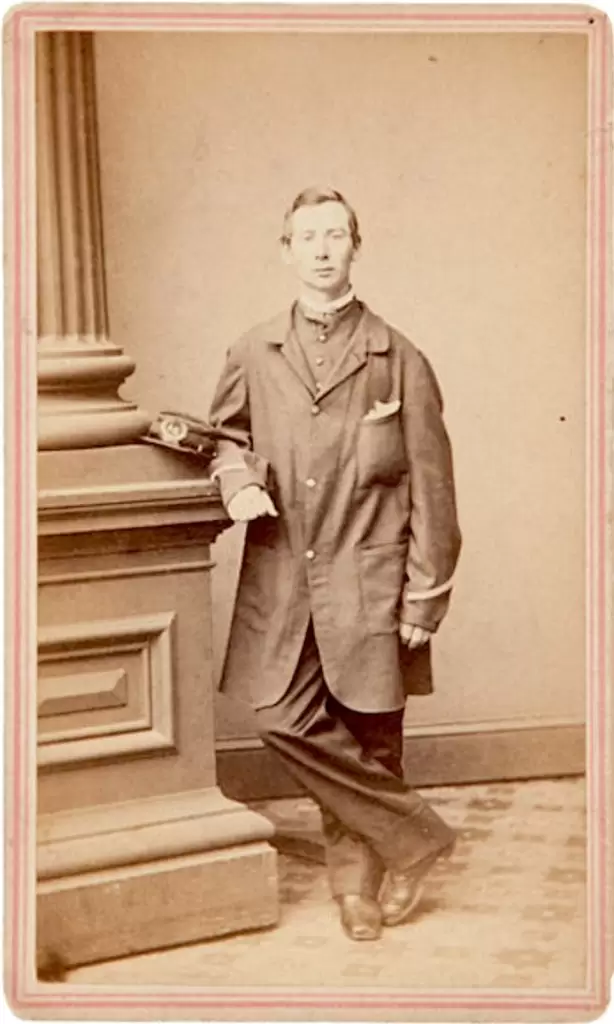
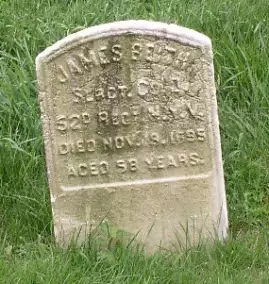
BELDING, CHESTER KERN (1844-1901). Sergeant, 195th Pennsylvania Infantry, Company B; private, 128th Pennsylvania Infantry, Company B. Chester Kern Belding was born in Pennsylvania on February 14, 1844, to Henry S. and Sarah Belding. When he was three years old, he was baptized at Trinity Lutheran Church in Reading. Chester’s father, Henry, and the family were still living in Reading as of the 1850 federal census and Henry was working as an innkeeper. Six-year-old Chester was one of four children including Henry C. (born in New York), Rosy (4) and Emma (1).
At 19-years-old, Chester enlisted in the 128thPennsylvania Infantry, Company B, as a private; he mustered in on August 5, 1862 in Reading, Pennsylvania (United States Records and Profiles 1861-1865). According to the Pennsylvania Veteran Card Files, Chester served 100 days in the 195th Regiment, Pennsylvania Company B. In the Civil War Pension Index, Chester is listed as serving in Company B and in both the 128th and 195th regiments during his 100-day term of service. As per his index card, he also served in the 19th United States Infantry, Company H, and the 20th United States Infantry, Company D, likely under aliases.
When he mustered out of service on May 19, 1863, Chester was listed in the Pennsylvania Veteran Card Files as a corporal. However, a note in the Records of the Department of Military and Veterans Affairs Registers of Pennsylvania Volunteers shows that he was promoted to sergeant and mustered out as a sergeant. It seems likely that the note in the Registers is the more accurate listing since it is recorded later and involves notation of rank.
It is probable that Chester was at the Battle of Antietam. The 128th Pennsylvania Infantry Regiment was organized at Harrisburg in August 1862, the same month that Chester enlisted, and that regiment fought in the Battle of Antietam on September 17, 1862.
Wikipedia, Battle of Antietam entry, notes:
After pursuing Confederate General Robert E. Lee into Maryland, Major General George B. McClellan of the Union Army launched attacks against Lee’s army who were in defensive positions behind Antietam Creek . . . . At dawn on September 17, Major General Joseph Hooker’s corps mounted a powerful assault on Lee’s left flank . . . . The battle was over by 5:30 p.m. on the morning of September 18…Losses from the battle were heavy on both sides. The Union had 12,410 casualties with 2,108 dead. Confederate casualties were 10,316 with 1,547dead.
The Battle of Antietam was the bloodiest day in American history. A stone monument to the 128th Pennsylvania Infantry stands on that battlefield.
Not much is known about Chester between 1863 and 1869. Several documents show that Chester had a daughter, Florence, who was born in 1865 and died in 1937 (Ancestry.com and Pennsylvania and New Jersey, U.S. Church and Town Records, 1669-2013 for Clara Anthony). Florence’s birth mother was listed as Clara Anthony, but no record of a marriage between Chester and Clara was found. Florence married John Thamm in Pennsylvania in October of 1887 (Reading Times, October 25, 1887), and had two sons, William and George. Her address at her marriage was the same as Chester’s parents, so it may be that Florence was brought up by and was living with Henry and Sarah Belding.
By 1869, Chester was serving as a machinist in the United States Navy. Documentation from the United States Navy shows that he served 1869-1878, then 1888-1894. He is reported to have worked as a machinist on many United States commissioned ships including the USS Juniata, USS Monongahela, USS Independence, USS Vermont, USS Colorado, and USS Franklin.
According to the Civil War Pension Index, Chester’s widow, Maggie, received a pension for his service. In the Index, Chester is documented as having served in the Pennsylvania Company B, both the 128th and the 195th regiments, as well as in the United States Navy.
On February 4, 1887, The Reading Times announced that Chester married Maggie M. Flynn in the Church of Our Lady of Mercy. While there is no address listed for Chester in the article, his parents, Henry and Sarah, are listed as living at 724 Chestnut Street, Reading. Maggie’s parents are listed as living in New Market, County Cork, Ireland. The U.S., City Directories, 1822-1995, for Chester K. Belding, shows that he was working as an engineer and living at 536 Warren Street in Brooklyn, New York, as of 1884.
Chester’s mother, Sarah Belding, died at her granddaughter (Chester’s daughter) Florence’s home in Reading, Pennsylvania in 1900. In Sarah’s obituary, Chester is listed as Sarah’s sole surviving child and living at 511 Warren Street in Brooklyn, New York. Other survivors included Florence and Florence’s two sons William and George Thamm.
Fifty-six-year-old Chester died a year after his mother, on June 30, 1901. His death certificate identifies his cause of death as “heat prostration,” as working as an engineer, and as a 30-year resident of New York City.
Maggie, his wife, outlived him by 10 years and died in 1911 (Brooklyn Daily Times, September 28, 1911). She was survived by a sister and a brother. Maggie and Chester are interred in the same lot at Green-Wood. Section 136, lot 28307.
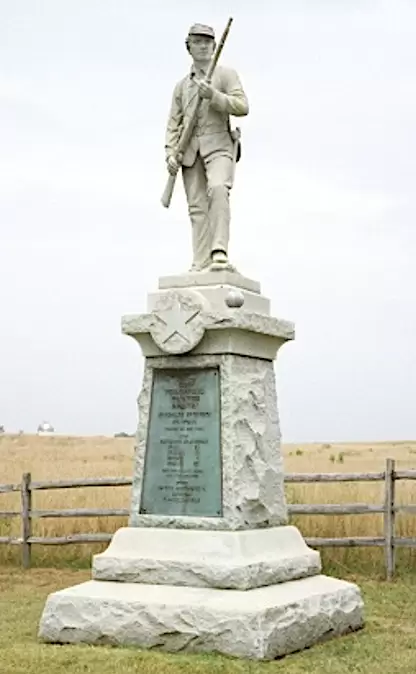
BELKNAP, ALFRED WELLING (?-1878). Captain, 74th New York Infantry, Company E. Born in New York State, his birth year is unknown since cemetery records list his age at death as “adult.” Belknap enlisted as a second lieutenant on June 15, 1861, at Staten Island, and was commissioned into the 74th New York on August 20. He was promoted to first lieutenant on April 27, 1862, but did not muster. Subsequently, he mustered as a first lieutenant on June 23, and then received a promotion to captain on February 15, 1863. He was dismissed on August 31, 1863. Originally buried at Marble Cemetery after his death in November 1878, he was interred at Green-Wood on December 21, 1888. Section 46, lot 25783.
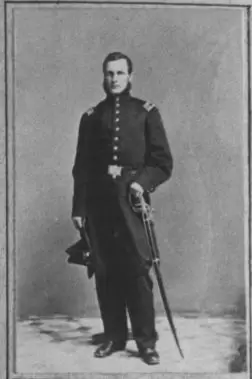
BELKNAP, JR., AUGUSTUS (1840-1889). Captain, 67th New York Infantry, Companies E and I; private, 7th Regiment, New York State Militia, Company A. Belknap was born in Newburgh, New York. He was 5′ 10″ tall, with high forehead, blue eyes, brown hair, and according to his passport application, a large mouth. Educated at private military schools, he worked in the hardware business from 1856 until the beginning of the Civil War.
On April 19, 1861, he enlisted as a private, mustered into the 7th Regiment, and mustered out after his unit’s 30 day activation. After re-enlisting at Camp Graham, Washington, D.C., as a private on December 1, 1861, he mustered immediately into the 67th New York, also known as the 1st Long Island Regiment. Belknap was wounded at the Battle of Fair Oaks, Virginia (May 31-June 1, 1862), when his regiment saw most of its officers killed or wounded. He also saw action at the Battles of Seven Pines and Fredericksburg, Virginia. He was promoted to first lieutenant on July 1, 1862, effective upon his transfer to Company I, and transferred back to Company E on December 31, 1862. Subsequently, he was promoted to captain on January 24, 1863, and was discharged on February 6, 1863. In 1863, his application for an invalid pension was granted, certificate 51,992. His obituary in the New York Herald, which refers to him as Colonel Belknap, notes that he served on the staff of General Alexander Shaler during the Civil War.
On December 9, 1863, he married Julia Pickard; the couple had three daughters and one son. Returning to the hardware business, Belknap became a junior partner in the firm of William S. Dodge and Company. He also joined the Old Guard Metropolitan Regiment in New York City, a veterans’ unit formed in 1868. In 1877, he moved to San Antonio, Texas, where he was the president and head of operations of the city’s streetcar business. Active in that city’s civic and cultural life, he was head of the San Antonio Opera House Company and the San Antonio Fair Association. Involved in local politics in San Antonio, Belknap was an alderman from 1883-1887, then ran unsuccessfully as the Republican candidate for Congress.
In 1884, he founded the Belknap Rifles, a militia company that won more honors in drill competition than any other unit in America; the state of Texas supplied the rifles and recognized such groups as regular infantry units in the Texas Volunteer Guard. In 1885, he was first vice president of the San Antonio Volksfest, a parade and festival that featured both Texan activities like a rodeo and German-American businesses and cultural groups in the parade; the Belknap Rifles participated in the Volksfest. He died from ulceration of the bowels while visiting Santa Barbara, California. An honor guard of six members of the Belknap Rifles attended his burial at Green-Wood. Julia R. Belknap, his widow who is interred with him, applied for a pension in 1909 which was granted under certificate 697,915. Section 48, lot 6144.
BELL, DAVID (1841-1918). Sergeant, 2nd United States Artillery, Company C; private, 174th New York Infantry, Company H. After enlisting as a private at New York City on October 20, 1862, Bell mustered into the 174th New York on November 6. He re-enlisted as a sergeant on February 27, 1863, transferred into the 2nd U.S. Artillery on August 31, 1863, and mustered out on February 27, 1866. In 1901, he applied for and received a pension, certificate 1,149,056. Bell last lived at 107 West 78th Street in Manhattan. The cause of death was heart disease. Maria Bell, who is interred with him, received a widow’s pension in 1918, certificate 863,412. Section 203, lot 26728.
BELL, GEORGE (1820-1903). Private, 71st Regiment, New York State National Guard, Company D. A native of Dublin, Ireland, wartime service for Bell in the 71st lasted from June 17- July 22, 1863, when his unit was activated for 30 days. His last residence was 222 West 22nd Street in Manhattan. Bell died from cancer. Section 56, lot 4378, grave 8.
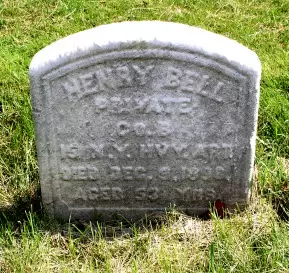
BELL, HENRY (1843-1898). Private, 87th New York Infantry, Company A; 16th West Virginia Infantry, Company C; 15th New York Heavy Artillery, Company B. After enlisting and mustering as a private on December 18, 1861, he served with the 87th New York until his discharge on September 21, 1862. About nine days later on September 30, he re-enlisted at Washington, D.C., mustered into the 16th West Virginia the same day, and mustered out on June 10, 1863. He re-enlisted on December 31, 1863, and mustered into the 15th New York on that date.
Although some records indicate that Bell deserted on July 22, 1865, that appears to be incorrect: he applied for and was granted an invalid pension in 1890, certificate 751,903. In civilian life, he was employed as a marble-polisher according to the 1880 census. Bell last lived at 259 Third Avenue in Brooklyn. His death was attributed to tuberculosis. Bridget Bell, who is interred with him, applied for and received a widow’s pension in 1898, certificate 489,962. Section 135, lot 27263, grave 838.
BELL, ISAAC (1814-1897). Cotton merchant. Born in New York City, he moved to Mobile, Alabama, and engaged in the cotton trade from 1836 to 1856. During that period, he was elected to the Alabama legislature and served on the staff of one of its governors, with the rank of captain. He returned to New York City in 1856, went into the shipping business, and established packet and steamship lines. When war threatened in 1859, he founded the Democratic Vigilant Association to defend Southern rights. Some considered him to be a traitor to the Union in 1861, though he soon reversed his sentiments with his untiring work as vice president of the Union Defense Committee of New York State. He, along with Leonard Jerome (see) and Paul S. Forbes, organized the Riot Relief Fund for New York City policemen, and Bell managed that fund until his death.
Though Bell declined nominations for mayor and congressman, he served in many New York City positions. He founded New York City’s ambulance service and was for a time simultaneously New York City’s commissioner of charities, commissioner of education, and commissioner of immigration. He was also the commissioner of charities and corrections of New York State for many years. He was the principal founder of Bellevue Medical College and served as the president of its board of trustees for thirty years. He was also a founder of the Normal College and the Manhattan Club. In 1844, he married Adelaide Mott, the daughter of pioneer surgeon Dr. Valentine Mott (see). Section 98, lot 6035.
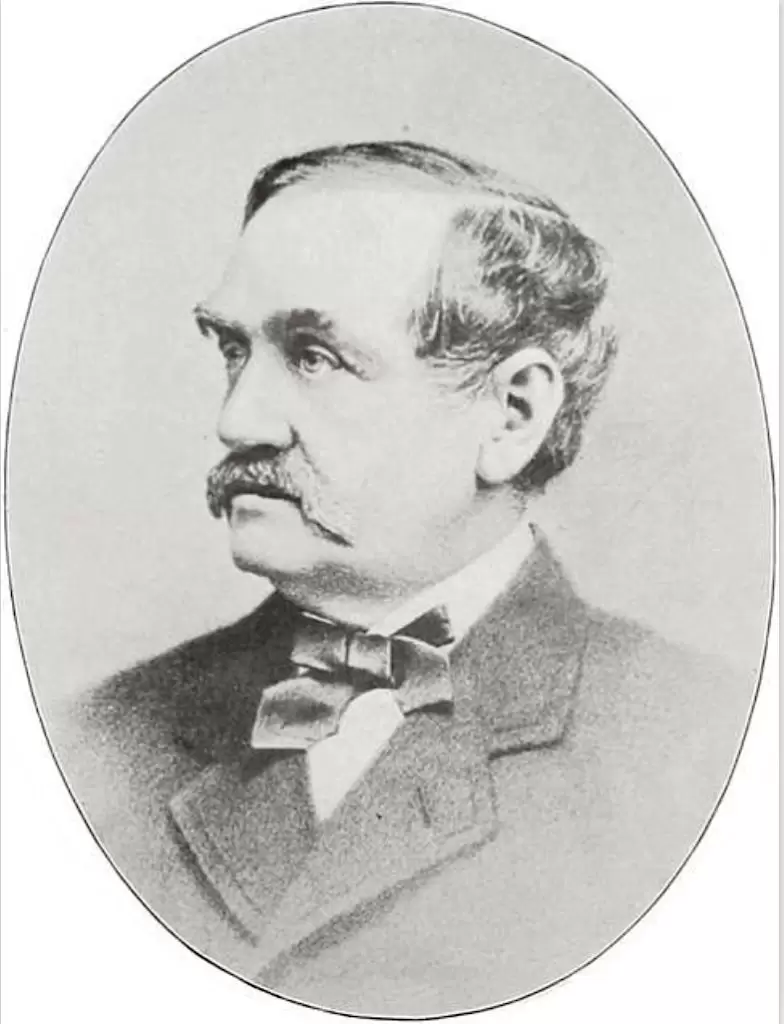
BELL, JOSEPH W. (1839-1884). Unknown soldier history. Bell served in the Civil War and his name appears on the list of the Sons of Union Veterans. Details of his military record are unknown. Section 2, lot 11672.
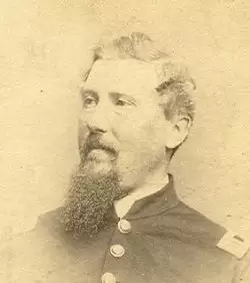
BELL, MOLYNEUX (1827-1886). Major by brevet; captain, United States Volunteers Commissary Department. He likely was the Moyneux Bell who placed an advertisement in the New York Herald in 1857 as a manufacturer and importer of fine ladies’ fabrics silk, moiré, Chantilly lace and linen. That establishment was at 58 Canal Street in Manhattan. Bell enlisted as a captain on September 18, 1862, the same date that he received his commission into the United States Volunteers Commissary Department. On July 16, 1865, he was promoted to major by brevet for “faithful and meritorious service,” and mustered out on August 4, 1865. He died on November 11, 1886, in Albuquerque, New Mexico, where he last resided. The following year, he was interred at Green-Wood on December 16, 1887. Section 11, lot 5893.
BELL, ROBERT (1835-1861). Private, 82nd New York Infantry, Company A. Of Irish birth, he enlisted at New York City on May 21, 1861, and mustered in that day. On November 17, 1861, he died of intermittent fever at Poolesville, Maryland, and was interred three days later. Section A, lot 9146, grave 163.
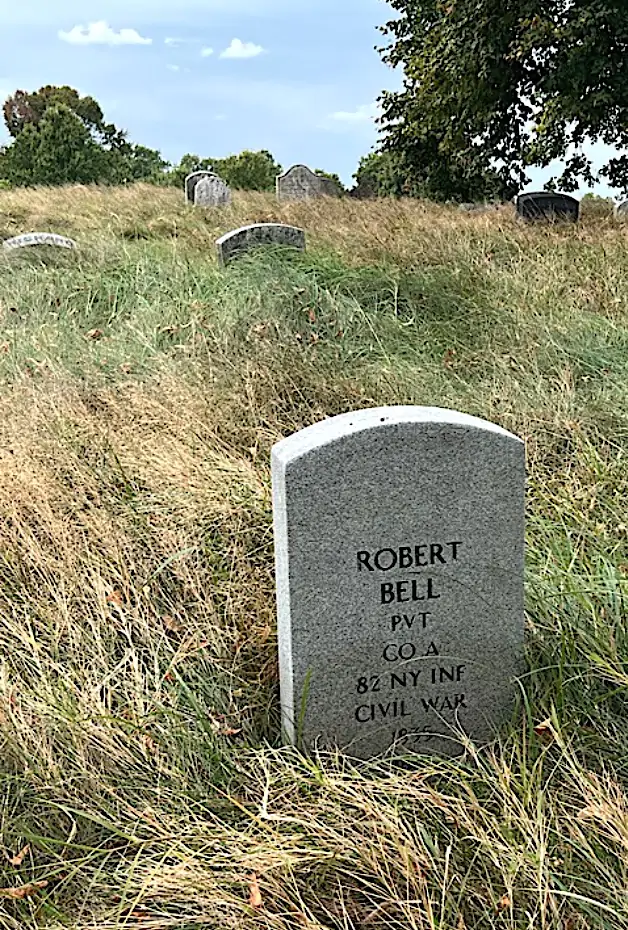
BENBOW, THOMAS WOOSNAM (1843-1861). Private, 12th Regiment, New York State Militia, Company F. Originally from Llanidloes, Wales, his family immigrated to the United States in 1853. He enlisted as a private for three months in the 12th Regiment at New York City in 1861, went to Washington, D.C., and died there of disease a month into his service on May 16. A report of his funeral from the 12th Regiment’s newspaper clippings is below:
Yesterday afternoon the remains of Thomas Benbow, the member of Company F, of the Twelfth regiment, who died in Washington of congestion of the brain, were conveyed to their last resting place in Greenwood. A large number of the friends of deceased assembled at his late residence, 118 West Twenty-fourth street, all the neighbors congregated round the premises, and Company K of the regiment in which he was a volunteer took their position in the street to escort his body to the cemetery. Thomas Benbow was a smart young man, and very much endeared to his family and friends, as the tears which flowed at his funeral yesterday abundantly attest. He was seventeen years and five months of age at the time of his death, and was the only son of his parents. Thomas, it is said, was determined upon going to the wars; nothing could restrain him; and his determination was the inspiration of patriotism rather than a spirit of reckless adventure; yet he went against the remonstrances of his parents, and those premonitions of danger which some of us receive, and which told them that their son would never return alive, were sadly realized by them. At two o’clock, the house being crowded with mourning and sympathizing relatives and friends, Rev. William Roberts, pastor of the Welsh church, in Thirteenth street, conducted the funeral services. He read the 16th verse of the 22d chapter, of Job:—”When a few years are come then I shall go away, whence I shall not return,” which he took as the foundation of a few remarks. Deceased, he said, was born in Llandloes (sic), Montgomeryshire, in Wales, and came to this country when a child. His firm resolution was to sacrifice his life on the altar of the Union, and to ratify the articles of the constitution with deeds of valor to the latest moment of his existence. Mr. Roberts made some spiritual reflections upon death in several of its aspects, and at the close improved the occasion by making an appeal to those present to prepare for it. The friends then passed round and took their last look at the remains. When the family were invited to take the farewell glance, it seemed as if every heart but theirs stood still. Out of the solemn silence which reigned for a moment rose the mourning cries of the bereaved; the little sisters kissed the lips now closely sealed in death, and the mother clung to them, reluctant to part with the lifeless form of her only son. The coffin was covered with the American flag, whose honor the deceased young man had gone forward to defend. Surrounded by every mark of respect, it was placed in the hearse. It was then escorted by company K of the regiment, the friends following in carriages, to Greenwood Cemetery.
According to a descendant, his parents returned to Wales the next year. Section 126, lot 2458, grave 1111.
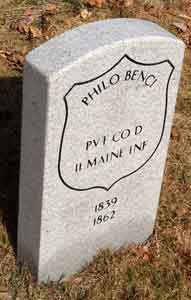
BENCI (or BEARCE), PHILO (1839-1862). Private, 11th Maine Infantry, Company D. A resident of Springfield, Maine, he enlisted on October 19, 1861, immediately mustered into the 11th Maine Infantry, and died from typhoid fever at College Hospital in Brooklyn on July 14, 1862. His remains were moved to its current location on November 6, 1863. In 1869 his mother applied for a pension; it was granted under certificate 138,480. His father applied for a pension in 1883; that was granted under certificate 206,666. Section 115, lot 13536 (Soldiers’ Lot), grave 77.
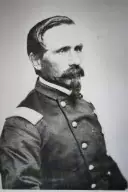
BENDIX, JOHN E. (1818-1877). Brigadier general by brevet; colonel, 7th New York Infantry; 10th New York Infantry. Born on the Sarah, a steamer that plied the St. Lawrence River between Canada and the United States, his parents returned to their native Germany where Bendix was educated. (Another document says Bendix was born in England.) He immigrated to the United States as a teenager, settled in New York and learned the trades of pattern-maker and machinist. He joined the 9th New York State Militia in 1847 and subsequently became a lieutenant colonel of the 11th New York State Militia in 1859.
During the Civil War, Bendix enlisted as colonel at New York City on April 23, 1861, and was immediately commissioned into the Field and Staff of the 7th New York Infantry which he helped organize. On May 26, 1861, the regiment headed for Fortress Monroe onboard the steamer Empire City. On May 29, Bendix was ordered to join an expedition in command of Colonel Phelps. On June 9, Bendix was ordered to take command of detachments of the 1st Vermont and the 4th Massachusetts, in conjunction with a portion of his regiment. That force of 900 men were sent to Big Bethel. Writing from Newport News, Virginia, on June 12, 1861, he described the confusion of his soldiers in his field report describing the march to Big Bethel, Virginia. He wrote how his troops mistakenly engaged in “friendly fire” for about 15 minutes until they realized their error, and later, after being suddenly fired upon by the enemy, “….we were not strong enough to make an attack, and after firing some time, withdrew back into the woods.” After resigning on August 6 of that year, he was commissioned into the 10th New York as its colonel a month later on September 2. On October 24, 1861, he wrote from Fort Monroe requesting supplies:
I would like you to get the recruits overcoats, fatigues, caps, pants and jackets. If possible, they should have the musket or rifle, in fact they ought to be fully equipped as we can get nothing here. Push every cord to get those rifles from Gov. Morgen (sic). You must see the Band Master and tell him to hurry up and let me know about instruments. I have got two more musicians here for him which I can get out of Cavalry Corps.
Col. Carr has a set of instruments which he will sell below cost, hence, I would like to know the cost. We are all well down here and hope you are the same….
On April 9 and 10, 1862, the regiment participated in the engagement with the CSS Merrimac. On May 9, the regiment left Fortress Monroe and headed for Norfolk, Virginia, which was taken the next day and remained there until June 6 when it took an active part in the Seven Days’ Battle. Brigadier General George Sykes in his report of the Seven Days’ Battle, Virginia, on July 7, 1862, saluted the courage of Bendix and his troops noting, “Hunger, night marches, tropical heat, storm-drenched, weary, and exhausted, they reached their new base uncomplainingly, cheerful, still defiant.” During that battle, Bendix suffered an ankle wound. He also participated in the Battles of Second Bull Run, Virginia, Antietam, Maryland, and Fredericksburg, Virginia, where he was carried off the battlefield after a suffering a wound to the neck from a shell fragment. After recuperating at home, he rejoined his regiment in January 1863. He mustered out on May 7, 1863, at New York City.
Bendix then was active recruiting and training soldiers for New York regiments. He was brevetted brigadier general of United States Volunteers on March 13, 1865, “for gallant and meritorious services during the War.” In November 1865, he organized the 3rd Regiment, known as Bendix’s Zouaves and remained active in that unit until 1871. A Freemason in civilian life, he resumed his trade as a patternmaker after the War. Bendix is listed as working in models in the New York City Directory for 1875-1876 and as a machinist in the New York City Directory for 1876-1878; both directories note that he worked on Franklin Street, corner of Centre Street. The latter directory reports that he lived at 77 Bank Street. G.A.R Post # 402 is named in his honor. His last address was 77 Bank Street in Manhattan. The cause of death was paralysis. Section 63, lot 7278.
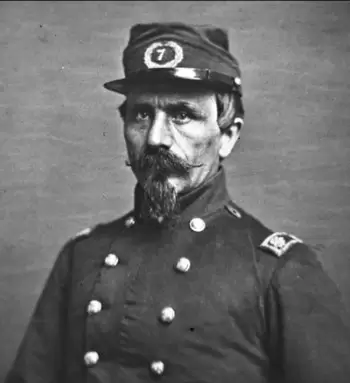
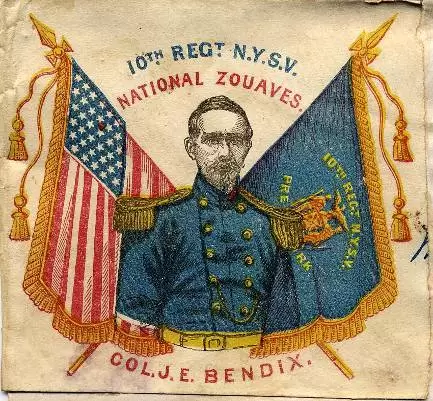
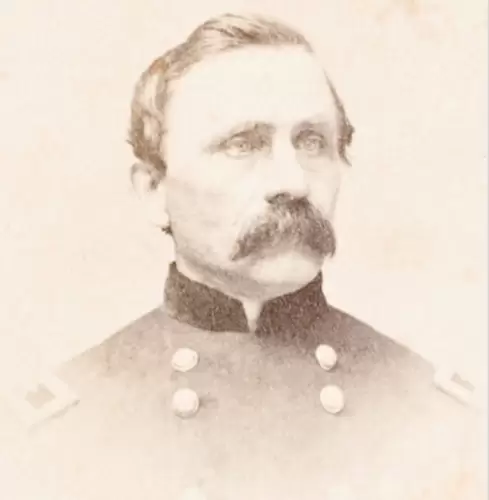
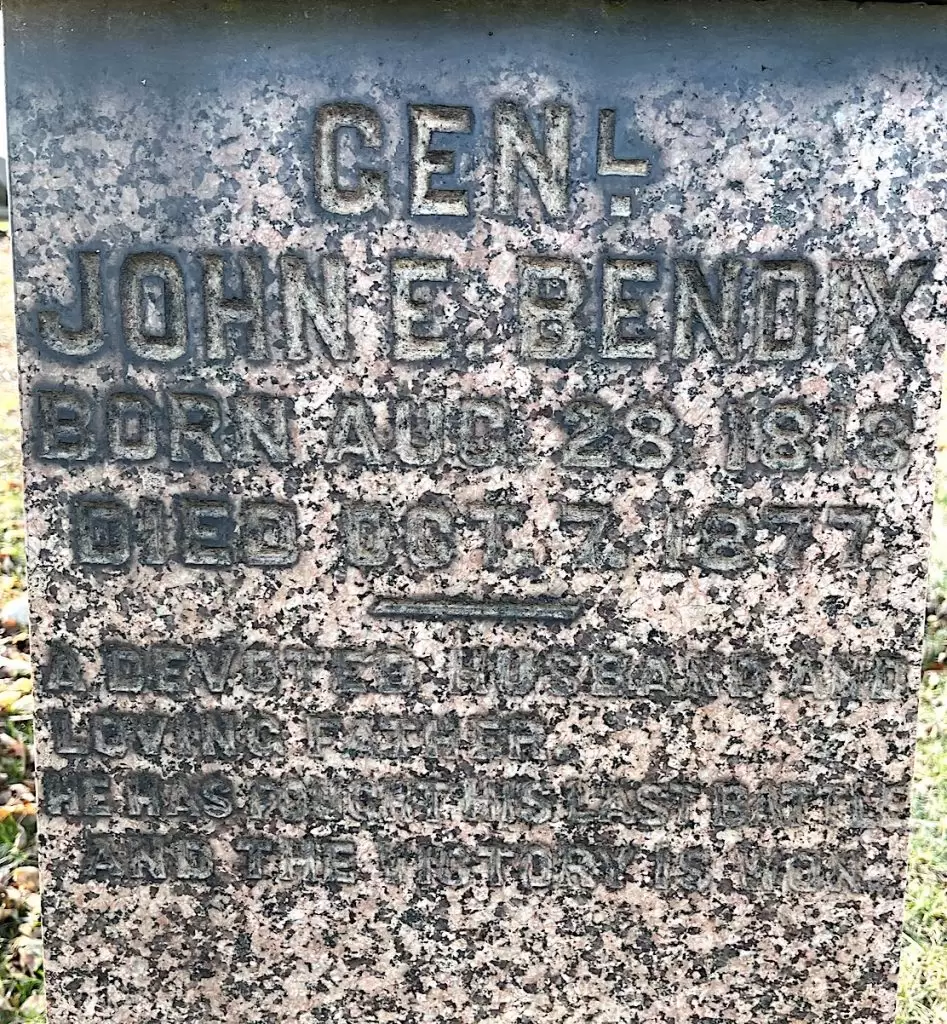
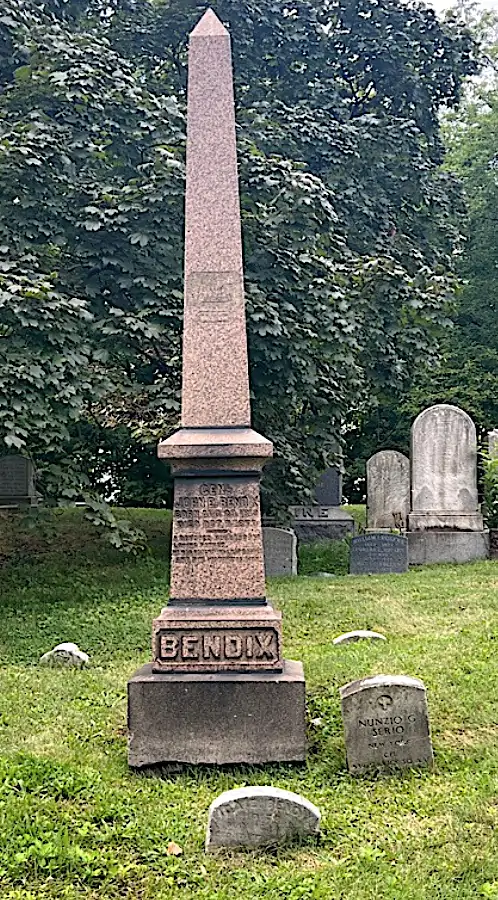
BENE, JOHN (1839-1889). Private, 84th New York (14th Brooklyn) Infantry, Company E; 5th New York Veteran Infantry, Company A. A native of Germany, he enlisted at Brooklyn as a private on August 25, 1862, and mustered into the 14th Brooklyn that day. On April 29, 1863, he was wounded at Reynolds Crossing, Virginia. Bene was transferred to the 5th New York Veterans on June 2, 1864, from which he was discharged for disability on May 31, 1865, at Alexandria, Virginia. He was granted an invalid pension for his service. He last lived at 166 Livingston Street in Brooklyn. Bene’s cause of death was apoplexy. His widow, Mary Bene, who is interred with him, received a government pension. Section P, lot 34062.
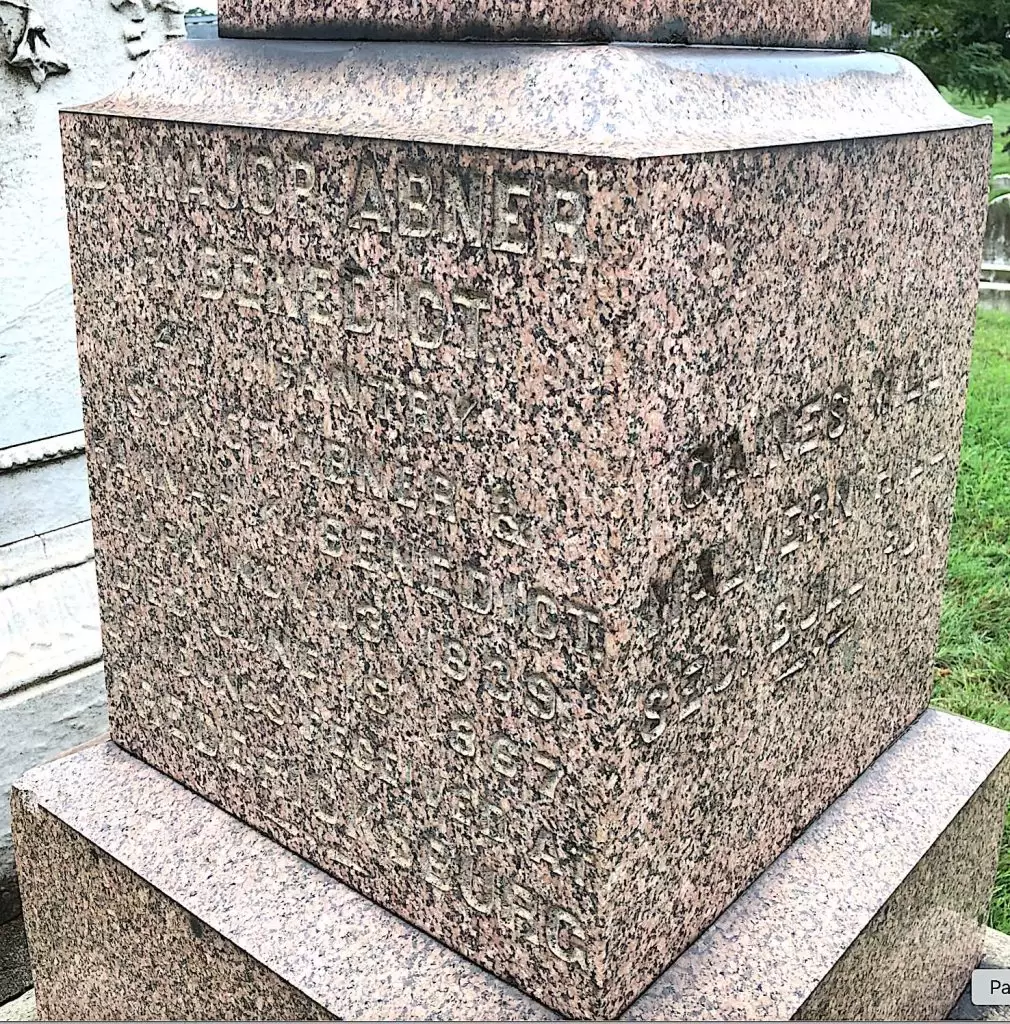
BENEDICT, ABNER RALEIGH (1840-1867). Major and captain by brevet; captain, 4th Infantry, United States Army; corporal, 12th Regiment, New York State Militia, Company A. Born in New York, both of his parents were lost when the ship Arctic went down in 1854. He graduated from the University of Vermont, and had a job as a clerk in a publishing house until the outbreak of the Civil War. He first served for three months in 1861 in the 12th New York State Militia, one of the first regiments to leave New York City and led by Butterfield. The regiment sailed from New York to Fortress Monroe, Virginia, on April 21, 1861, arrived two days later, and moved to Annapolis, Maryland, and Washington, D.C. After being assigned to Mansfield’s command, he mustered in on May 2, advanced into Virginia on May 23, and occupied Arlington Heights, Virginia, the next day. He was ordered to join Patterson’s Army on July 6, engaged in a skirmish near Martinsburg, West Virginia, on July 12, was near Bunker Hill, West Virginia, on July 15, and mustered out with his company at New York City on August 5 of that year.
Re-enlisting that same day in the 4th Infantry, United States Army, Benedict was promoted to first lieutenant, and was later brevetted captain on June 27, 1862, for his gallantry at Gaines’ Mill, Virginia. He fought with the Army of the Potomac in all the great battles on the Peninsula, including Malvern Hill, Virginia. At Fredericksburg, Virginia, he was wounded by a Minie ball through the lungs, and his wound was believed mortal. However, he survived to fight at Chancellorsville, Virginia, and Gettysburg, Pennsylvania, commanding his regiment at the latter when all of his superior officers fell. He commanded General Grant’s headquarters guard during the Petersburg, Virginia, campaign, and was brevetted a major on December 13, 1862. He was given a promotion to captain on June 8, 1863. In 1867, five years after being shot at Fredericksburg, the wound ultimately took his life when he succumbed to consumption. He last resided at 134 Broadway in New York City. Section 15, lot 11065.
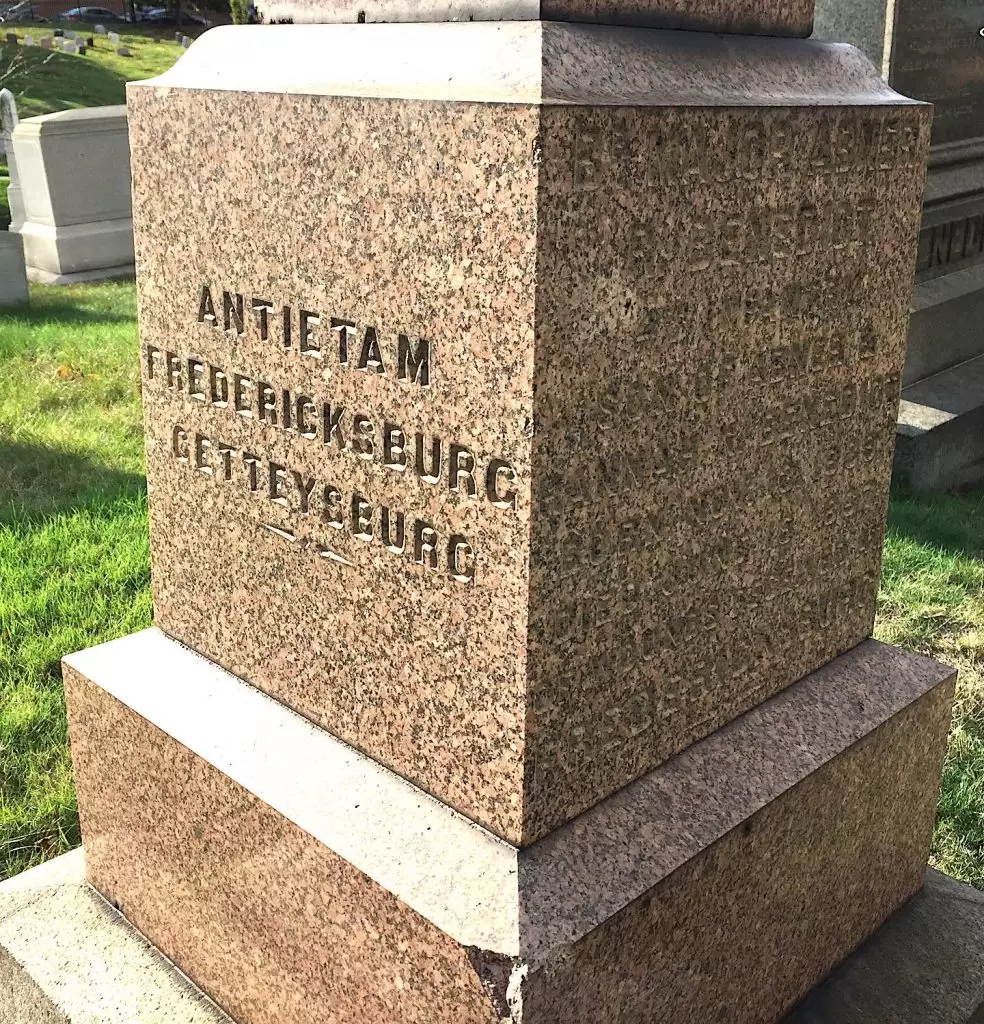
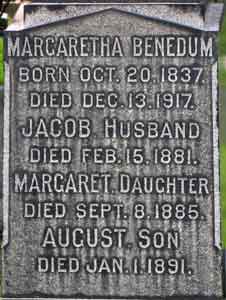
BENEDUM, JACOB A. (1830-1881). Sergeant, 54th New York Infantry, Companies C and A. Born in Germany, Benedum enlisted as a private at Hudson City, New Jersey, on September 17, 1861, and mustered into Company C of the 54th New York the same day. He transferred to Company A, was promoted to sergeant on January 1, 1862, and was discharged for disability on May 12, 1862.
Benedum is listed as a broker at 180 Essex Street in the 1875-1876 and 1876-1878 New York City Directories. He died from a skull fracture. His last residence was 62 Broad Street in Manhattan. Margaretha Benedum, his widow, who is interred with him, filed for a pension in 1892, certificate 366,095. On July 3, 1905, his remains were moved to the present location. Section 207, lot 32048, grave 1.
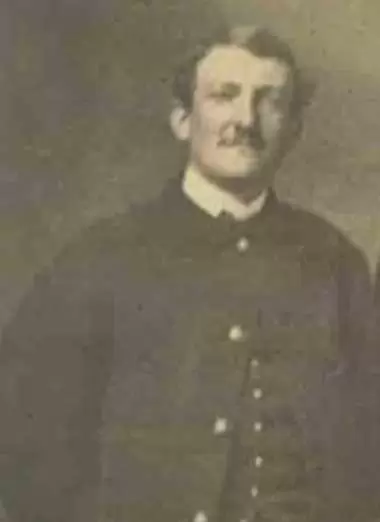
BENKARD, JAMES (1840-1902). Captain, 13th Wisconsin Volunteers; private, 7th Regiment, New York State Militia, Company F. Benkard was born at 34 Varick Street in Manhattan. As per his obituary in The New York Times, which confirms his Civil War service, his father was a well-known merchant and his mother, Mary Robinson Benkard, was the daughter of Captain Henry Robinson, a prominent ship-owner and early member of the New York Yacht Club. He was a graduate of Columbia College, class of 1861.
During the Civil War, Benkard enlisted in the 7th Regiment as a private on April 9, 1861. On special call of President Lincoln, the regiment left New York for Washington, D.C., on April 9, occupying Annapolis Junction, Maryland, and opening communication with Washington at the end of April and beginning of May. The regiment mustered into federal service on April 26. After other activities in the capital area, the regiment returned to Camp Cameron on May 26, and then to New York City, where it mustered out on June 3, 1861. He then joined the 13th Wisconsin on September 15, 1861, and was commissioned a first lieutenant. On June 16, 1862, he was appointed additional aide-de-camp with the title of captain, and served under General Rufus King in the early Virginia campaigns.
Benkard was mentioned for his important services in Brigadier General John Hatch’s report on the Battle of South Mountain, Maryland, in September of 1862. He was later assigned to the staff of General Chris C. Augur, and saw action in the Wilderness campaign. He resigned his commission on April 29, 1864.
He was a member of the G.A.R., Lafayette Post #140, and was active in many community and business associations including the Union Club of which he was a governor, the Army and Navy Clubs, Delta Phi, and the Southside Club; he also served as president of the American Fisheries Society. As per his obituary in the New York Herald, members of the Society of War Veterans, Seventh Regiment, were requested to attend his funeral. Another death notice in the New York Herald noted that members of the Military Order of the Loyal Legion, a fraternal organization of Civil War officers, were invited to attend Benkard’s funeral. Additional death notices in other editions of the New York Herald included invitations to Benkard’s funeral from the Lafayette Post of the G.A.R., his Masonic Lodge and the Veteran Corps of Artillery, Military Society of the War of 1812 of which he was an associate. He last lived at 127 East 24th Street in Manhattan where his death was attributed to cystitis. His funeral took place at Calvary Church on Fourth Avenue and East 21st Street. He was survived by his wife and three sons. Section 178, lot 11686.
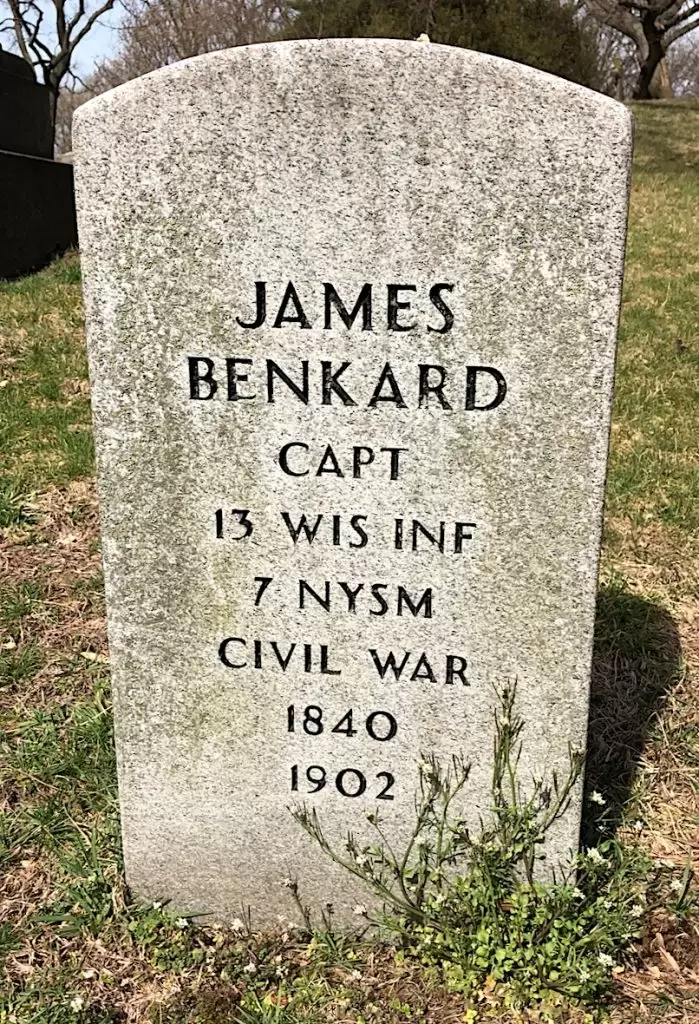
BENNET, GEORGE H. R. (1837-1904). Assistant surgeon, 23rd Regiment, New York State National Guard; 13th New York Heavy Artillery. Born in Brooklyn (although one document says East Avon, New York), Bennet, the son of a doctor, was a graduate of the Medical College of the University of the City of New York, class of 1860. His name is listed among the 138 graduates of that medical school in The New York Times on March 8, 1860; Valentine Mott (see) gave the commencement address. During the Civil War, he served as an assistant surgeon in the Field and Staff of the 23rd Regiment when it was activated for 30 days in 1863. One soldier record indicates that he also served with the 23rd in 1865 but there are no specific dates noted. Another soldier records indicates that he also served with the 13th Heavy Artillery but that information is not corroborated.
Bennet is listed as a physician in the Brooklyn Directories for 1864, 1866, 1868 and 1867-1870; he worked with his father, Dr. George I. Bennet, at 195 Washington Avenue. According to the Brooklyn Directory for 1870-1873, which does not list his father, Bennet was a physician at 95 Felix Street. The Brooklyn Directory for 1890-1892 lists him as a physician at 21 South Portland Street with office hours from 8 to 10 a.m. As per his obituary notes, which verify his service with the 23rd Regiment, Bennet was a member of the Kings County Medical Society, the Brooklyn Pathological Society and the Brooklyn Medical and Neurological Society. One obituary indicates that he was a dentist. A member of the Crescent Athletic Club, he last lived at 23 South Portland Avenue in Brooklyn. His death was caused by a stroke. Section 185, lot 28557.
BENNETT, EDWIN (or EDWARD) (1840-1907). Seaman, United States Revenue Cutter Service. A Brooklynite by birth, Bennett was 5′ 3″tall, with blue eyes, brown hair and a ruddy complexion. After enlisting as a boy on June 1, 1859, he first served aboard the Harriet Lane, a revenue cutter. He was rated as an ordinary seaman on April 1, 1861, and served on the aforementioned vessel until September 15, 1861. The Harriet Lane, named for the niece of James Buchanan, was christened in 1859 as part of the U.S. Revenue Cutter Service, then was a ship in the U.S. Navy at Fort Sumter, South Carolina; New Orleans, Louisiana; and Galveston, Texas. She was captured in 1863, and became part of the Confederate States Navy before being recaptured by Union forces and deemed unfit for duty. A letter to the Commissioner of Pensions in 1906 stated that Bennett re-enlisted and was a seaman on the revenue cutter Henrietta from January 11, 1862-April 30, 1862.
In civilian life, Bennett was a storekeeper at the United States Custom House for 37 years, and was a member of the Volunteer Fire Department of Brooklyn and the G.A.R. In 1906, his application for an invalid pension from the Navy was approved due to senility and obesity, certificate 37,643. At the time of his application, he weighed 210 pounds and noted that he had a scar on the bottom of one foot. His last residence was 409 8th Street in Brooklyn. Bennett died from apoplexy.
After his death, his daughter wrote to the Pension Bureau inquiring if any monies were sent to the family and noting that her step-brother, who possessed his documents, might have profited. She also wrote that her father was “…a Grand Army man of whose record I am proud of. Not a member of his post was present after his death, so I put the Stars and Stripes around his casket, and his Grand Army medals pinned on his shroud, or chest, and did what I thought was right. I heard him speak of doing this to other comrades of whose funerals he attended….” Section 126, lot 2458, grave 204.
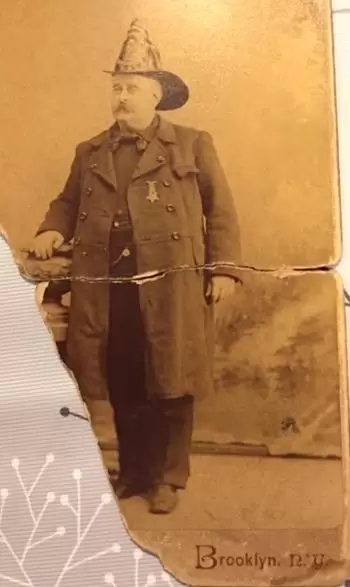
BENNETT (or BENNIT), HENRY C. (1846-1924). Private, 51st New York Infantry, Company G; 51st Veteran Reserve Corps, 2nd Battalion. A Brooklynite by birth, Bennett enlisted as a private at New York City on March 14, 1864, and mustered into the 51st on that date. He was wounded in action by at some point before he transferred into the 2nd Battalion, 51st Veteran Reserve Corps on February 6, 1865. On September 19, 1865, he was discharged for wounds.
In 1885, Bennett successfully applied for an invalid pension, certificate 464,204. His last residence was 30 South Elliott Place in Brooklyn. Shortly after his death in 1924, his wife applied for and was awarded a widow’s pension, certificate 946,755. Section 94, lot 9302.

BENNETT, JAMES (1808–1867). Unknown soldier history. According to his government-issued gravestone, circa 1900, he was a “war veteran of 1861-1865.” He last resided at 22 Summit Street, in Brooklyn. Section 126, lot 2454, grave 408.
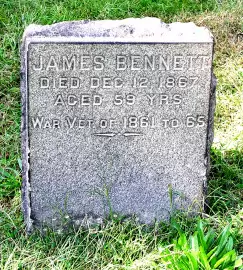
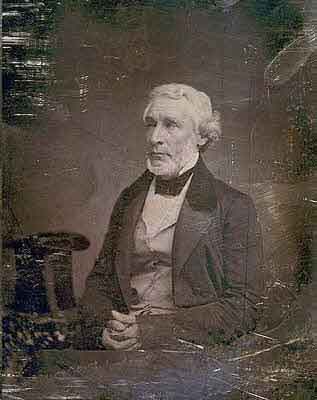
BENNETT, JAMES GORDON (1795-1872). Newspaper editor. Born in Keith, Scotland, he immigrated to the United States in 1819 and worked as a freelance writer and typesetter, eventually settling in New York City where he established the New York Herald in 1835. The paper, a sensationalist success with the working class and hawked on the street for a penny, had a circulation of 135,000 in the 1860s. Politically, the paper’s slant was Democratic, pro-South and anti-abolitionist in tone and mocked Abraham Lincoln.
Of Lincoln’s first nomination, Bennett reported, “Abram [sic] Lincoln is an uneducated man — a vulgar village politician, without any experience worth mentioning in the practical duties of statesmanship, and only noted for some very unpopular votes which he gave while a member of Congress. In politics he is as rabid an abolitionist as John Brown himself, but without the old man’s courage.” Lincoln and others made overtures to Bennett to change his position, especially through the Herald’s reporter, Henry Villard. However, Bennett’s support of the Union was greater than his defense of slavery, and once guns were fired at Fort Sumter, his position changed. Bennett wanted the President to know of his support of the Union, offered his yacht, the Rebecca, to the Treasury Department, and even wanted his son, James Gordon Bennett Jr., commissioned a lieutenant in the Revenue Service; the commission was granted and the young man served until May 11, 1862. The newspaper was well-known for its expansive coverage of the Civil War, had forty reporters in the field, and published maps of the battles. After first Bull Run, Virginia, he wrote in an editorial:
The war now ceases to be an uninterrupted onward march of our forces southward. The government in a single day and at the Capitol of the Nation, is thrown upon the defensive, and under circumstances demanding the most prompt and generous efforts to strengthen our forces at that point. Every other question, all other issues, and all other business, among all parties and all classes of our loyal people, should now be made subordinate to the paramount office of securing Washington. The loyal states within three days may dispatch twenty-thousand men to that point; and if we succeed in holding the Capitol for twenty days we may have by that time two hundred thousand men intrenched around it. Action, Action, Action! Let our Governor, and state and city authorities, and the state and city authorities of every loyal state come at once to the rescue and move forward their reinforcements without waiting for instructions from Washington.
Reportedly, Bennett told his staff, “Get the names of the dead men on every battle field as soon as you can…But that alone is not enough. Get the names of the wounded. Find out their condition, and if possible, ask them if they have any message they wish relayed to their relatives. Get the facts, and get them quickly.” Through another Herald employee, Henry Wikoff, Bennett gained access to Mary Todd Lincoln, which he developed into a pen-pal relationship using guile and charm. Bennett see-sawed in his editorial approach to the President and by 1864 he was again mocking Lincoln, but eased up as voting neared. As re-election time came, Lincoln even offered Bennett an ambassadorship to France; it was turned down but the paper had a neutral stance in the 1864 election. Historians have debated the importance of this offer and many conclude that President’s Lincoln’s offer brought him support of the working-class readers of the Herald.
After Lincoln’s assassination, Bennett wrote that historians a ‘hundred years hence’ would still be astounded at his greatness.” He retired from the paper in 1867 and transferred its helm to his son. Charles Dana, a contemporary journalist said of Bennett’s wisdom, wit and independence, “…he made himself the most influential journalist of his day; and in spite of enmities and animosities and contempt such as I have never seen equalled towards any man, he built up the Herald to be the leading newspaper of this country, and indeed, one of the great and characteristic journals of modern times.” Others said, “Bennett’s pen burns at the nib, and its strokes are like the stings of scorpions.” He last lived at 425 Fifth Avenue in New York City. Section 107, lot 865.
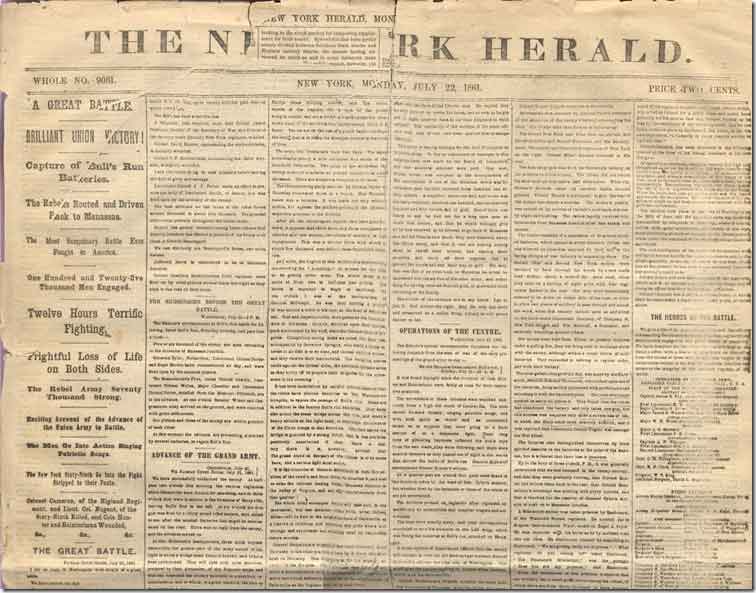
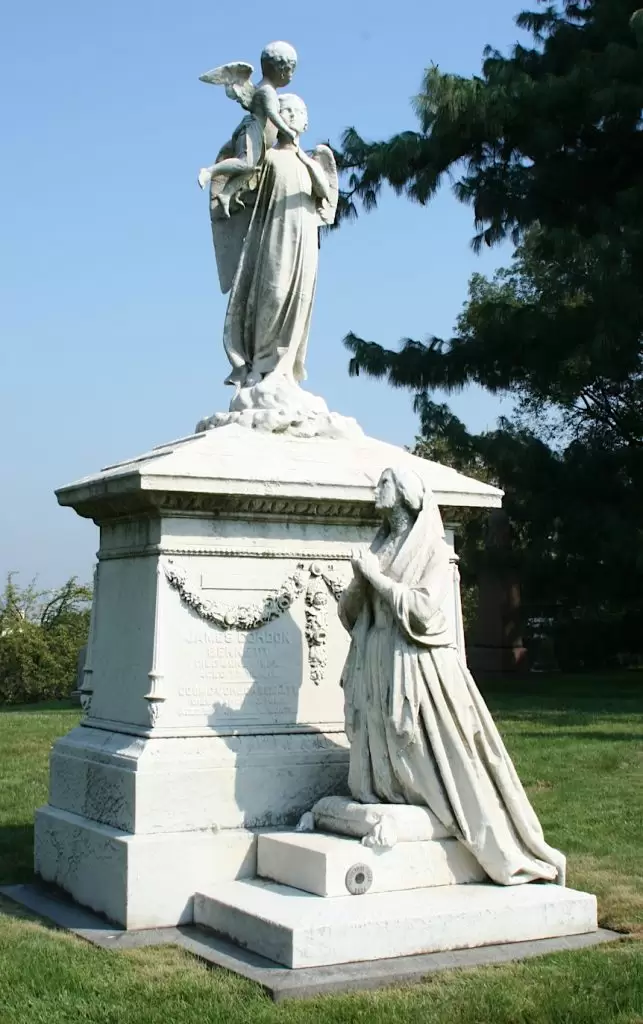
BENNETT, WILLIAM H. (1838-1919). Second lieutenant, 13th Regiment, New York State Militia, Company D; first sergeant, 145th New York Infantry, Company E. A native of Brooklyn, Bennett enlisted there on May 17, 1861, and was commissioned into Company D of the 13th Regiment. He mustered out with his company on August 6, 1861, at Brooklyn. He re-enlisted as a private at New York City on July 29, 1862, and mustered into the 145th New York on September 11. His muster roll notes that he was a clerk who was 5′ 7½” tall with brown hair and a light complexion. Bennett was promoted to sergeant on October 31, 1862. He was promoted to first sergeant on June 9, 1863, and mustered out on January 15, 1864, at Tullahoma, Tennessee.
Bennett applied for and received an invalid pension in 1886, certificate 1,085,455. (His pension index card notes that his rank in the 145th was corporal, not sergeant as indicated on his soldier record and muster roll.) The 1910 census reports that he was a widower living at 251 Arlington Avenue in Brooklyn who worked as a carpenter and could read and write. Bennett last lived at 54 Lincoln Place in Brooklyn. His death was attributed to pneumonia. Section 101, lot 5941, grave 3.
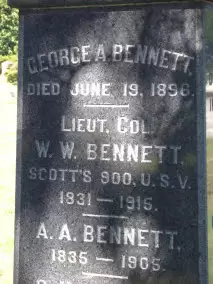
BENNETT, WILLIAM WINSLOW (1831-1915). Lieutenant colonel. 11th New York Cavalry, Company B. Born in New York City, his father was a piano manufacturer, and he joined him in that business. After enlisting as a captain at New York City on January 10, 1862, he was commissioned into Company B of the 11th New York Cavalry that day. That same year, he rose to major on April 1, but did not muster in that rank, and was promoted to lieutenant colonel on June 24. Subsequent to an intra-regimental transfer to the Field and Staff on November 30, he resigned a month later on December 24, 1862. His New York Times obituary notes that President Lincoln employed him for confidential work in the later years of the War.
In civilian life, Bennett returned to the piano business and was financed by Cornelius Vanderbilt in manufacturing the first automatic pianos and organs. He also wrote books on land taxation and was a member of the Edwin D. Morgan Post #307 of the G.A.R. His last address was 161 West 108th Street in Manhattan, where he died of senility at age 85. Section 152, lot 19006.
BENNETT, WINANT (or WYNANT) H. (1829-1901). Hospital steward, 90th New York Infantry, Companies F and K; private, 139th New York Infantry, Company G; 5th New York Cavalry, Company F. After enlisting as a private at his hometown, Brooklyn, on October 24, 1861, he immediately mustered into Company F of the 90th New York, and was transferred to Company K at some point. On November 21, 1861, he was promoted to hospital steward and joined the regiment’s Field and Staff. Bennett was discharged for disability on June 16, 1862, at Key West, Florida. Shortly thereafter he enlisted at Brooklyn as a private on August 22, 1862, and mustered into the 139th New York on September 9, and was discharged before he re-enlisted a month later as a private at New York City on October 18, mustered immediately into the 5th New York Cavalry, and mustered out on July 19, 1865, at Winchester, Virginia.
The Brooklyn Directory for 1888-1890 lists Bennett’s occupation as druggist. In 1892, his application for an invalid pension was approved, certificate 1,010,720. He last lived at 287 14th Street in Brooklyn. His death was attributed to diarrhea. Section 61, lot 181.
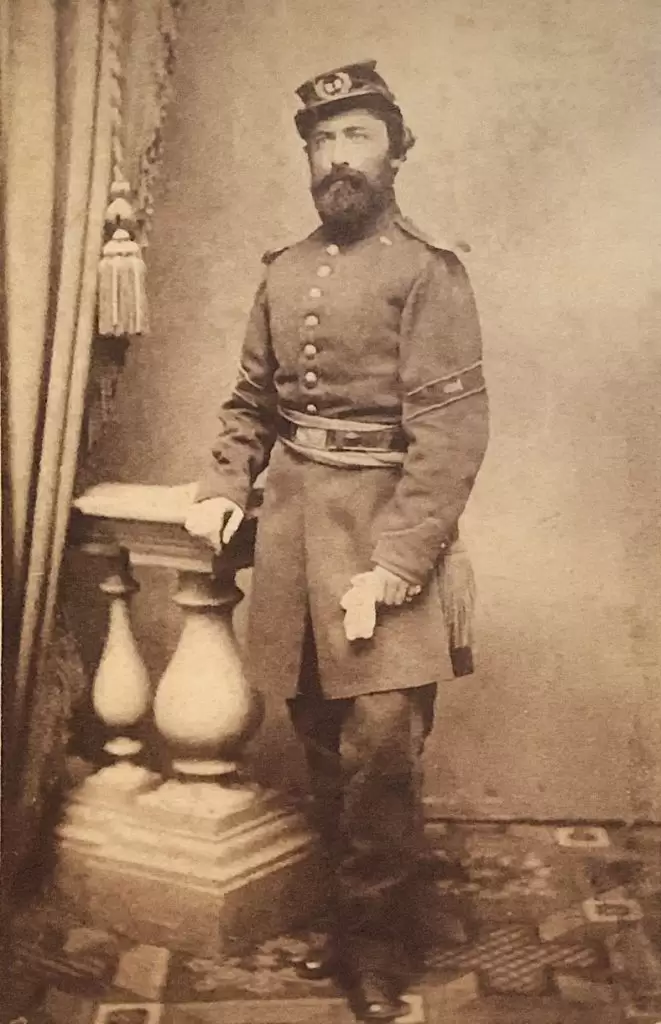
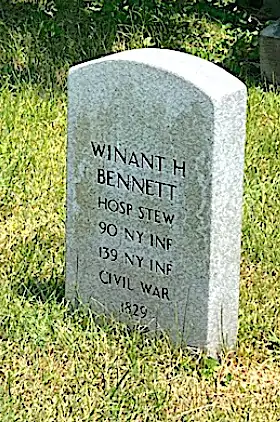
BENSEL, J. WARNER (or WARNER J.) (1831-1889). Corporal, 7th Regiment, New York State National Guard, Company A. Born in New York City, he enlisted there as a corporal on May 25, 1862, mustered into the 7th Regiment the same day, and mustered out after three months on September 5 at New York City. His last residence was 170 East 107th Street in Manhattan. He died from cancer. Sarah J. Bensel, who is interred with him, applied for and received a widow’s pension in 1893, certificate 393,613. Section 67, lot 1812.
BENSEL, WILLIAM P. (1818-1883). Captain, 7th Regiment, New York State Militia, Company A. At age 42, he began his first tour of duty after enlisting as a captain at New York City on April 17, 1861. Bensel was commissioned into the 7th Regiment on May 16 of that year, and mustered out the next month on June 3. He also served as a captain for 30 days with the same regiment and company (then part of the New York State National Guard) in June-July 1863, mustering out on July 20 of that year. The regiment, under the command of Colonel Marshall Lefferts (see), spent time in Baltimore and Frederick, Maryland.
As per the New York City Directory for 1875-1876, he was a cooper (barrel-maker) who lived at 52 Morton Street. Bensel died from tuberculosis. His last residence was 52 Morton Street in Manhattan. Section 117, lot 7492.
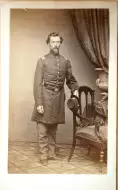
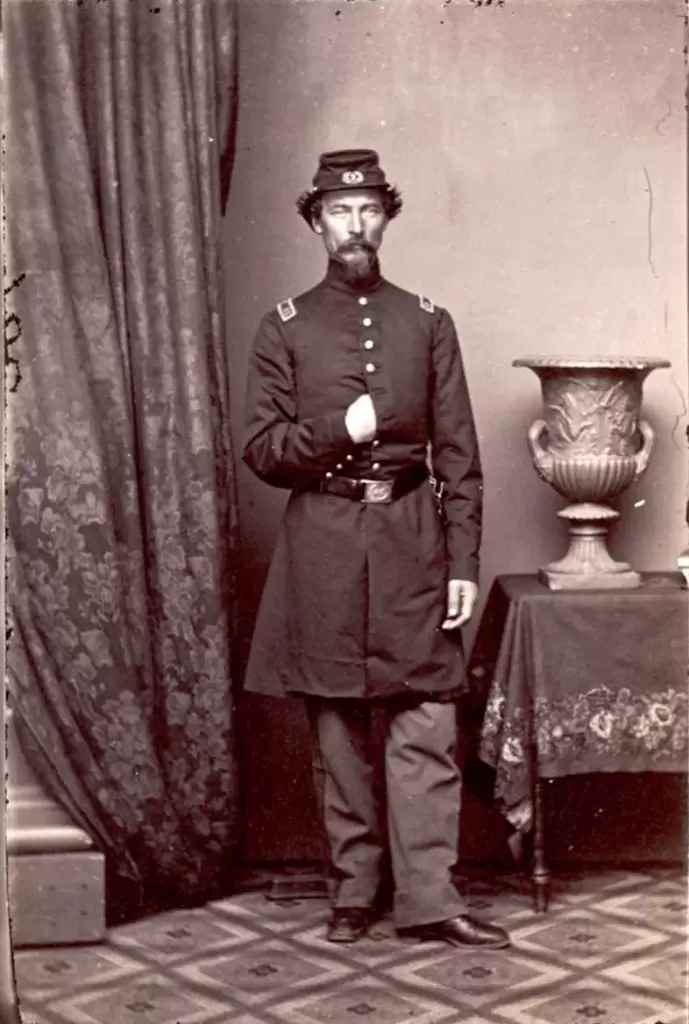
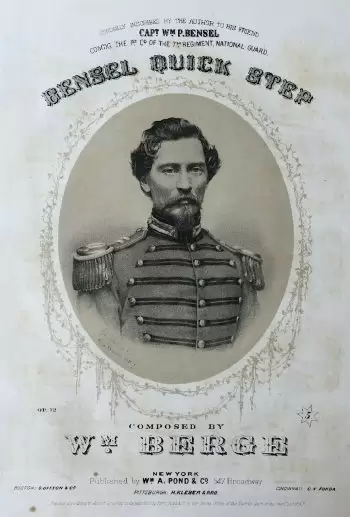
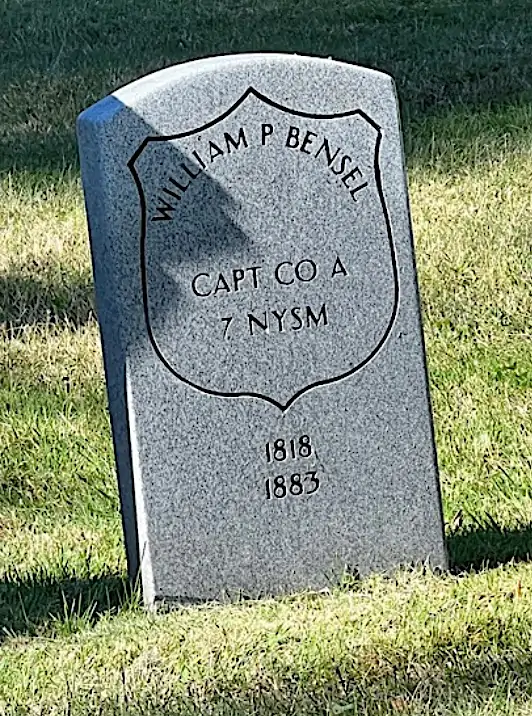
BENSON, FREDERICK SHEPARD (1838-1920). Captain by brevet; first lieutenant, 22nd Massachusetts Infantry; second lieutenant, United States Army Signal Corps. He was born in Boston, Massachusetts, to Frederick Augustus Benson and Lucy B. Churchill Benson. In 1855, as per the census of that state, he was living in Newton. An 1856 graduate of Harvard College, he came to New York City in 1857, but, according to the federal census of 1860, he was back in Newton and working as an artist.
As per Historical Data Systems, on October 8, 1861, he, an architect, enlisted as a sergeant major in the 22nd Massachusetts Infantry, and mustered in that date. The next year, he was promoted to second lieutenant, then first lieutenant. On March 3, 1863, he was transferred to the United States Army Signal Corps as a second lieutenant.
He married Charlotte Rockwood on January 3, 1865. Brevetted a captain on April 9, 1865, he mustered out in August of that year.
After the war, he was recorded in the 1870 census as still living in Newton and working on the United States Coast Guard Survey. However, he soon settled in Brooklyn (the 1875 New York State census records him as living there), where he became prominent in the gas manufacturing business, working as chief engineer for the Nassau Gas Light Company and Brooklyn Union Gas until his retirement in 1907. For many years he was president of the Society of Gas Lighting; he also was a district grand Mason and a member of the several veterans’ organizations, including the Society of the Army of the Potomac and the Military Order of the Loyal Legion.
His wife, Charlotte (“Lottie”), died in 1911; they had five children, and were survived by two daughters, a son, and five grandchildren. His last Brooklyn address was 79 Wilson Street. His obituaries referred to him as “Colonel Benson,” based on his service as lieutenant colonel of the 47th New York National Guard after the war.
According to the Atlantic Highlands Journal of New Jersey and Green-Wood’s records, he died of heat prostration and influenza at his summer home there. Section 154, lot 22046.
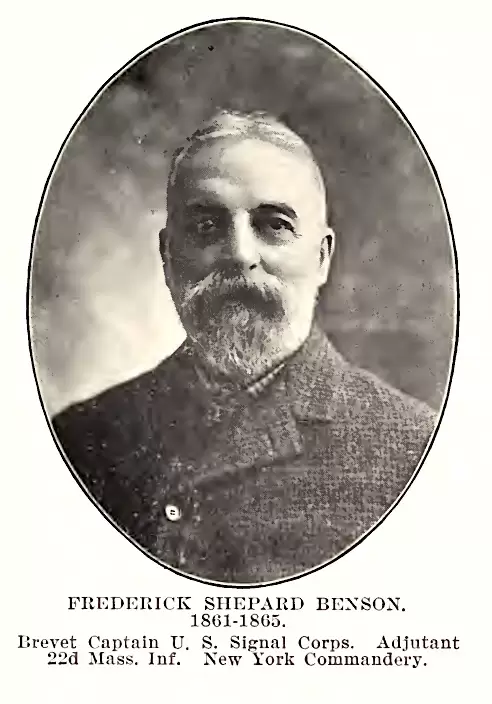
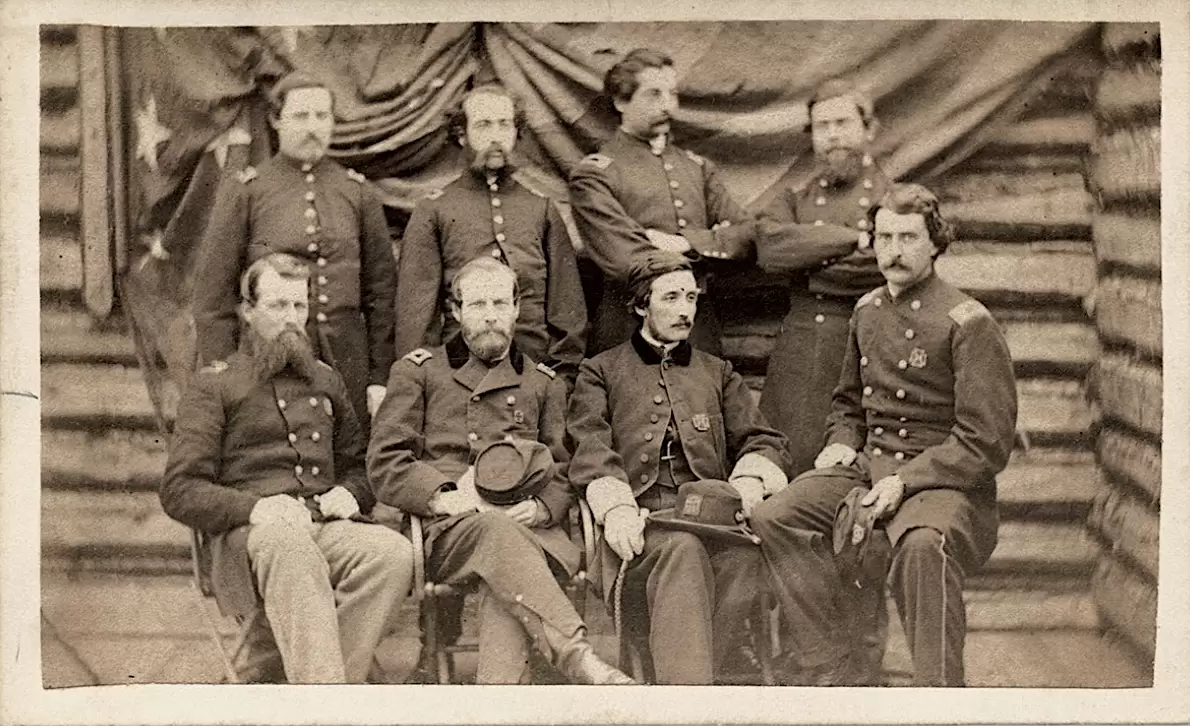
BENSON, JOHN H. (1845-1864). Private, 67th New York Infantry, Company I. A native New Yorker, he enlisted at Brooklyn on May 1, 1861, mustered into the 67th New York the next month on June 20, and was discharged for disability on November 22, 1863, at Yorktown, Virginia. He died of chronic diarrhea on May 1, 1864, at his residence in New York City. Section 115, lot 13536 (Soldiers’ Lot), grave 84.
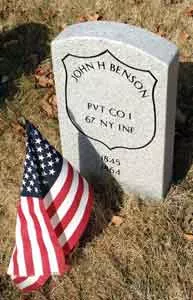
BENSON, MILO (1827-1892). Private, 5th New York Veteran Infantry, Company H. Born in Massachusetts, Benson enlisted as a private on February 23, 1865, at New York City, mustered into the 5th Veterans that day, and mustered out on August 21 at Hart’s Island, New York Harbor. In 1890, his application for an invalid pension was granted, certificate 634,939. He last lived at 62 Garden Street in Hoboken, New Jersey. His wife, Helen Benson, who is interred with him, applied for and received a widow’s pension in 1892, certificate 353,655. Section 200, lot 26925.
